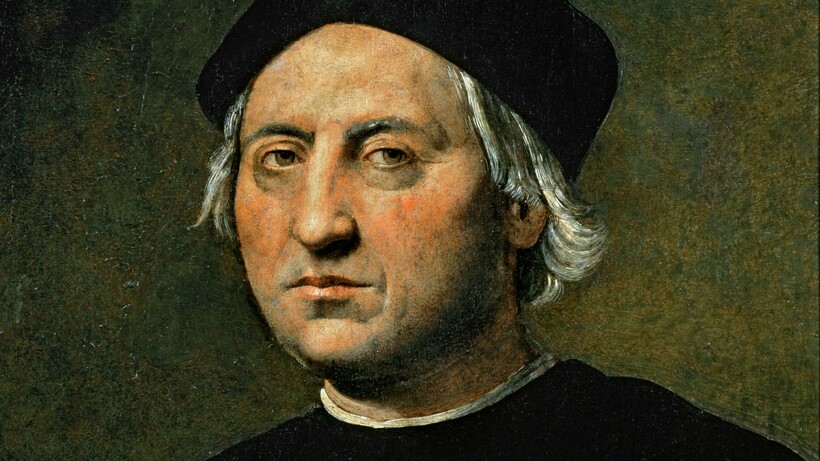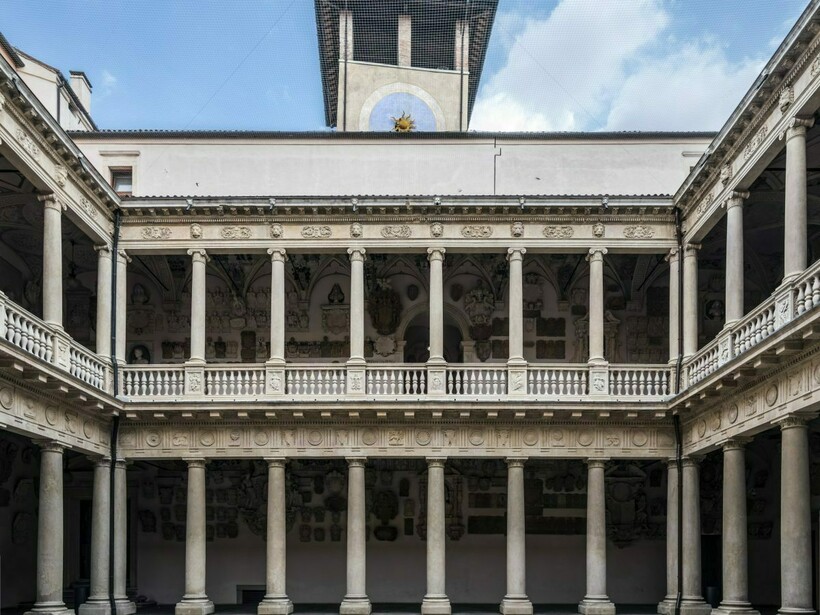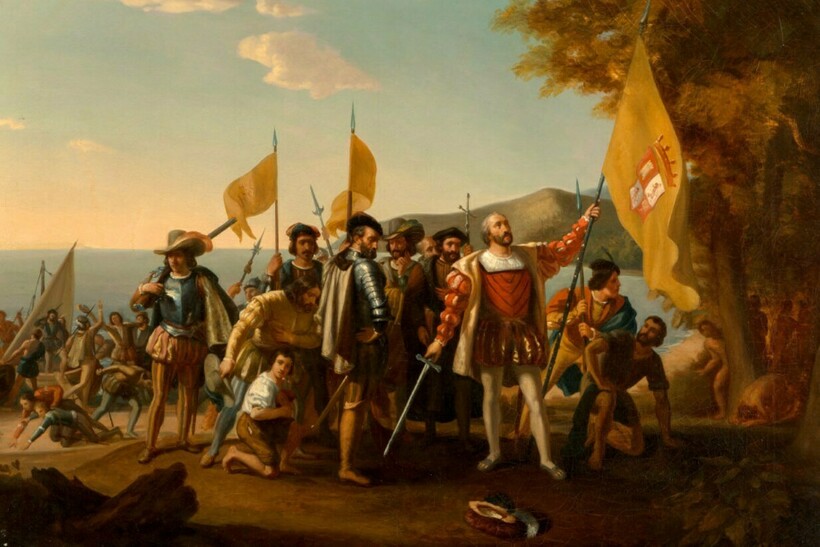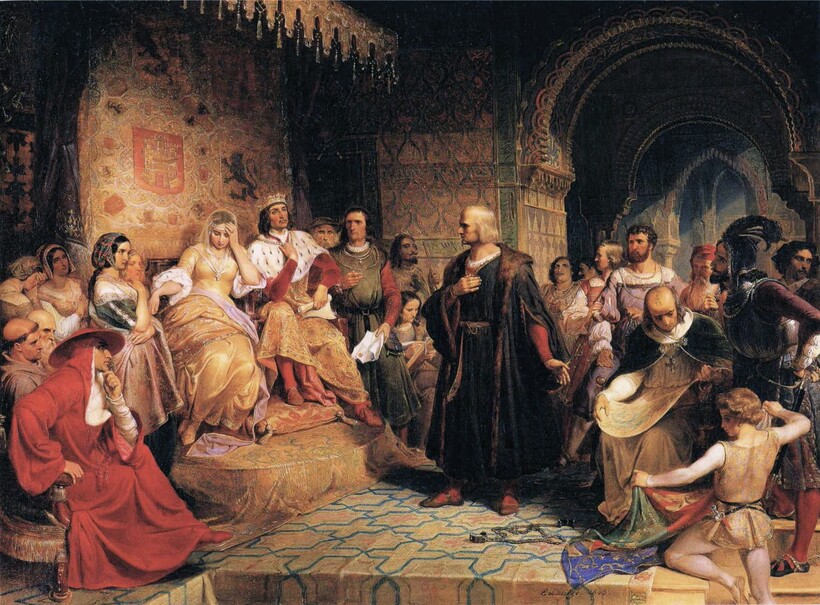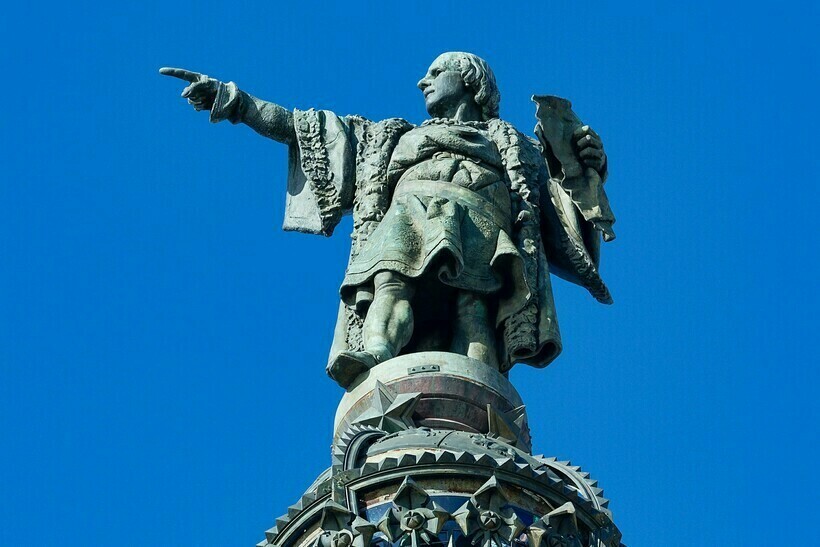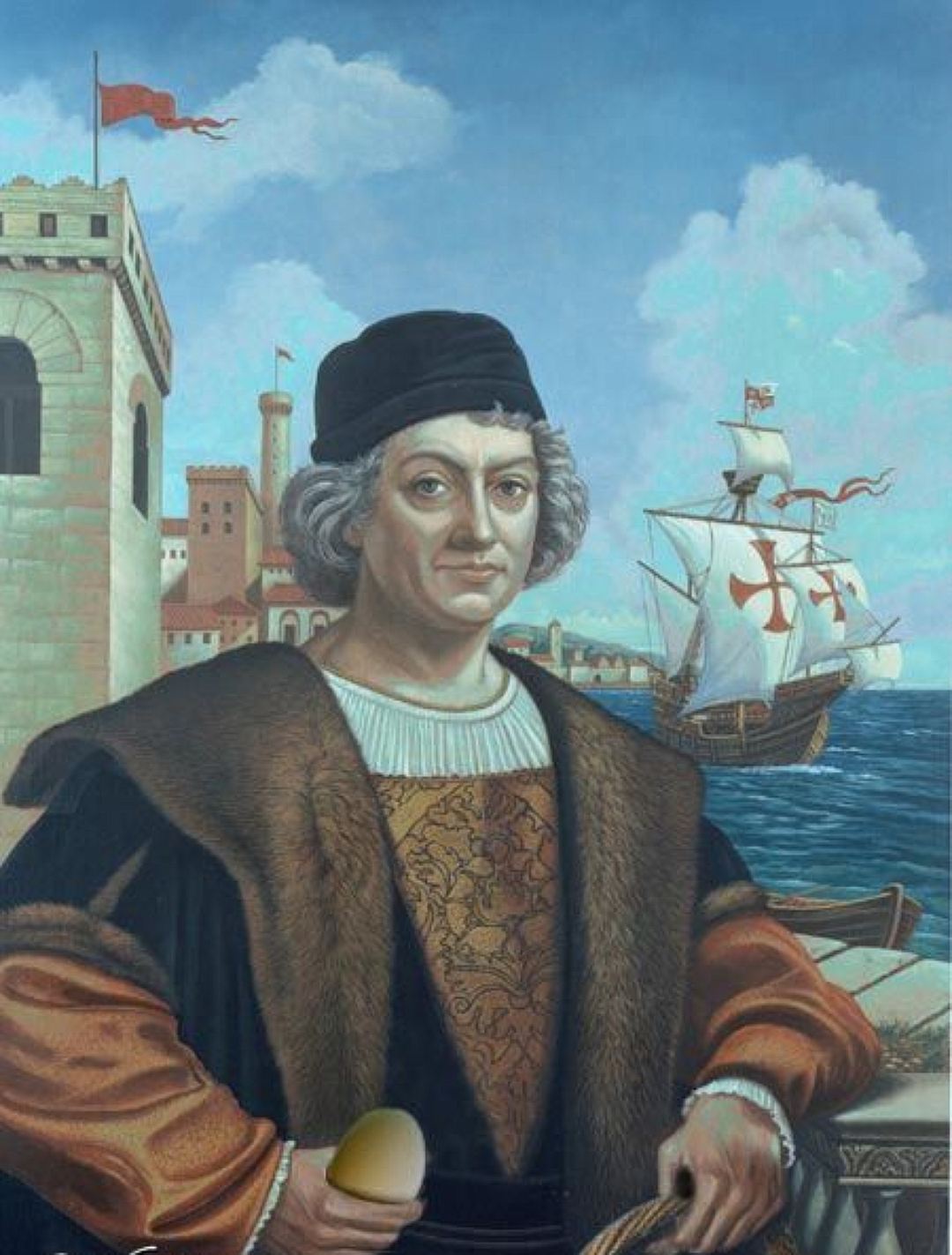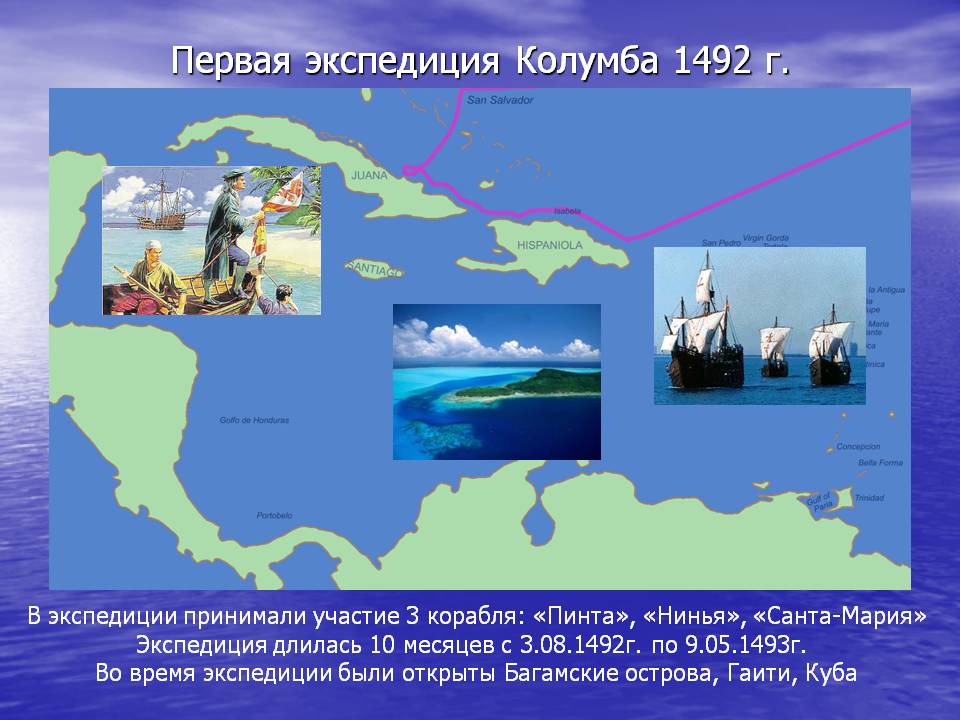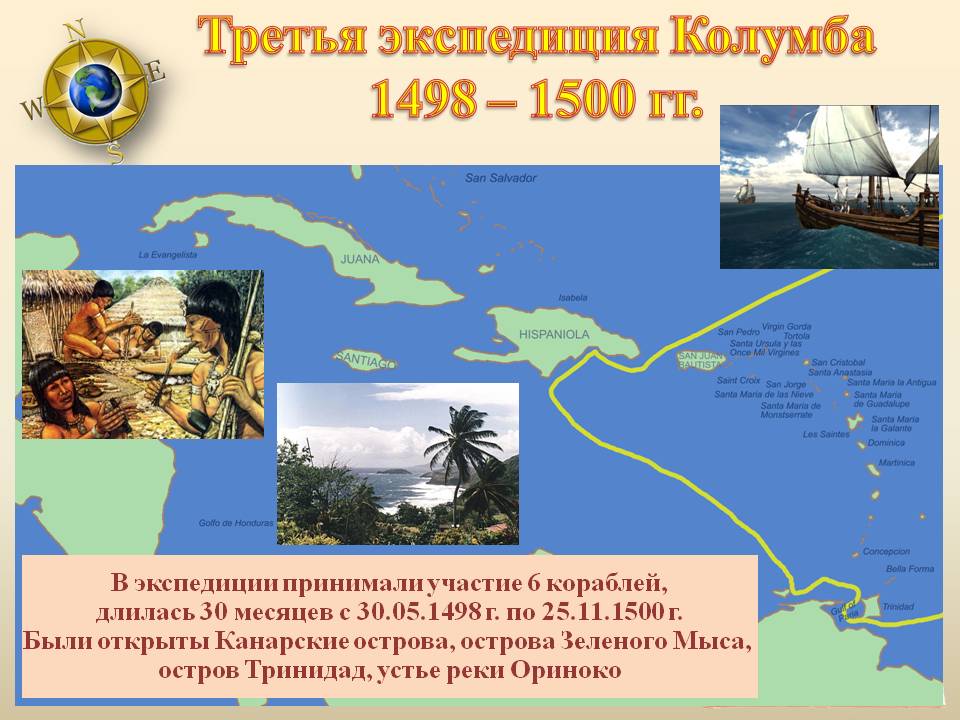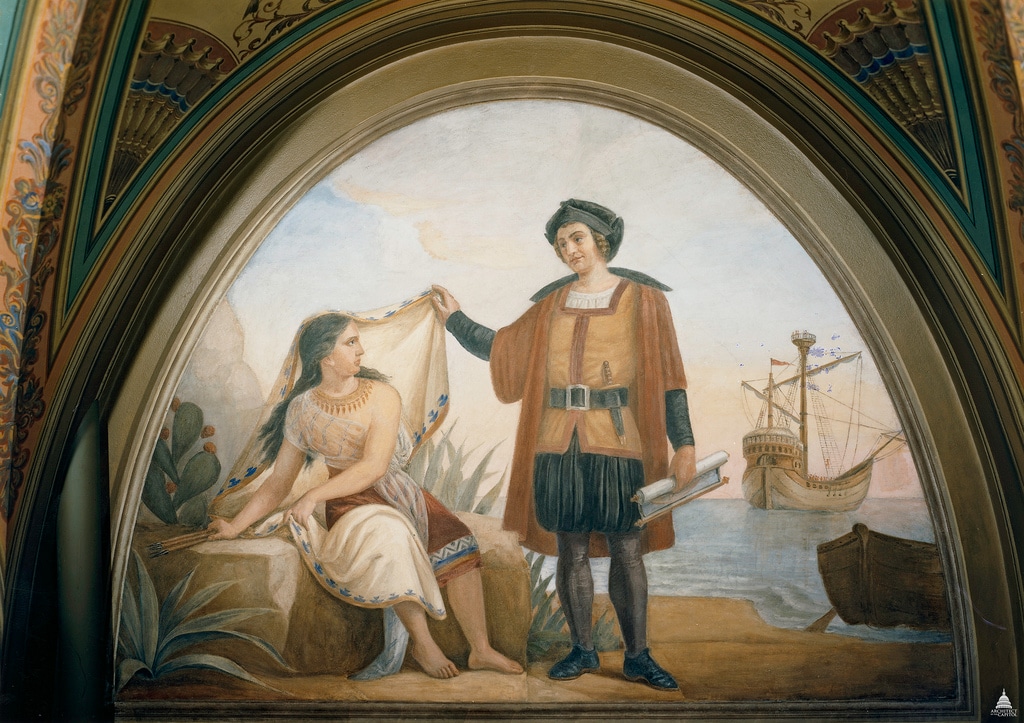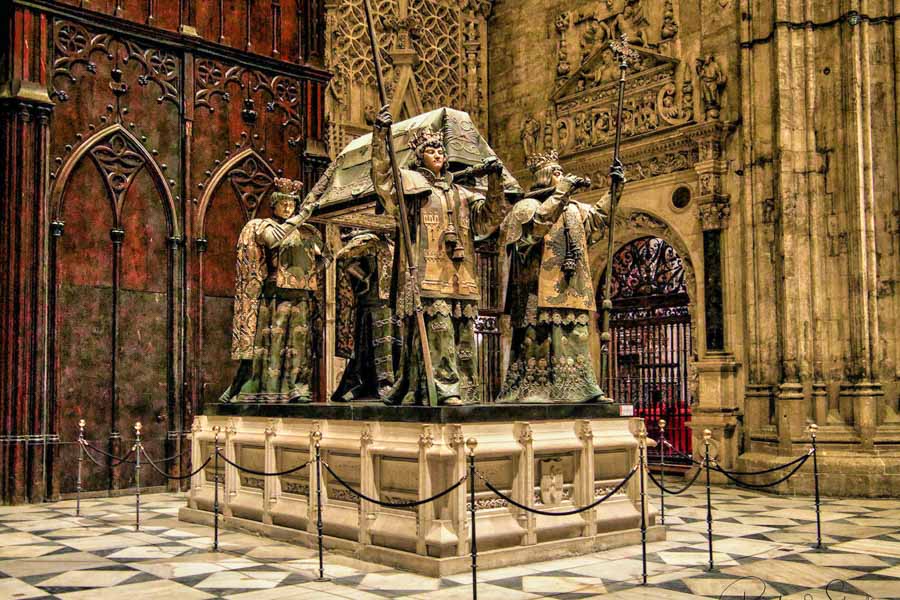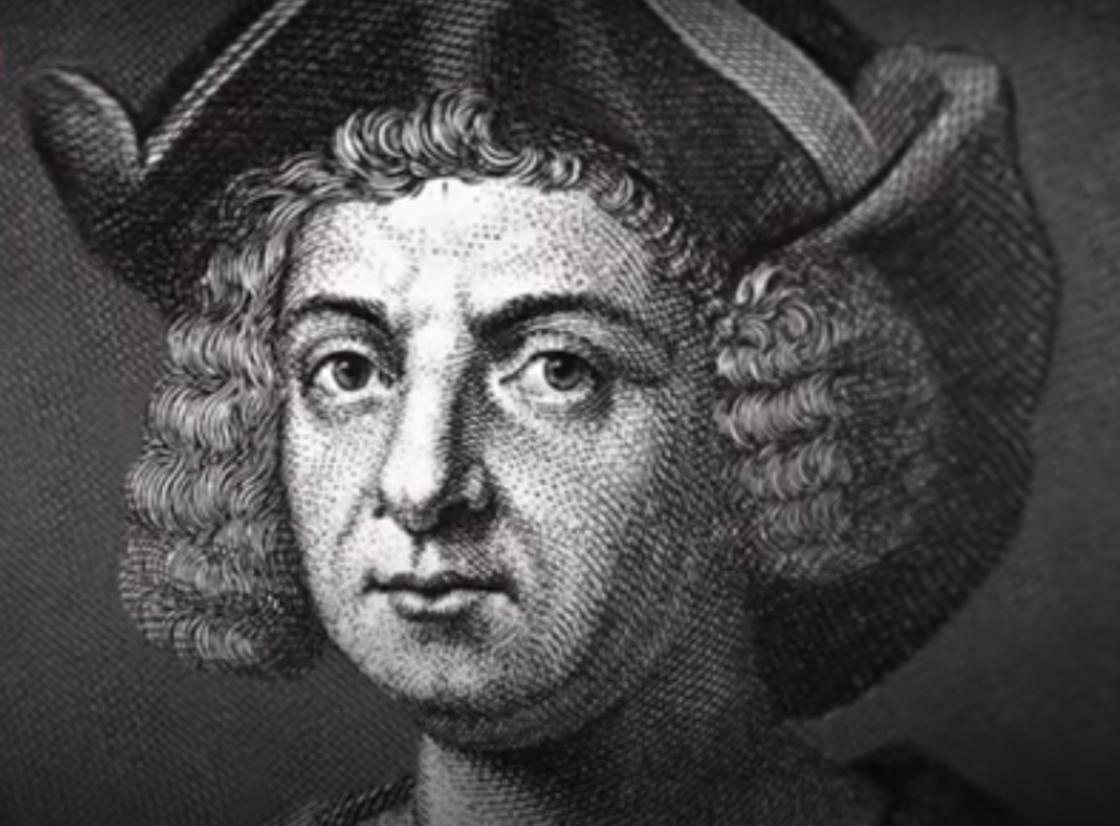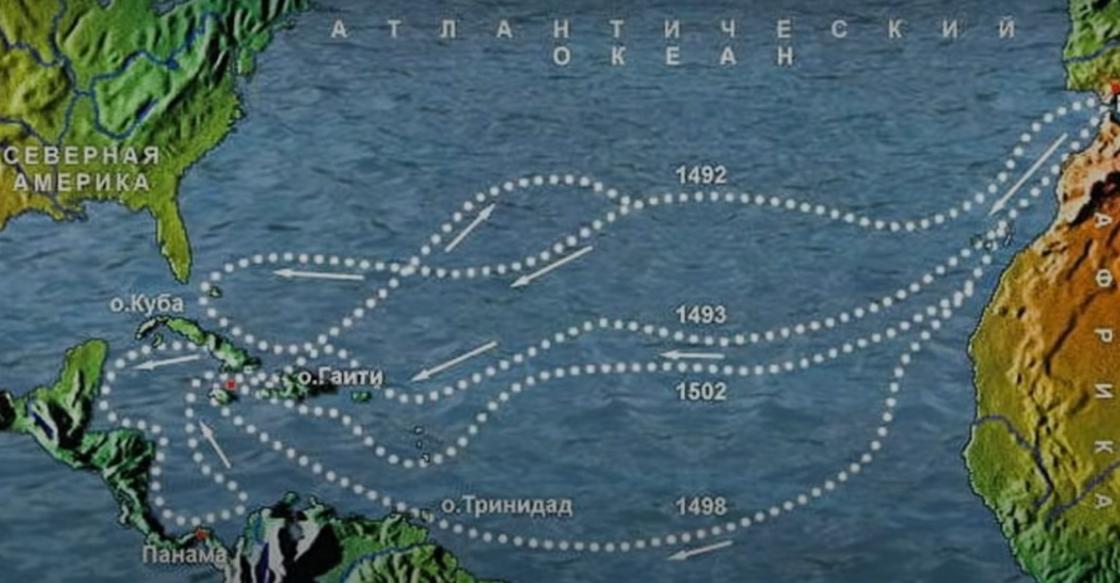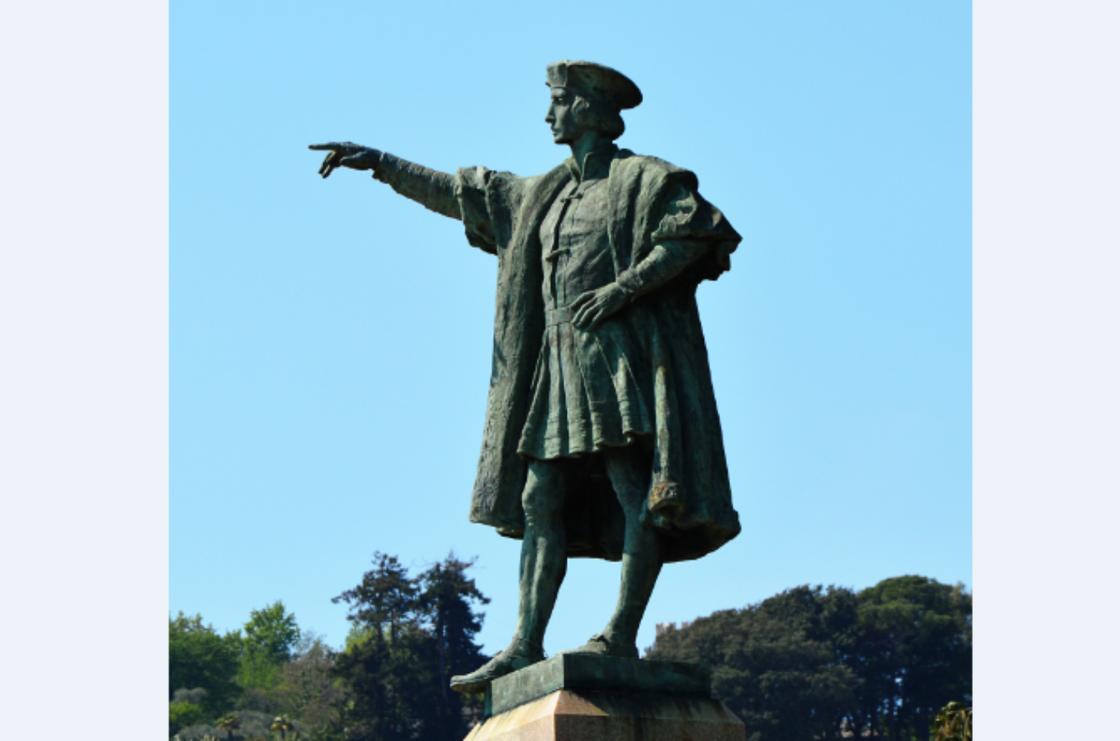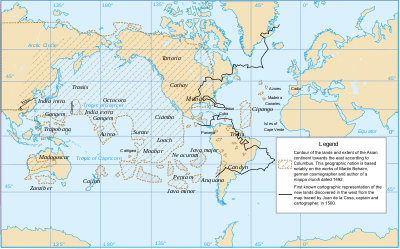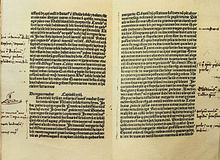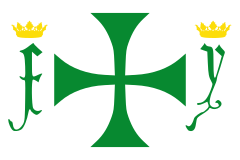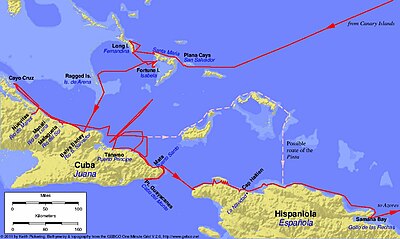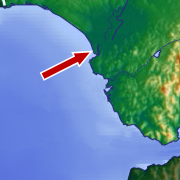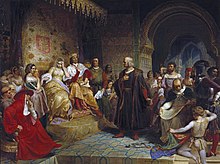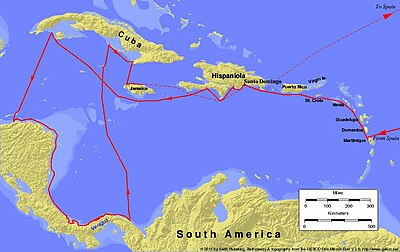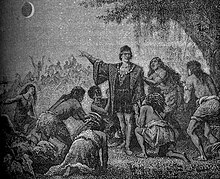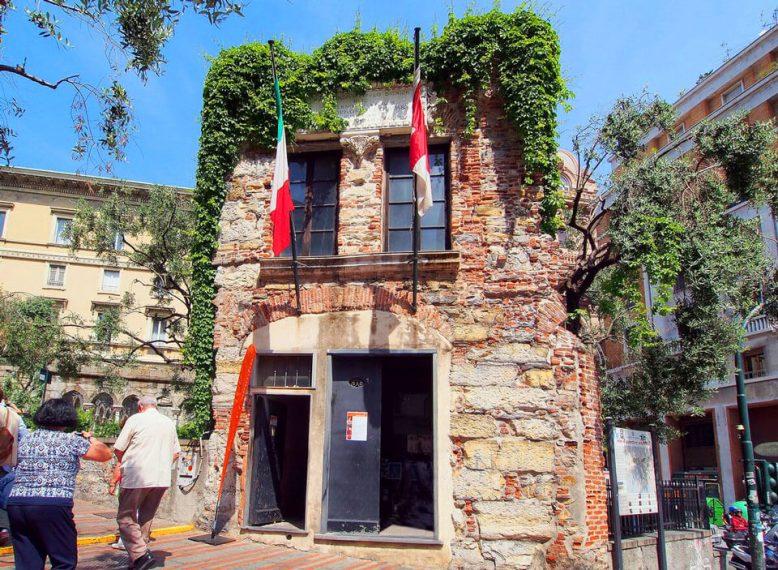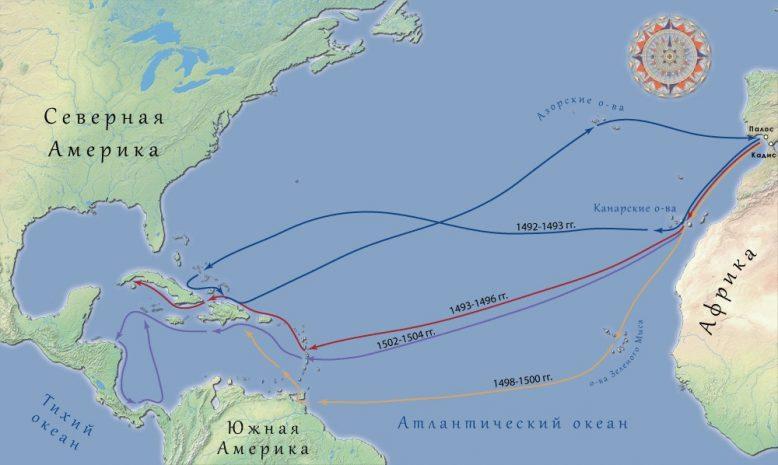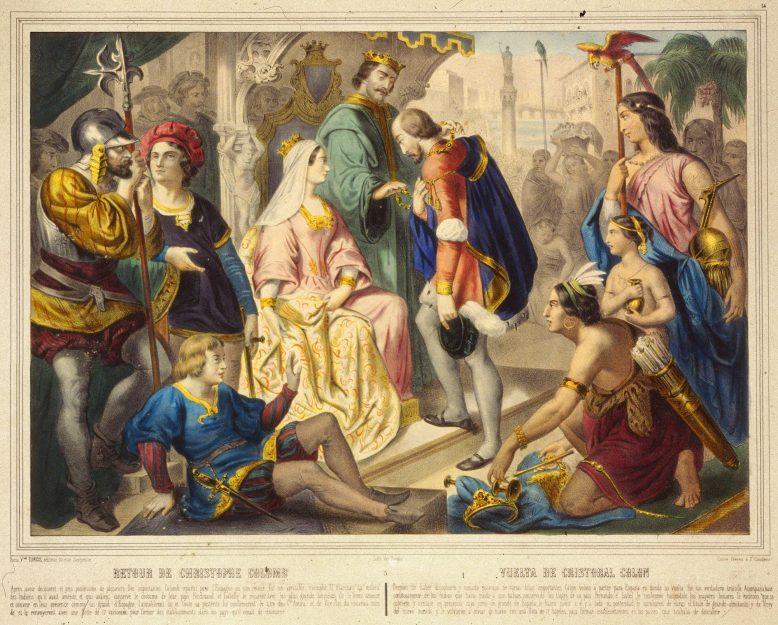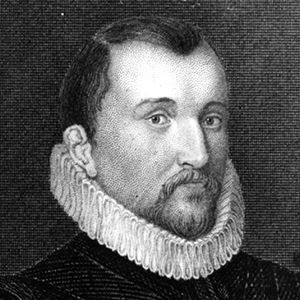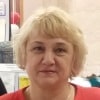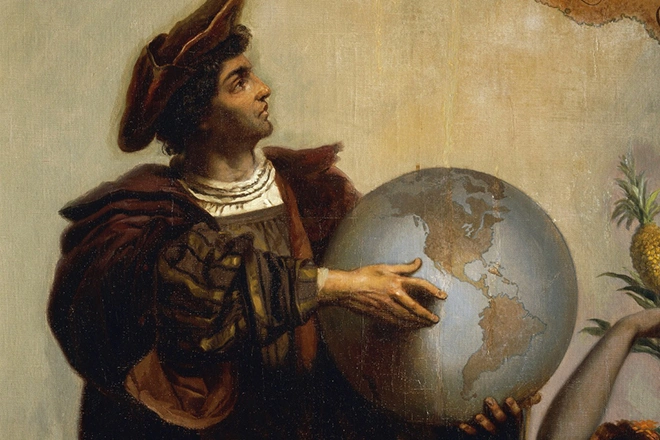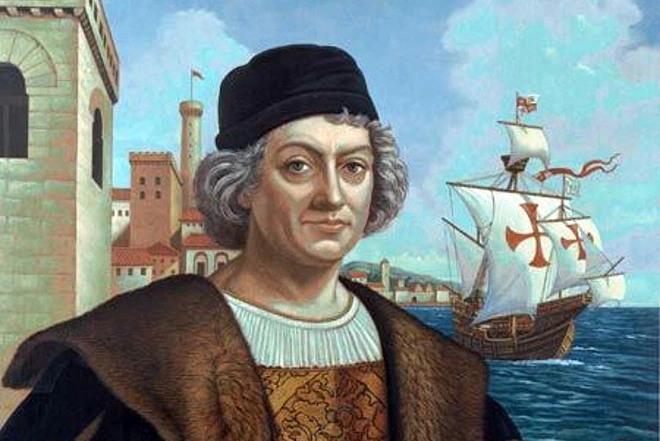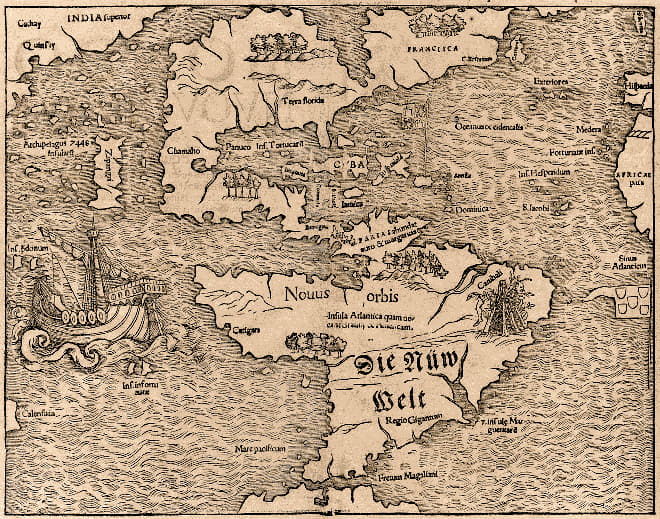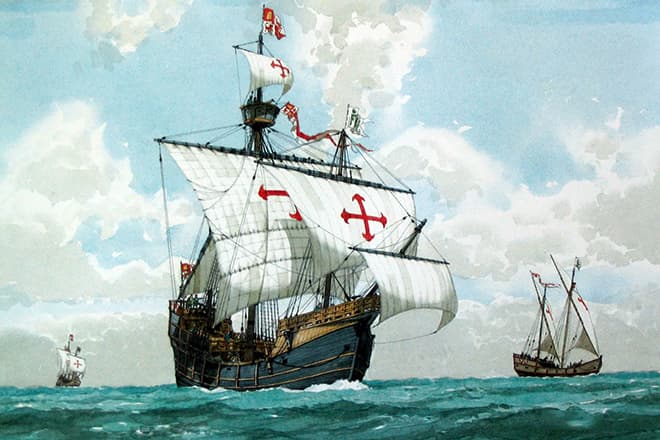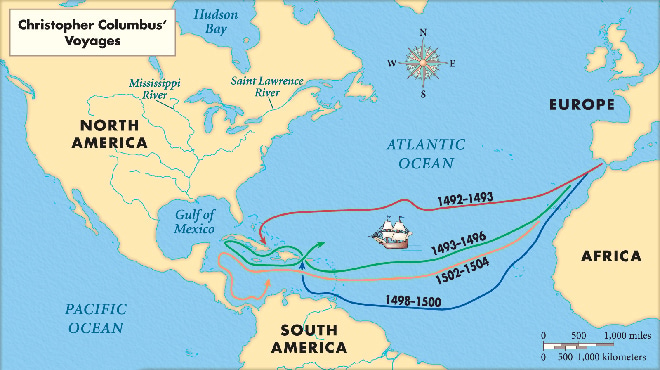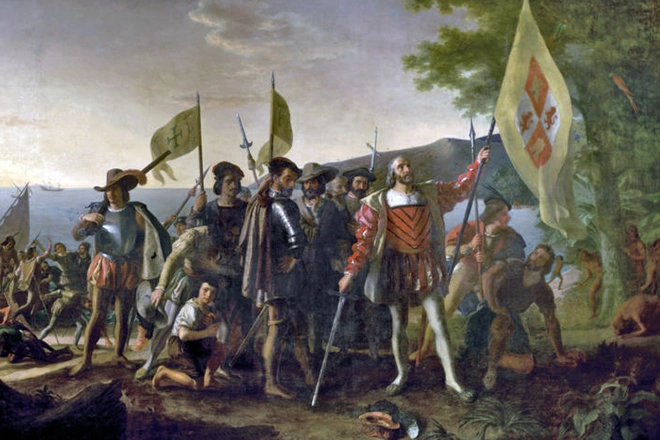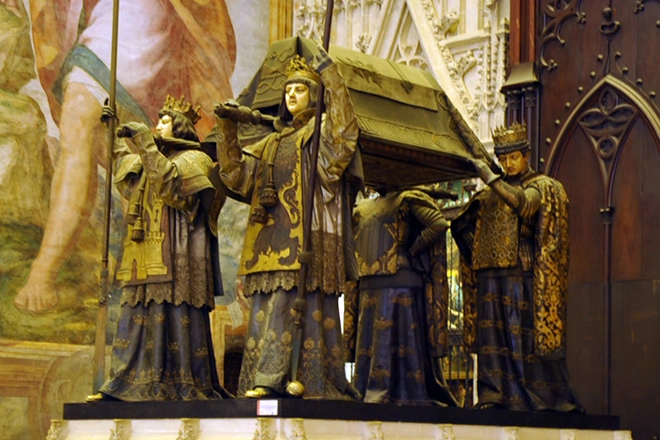Христофор Колумб
Краткая биография
Выдающийся мореход и флотоводец, первооткрыватель Америки Христофор Колумб родился в 1451 г. в небогатой католической семье по одной из версий – в Генуе, по другим – на островах Мальорка или Корсика. На итальянском языке его фамилия звучит – Коломбо, на испанском – Колон.
Р. Гирландайо. Посмертный портрет Христофора Колумба. Около 1520 г.
О юности Колумба сохранилось мало сведений, однако известно, что он говорил на четырех языках: итальянском, испанском, португальском и латинском. Несколько лет Колумб плавал на итальянских морских торговых судах, побывал на Британских островах, в Ирландии, Исландии, на западном побережье Африки. Однако главным делом его жизни можно считать четыре путешествия к берегам Америки: первое (1492–1493), второе (1493–1496), третье (1498–1500) и четвертое (1502–1504). Умер Колумб 20 мая 1506 г. и был похоронен в Севилье.
Величайшая ошибка, которая привела к величайшему открытию
К концу XV в. многих европейцев: монархов, купцов, банкиров и мореплавателей занимал вопрос о том, как можно достичь богатой пряностями и сокровищами Индии по морю. Сухопутный путь был труден и небезопасен. В то время идеи о шарообразности Земли становились все более популярными и многие всерьез задумывались над тем, что до индийских берегов можно доплыть не только восточным путем, обогнув Африку, но и западным – преодолев воды Атлантического океана. Христофор Колумб не был исключением. Получив совет флорентийского ученого (географа и астронома) Паолло дель Поццо Тосканелли, Колумб задумал предпринять такое дерзкое путешествие. В новых землях он мечтал найти жемчуг, драгоценные камни, золото, серебро и пряности. О размерах материков и океанов в XV в. еще не было точных сведений, поэтому ученый предполагал, что до азиатских берегов кораблям понадобится пройти около 5 тыс. км.
Герб Х. Колумба (Колона), пожалованный ему испанскими монархами за особые заслуги перед государством. В верхней части герба изображены замок и лев — символы королевства Кастилии и Леона. Внизу — очертания открытых Колумбом новых земель в Центральной Америке, а также якоря, символизирующие адмиральское звание. Вместе с гербом Колумбу был пожалован девиз «Кастилии и Леону новый мир был дан Колоном»
Прощание Колумба с испанскими монархами — Фердинандом и Изабеллой. Гравюра XIX в.
Колумб посвятил в свои планы сначала генуэзских купцов, затем португальского короля Жуана II, но не нашел у них поддержки. Тогда он обратился к испанской королеве Изабелле – она отказалась финансировать это сомнительное предприятие. В 1491 г. Колумбу удалось заинтересовать своим проектом испанских королевских финансистов, была созвана комиссия, но и она отвергла смелый проект, да и требования Колумба были признаны чрезмерными. В отчаянии он принял решение уехать во Францию, однако был возвращен с дороги – проект приняли. Испанские монархи (Фердинанд и Изабелла) пожаловали Колумбу и его наследникам дворянский титул «дон», произвели его в адмиралы и назначили своим вице-королем и главным правителем всех островов и материков, которые он лично откроет или приобретет. Колумбу была обещана десятая доля чистого дохода с новых земель и право разбора уголовных и гражданских дел. Экспедицию щедро финансировали испанские банкиры.
Колумб снарядил три корабля, названные «Санта-Мария», «Пинта» и «Нинья»; набрал команду – 90 человек. 3 августа 1492 г. корабли покинули Палос и взяли курс на Канарские острова, а оттуда, после короткой остановки, на запад. Путешествие оказалось неожиданно долгим, на кораблях назревал бунт, но наконец (через 33 дня) 12 октября 1492 г. матрос с «Пинты» увидел землю. Это был большой остров из архипелага Багамских островов, его жители – араваки – приветливо встретили испанцев, подплывали на лодках к их кораблям и обменивали свои вещи.
Дж. Вандерлин. Высадка Колумба на Гуанахани в 1492 г. Картина 1847 г.
Колумб со свитой высадился на берег и водрузил на острове знамя Кастилии, теперь он был адмиралом и вице-королем этих земель. Индейцы называли свой остров Гуанахани, адмирал дал ему христианское имя Сан-Сальвадор – «Святой спаситель» (в наши дни это остров Самана). Две недели испанцы обходили один за другим острова архипелага в поисках золота и пряностей, но ни того, ни другого там не оказалось. Однако у их жителей моряки увидели пластинки и слитки золота, которые те иногда меняли на стеклянные и глиняные черепки. Наконец флотилия достигла побережья очень крупного острова (Кубы), которое Колумб принял за один из полуостровов Восточной Азии. Его обитатели возделывали незнакомые европейцам растения: кукурузу, картофель, табак; лишь хлопок не удивил испанцев.
«Они шли с крестом в руке и с ненасытной жаждой золота в сердце». Бартоломео Лас Касас, испанский священник
25 декабря у берегов крупного острова «Санта-Мария» села на рифы. Колумб назвал его Эспаньола (совр. Гаити) и решил именно здесь основать первое европейское поселение. Из обломков корабля он приказал построить форт и дал ему имя Навидад (Рождество). Здесь добровольно остались 39 моряков, они надеялись больше разузнать о новых землях и найти много золота. Колумб снабдил их припасами на год, а сам на двух кораблях поспешил в Испанию. В середине февраля они добрались до Азорских островов, а 15 марта 1493 г. прибыли в Палос. Так завершилось первое путешествие Колумба.
Маршрут первой экспедиции Христофора Колумба в 1492-1493 гг.
Он привез в Испанию весть об открытых им на западе землях, немного золота, несколько невиданных еще в Европе островитян, которых стали называть индейцами, странные растения, плоды и перья диковинных птиц. Известие об открытии испанцами западного пути в Индию быстро облетело европейские страны. Римский папа предоставил Кастилии права на земли, которые она открыла в западных частях океана (к западу от островов Зеленого Мыса), тогда как за португальцами оставалось право на восточные земли. Колумб считал открытые земли Восточной Азией, поэтому европейцы стали именовать их Вест-Индией (Западной Индией), собственно Индия и Индонезия назывались в Европе Ост-Индией (Восточной Индией).
Обрадованные известием о новых обширных и богатых землях за океаном, принадлежащих теперь испанской короне, Фердинанд и Изабелла снарядили новую экспедицию к берегам Вест-Индии. Она состояла из 17 кораблей, флагманский парусник «Мария-Галанте» возглавлял Колумб. Экспедиция вышла из Кадиса 25 сентября 1493 г. Она доставила на Эспаньолу крупный рогатый скот, собак, виноградную лозу и семена сельскохозяйственных растений.
В опасное путешествие вместе с Колумбом отправились около 2 тыс. человек: идальго, придворные, монахи, священники и конечно моряки. Путь флотилии на этот раз проходил на 10° южнее, и, подгоняемые попутным северо-восточным пассатом, они через 20 дней достигли Малых Антильских островов. Это были Доминика, Гваделупа, Монтсеррат, Антигуа, Санта-Крус, Виргинские, Пуэрто-Рико и другие острова. Здесь жили воинственные карибы, которые на лодках, выдолбленных из одного ствола дерева, с луками и стрелами совершали набеги на мирных араваков, грабили, убивали их, увозили с собой женщин и возможно даже были людоедами.
Колумб на Эспаньоле. Раскрашенная гравюра. 1886 г.
Прибыв на Эспаньолу, испанцы обнаружили разрушенный, сожженный форт и останки моряков. Выяснилось, что колонисты грабили индейцев, уводили их жен, и взбунтовавшиеся араваки расправились с ними. К востоку от неудачного поселения Колумб основал новый город и дал ему имя Изабелла. В глубь острова отправилась экспедиция под руководством Алонсо Охеды, она обнаружила крупные поселения араваков, а также золотые россыпи у подножия гор (речной песок, содержащий золото). Тем временем в жарком климате запасы еды портились, содержать сотни колонистов на Эспаньоле стало невозможно, и Колумб принял решение отправить большую часть людей на 12 кораблях обратно в Испанию. С ними он передал испанским монархам «Памятную записку», в которой сообщал о найденных месторождениях золота и «следах пряностей». Он просил прислать скот, продукты, земледельческие орудия, а взамен предлагал индейцев, обращенных в рабство.
Дж. Г. Стедман. Женщина из племени араваков. 1818 г.
На гравюре изображены туземцы с островов Карибского моря. XV в.
В надежде открыть материковую часть Индии весной 1494 г. Колумб предпринял экспедицию на запад от Изабеллы. Обогнув юго-восточный берег Кубы, он достиг Сантьяго (Ямайки). Пройдя вдоль кубинских берегов более 1500 км, Колумб был уверен, что открыл берега нового континента.
Под руководством брата Колумба Бартоломео из Испании пришли три корабля с войском и провизией. Вновь прибывшие солдаты начали грабежи и насилия и были убиты индейцами, тогда Колумб предпринял военный поход в глубь острова. Его отряд из 200 солдат с лошадьми и собаками с немыслимой жестокостью убивал индейцев сотнями. Через девять месяцев Эспаньола была полностью покорена, оставшихся в живых индейцев Колумб обложил непосильной данью. Многие из них тысячами умирали от неизвестных, завезенных европейцами болезней или тяжелейшей работы на плантациях и золотых приисках. В 1496 г. Бартоломео Колумб заложил на южном берегу Эспаньолы новый город Санто-Доминго.
Резная каменная статуэтка «Старого бога» сапотекской цивилизации доколумбовой Америки. Монте-Альбан. Мексика. XIII–XV вв.
Золотая маска бога Шипе-Тотека. Из сокровищницы сапотекской цивилизации. Монте-Альбан. Мексика. XIII– XV вв.
Испанские монархи тем временем посчитали, что доходы, получаемые от новых земель, незначительны по сравнению с расходами на снаряжение экспедиций и содержание новых поселений, и решили расторгнуть договор с Колумбом. В 1495 г. они издали указ, разрешающий всем подданным Кастилии снаряжать экспедиции на запад для открытия новых земель и переселяться туда с условием, что две трети добытого золота будут отданы в испанскую казну. Взбешенный Колумб срочно вернулся в Испанию – так закончилось его второе путешествие. Он убеждал Изабеллу и Фердинанда, что достиг азиатского материка и что обнаружил во внутренних районах Эспаньолы загадочную страну Офир, откуда библейский царь Соломон получал золото. Колумб предложил в качестве новых поселенцев отправлять на Эспаньолу преступников, сократив им срок наказания. Ему поверили и на этот раз.
Епископ Б. Лас Касас в памфлете «Кратчайший рассказ о разрушении Западной Индии» с гневом писал о зверствах своих соотечественников: «Христиане своими конями, мечами и копьями стали учинять побоища среди индейцев и творить чрезвычайные жестокости. Вступая в селение, они не оставляли в живых никого – участи этой подвергался и стар и млад».
Весной 1498 г. Колумб снарядил третью экспедицию. Шесть кораблей 30 мая вышли из устья Гвадалквивира и взяли курс на юго-запад. Они достигли острова Тринидад и впервые увидели очертания побережья южноамериканского континента. Остановившись в дельте реки Ориноко, Колумб обнаружил, что вода в заливе пресная. Это могло быть только в том случае, если река протекала по обширному континенту. К испанским кораблям подходили на каноэ аборигены, у многих на груди были крупные украшения из золота и жемчуга. Открытые земли (около 400 км побережья) Колумб назвал «Земля Пария».
Карта Карибских островов и полуострова Флорида. Раскрашенная гравюра. XVI в.
В начале августа Адмирал тяжело заболел и приказал взять курс на Эспаньолу. Флотилия двинулась на север мимо островов Лос-Тестигос («Свидетели») и Маргарита («Жемчужная»). В Санто-Доминго тем временем против наместников Колумба восстали идальго. Жестоко эксплуатируя индейцев, издеваясь и убивая их сотнями, испанские завоеватели требовали еще большего. Колумбу пришлось согласиться на их условия – каждому идальго был выделен участок земли и индейцы для его обработки. За побег полагалось рабство или смерть. Продолжалось невиданное истребление коренных жителей острова.
Новая колония стала обузой для испанских монархов. Стало понятно, что открытая Колумбом земля не принесет сказочных богатств, и это не Индия. Адмирала начали обвинять в обмане и присвоении королевских доходов. Прибывший на Эспаньолу в 1500 г. Ф. Бовадилья арестовал Колумба и его братьев и в кандалах отправил их в Испанию. И хотя короли освободили Колумба, он был разжалован, унижен и оскорблен. Так закончилось его третье путешествие.
Т. де Бри. Арест Христофора Колумба. XVI в.
Колумб в цепях. Раскрашенная гравюра. 1875 г.
Р. Балака. Колумб перед испанской королевской четой. 1874 г.
Но все же Христофор Колумб не сдавался. В 1502 г. он предпринял еще одну попытку найти западный путь в Индию, теперь уже от открытых им новых земель. Колумб не имел представления о величине Тихого океана и надеялся, что, двигаясь на запад, достигнет через некоторое время берегов Восточной Азии. Четыре корабля с командой из 150 человек вышли в Атлантику 3 апреля. Минуя Малые Антильские острова, Колумб открыл остров Мартиника, остановился ненадолго на Эспаньоле, а затем двинулся на запад. Вскоре корабли подошли к берегам нового континента, это был полуостров Юкатан – земля индейцев племени майя.
Испанцы встретили индейцев, стоящих на гораздо более высокой ступени развития, чем жители Антильских островов. У них были цветные ткани и одежда, бронзовые топоры и колокольчики, бронзовая и деревянная посуда, деревянные мечи с острыми кремнями и бобы какао, которые они использовали в качестве денег. Но золота у них не было, и флотилия продолжила свой путь на восток, а затем на юг вдоль берегов Центральной Америки. Индейцы встречали испанцев дружелюбно, от них Колумб узнал, что к югу находится богатая страна, а за высокими горами – другое море (открытый позднее Тихий океан), но экспедиция, отправленная в глубь материка, не дошла до него. Шли дожди, корабли обветшали и начали гнить, два из них бросили, собрав команду на двух каравеллах, а Колумб продолжал искать пролив в западное море. Он прошел 2200 км, но все же вынужден был повернуть на север, к Ямайке. Потерпев кораблекрушение у ее берегов 25 июня 1503 г., команда и Колумб целый год дожидались помощи с Эспаньолы. Наконец оттуда пришло судно, снаряженное на деньги Колумба. Тяжелобольной капитан и измученные моряки добрались сначала до Эспаньолы, а затем вернулись в Испанию. Так закончилось четвертое плавание к берегам Вест-Индии.
Могила Колумба в кафедральном соборе Севильи. Испания
Вклад в географию
Христофор Колумб первым из европейцев пересек Атлантику в тропических широтах Северного полушария, он открыл побережье Южной и Центральной Америки, Большие Антильские и часть Малых Антильских и Багамских островов, остров Тринидад и несколько мелких островов в Карибском море.
По выражению французского географа XVIII в. Жана Анвиля, это была «величайшая ошибка, которая привела к величайшему открытию».
Поделиться ссылкой
Христофор Колумб — это человек-легенда, знаменитый мореплаватель, флотоводец и картограф, открывший новый континент. В поисках морского пути в Индию он первым достиг берегов Америки. Его огромная трагедия в том, что до конца своих дней он даже не догадывался, что совершил величайшее открытие.
Биография Колумба
Точная дата рождения Христофора Колумба или, в испанском звучании, Кристобаля Коломбо не установлена. Известно только, что она приходится на период с 25 августа до октября 1451 года. В эти осенние дни в семье Доминико Коломбо и его жены Сусанны появился первенец. Проживали они в тот период в Генуе. Однако место рождения Колумба, как и дата, до сих пор остается предметом разногласий. Целых шесть итальянских и испанских городов по сей день оспаривают право называться родиной великого мореплавателя.
Родители Колумба были не очень состоятельными людьми. Отец, Доминико, был ткачом, попутно занимался торговлей. Он не оставлял попыток разбогатеть и в таких сферах, как виноградарство и устройство пастбищ. Мастерство и трудолюбие Доминико делали его одним из самых уважаемых горожан. Мать вела дом и воспитывала детей. Помимо Христофора, в семье было еще три сына и дочка. Один из сыновей, Доминик, умер в юном возрасте, а два других брата стали соратниками Христофора и сопровождали его в некоторых странствиях.
Обучение юного мореплавателя
По свидетельству многих историков, Христофор вместе со своими братьями и сестрой получал образование у приходящих преподавателей. Без посторонней помощи отец Колумба вряд ли мог оплатить частное обучение. Но, как утверждают исследователи, семейству помогали состоятельные единоверцы — мараны, или евреи, принявшие христианскую веру. Среди них еще в те времена встречалось много финансистов.
Благодаря полученным знаниям, а также финансовой поддержке благотворителей, Христофор смог поступить в университет города Падуя. Это учебное заведение считается одним из старейших в Европе. Университет славился высоким уровнем обучения, и Колумб еще в годы свирепствовавшей инквизиции знал, что Земля имеет форму шара, а не плоского блина.
В учебном заведении Христофор близко сошелся с астрономом Тосканелли, который и показал Колумбу другой, более короткий путь к Индии. Существовавший в те времена сухопутный способ перемещения к заветным землям был слишком долгим и опасным. Добраться до Индии по морю было гораздо легче и быстрее.
Личная жизнь
По свидетельствам исследователей, знаменитый путешественник был женат дважды. Он состоял в церковном браке с представительницей состоятельного семейства де Палестрелло, которую звали Фелипа Мониш. Отец девушки был известным мореплавателем. Так Христофор попал в семью, тесно связанную с морскими походами.
У молодой пары родился сын, которого назвали Диего. Уже в зрелом возрасте Диего станет знатным чиновником, вице-королем Новой Испании и обладателем различных высоких титулов.
Еще один мальчик у Колумба родился позднее. Христофор состоял в связи с женщиной по имени Беатрис, которая подарила ему наследника. Мальчика назвали Фернандо. К чести Колумба, он не делал различий между мальчиками. Оба сына получали внимание, помощь и поддержку в равной степени.
Еще подростком второй сын участвовал в экспедициях Колумба. Фернандо получил хорошее образование и стал ученым. Именно его перу принадлежит первая биография его отца. Фернандо, как и его брат, имел титулы и обладал солидным состоянием.
Экспедиции Колумба
Как многие люди, выросшие у моря, Колумб с юности мечтал о далеких странах и неизведанных землях. Больше всего его влекла Индия, полная несметных богатств. Золото, драгоценные камни, пряности — все это позволяло в короткий срок разбогатеть и подняться по социальной лестнице. После того, как Колумб получил от своего друга астронома информацию о другом, коротком, пути в Индию, он не переставал думать о воплощении своей мечты.
Помимо азарта исследователя, Колумбом двигала еще одна мощная сила — это желание обрести богатство, славу и общественное положение. Поэтому все свои усилия Христофор направил на то, чтобы сильные мира сего вложили средства в его экспедиции.
Всего известно о четырех экспедициях Христофора Колумба.
- Первое плавание. Продлилось более полугода, с августа 1492 г. по середину марта 1493 г.
- Вторая экспедиция. Самая масштабная и продолжительная. Длилась почти три года при участии семнадцати судов.
- Третье плавание. В нем принимали участие шесть кораблей. Проходило с 1498 г. по 1500 г.
- Четвертая экспедиция продлилась более двух лет, с мая 1502 г. по ноябрь 1504 г.
ЭТО ИНТЕРЕСНО. Примерно в 1492 году, поле того, как Колумб достиг Америки, в его заметках стало появляться упоминание о табаке — растении, которым индейцы набивали свои трубки.
Первое плавание Колумба
Своей первой экспедиции Колумб добивался почти десять лет. Сначала он обратился за содействием к генуэзским купцам. Не встретив поддержки, он попытал удачи у короля Португалии. Однако эта попытка тоже обернулась провалом. Немного позже, в 1885 году, Колумб просит аудиенции у короля и королевы Испании. Колумб пытается заинтересовать монархов несметными сокровищами, которые находятся в Индии. Положение осложнялось тем, что Колумб предлагал новый, кратчайший, путь в Индию. Его расчеты основывались на том, что Земля имеет форму шара. А в те времена подобные утверждения были чреваты судом инквизиции.
Заручившись покровительством испанских монархов, Колумб все же добивается снаряжения экспедиции.
В 1492 году в плавание на поиски пути в Индию отправилось три судна. В походе приняли участие две каравеллы — «Пинта» и «Нинья», а также четырехмачтовый парусник «Санта Мария».
Мореплаватели пересекли Атлантический океан, двигаясь на запад. В результате первой испанский экспедиции Колумбом были открыты:
- Саргассово море. Это уникальное море, которое не имеет берегов, ограничиваясь морскими течениями. Свое название море получило из-за скопления бурой водоросли саргассы.
- Багамские острова. Один из островов получил название Сан-Сальвадор, что в переводе с испанского значит «Святой Спаситель». Так Колумб окрестил остров, давший ему и его соратникам приют после 70-дневного морского путешествия.
- Гаити — цветущий остров, береговая линия которого изрезана бухтами и заливами. Он получил название Эспаньола, или Маленькая Испания. Это были земли, на которых появилась первая испанская колония.
- Куба. Этот тропический рай впервые увидел европейцев-завоевателей в октябре 1492 года.
Посмотрите следующее видео и ознакомьтесь с интересными фактами из жизни Христофора Колумба.
Из первой экспедиции Колумб привез незначительное количество золота, образцы неизвестных ранее растений, оперенье незнакомых птиц, а также несколько захваченных туземцев. Колумб объявил, что в результате похода открыл Западную Индию.
Второе плавание Колумба
Во второй экспедиции Колумб принимал участие уже в чине адмирала. Его сопровождали 2000 человек и 17 судов. Мореплаватели направились по тому же маршруту, через Атлантику. В результате были открыты:
- Остров Доминика. Его Колумб назвал в честь дня недели, в которую он был открыт. Dominicus — по латыни «воскресенье».
- Гваделупа, Санта-Мария Гваделупская, названная по имени монастыря в Испании.
- Антильские острова.
Берега, открытые во время первой экспедиции, были более тщательно исследованы. В результате второго похода была открыта эра колонизации. К найденным и описанным землям выдвинулись поселенцы и священнослужители. Некоторые отдаленные места стали использовать в качестве ссылки для опасных преступников.
ЭТО ИНТЕРЕСНО. В Барселоне, на том самом месте, куда ступил Колумб, вернувшись из первого похода, сейчас стоит памятник. Памятник представляет собой бронзовую скульптуру, расположенную на высокой металлической колонне.
Третья экспедиция Колумба
В 1498 году, всего на шести судах, Колумб направился на очередное исследование берегов Индии (как он считал). Итогом экспедиции стало открытие таких земель, как:
- Остров Тринидад. Колумб дал острову такое звучное имя, потому что он прибыл на него 31 июля, на день Святой Троицы. В честь этого праздника и были названы земли.
- Полуостров Пария и одноименный залив. Названы в честь крепкого местного дерева, которое служило сырьем для стрел аборигенов.
- Остров Маргарита — самый крупный из островов Карибского моря. Его названием Колумб увековечил принцессу Испании, Маргариту Австрийскую.
- Устье реки Ориноко.
По возвращении из плавания, в 1500 году, Колумба постигло большое разочарование. Он был направлен в Кастильскую тюрьму по ложному доносу. Выйдя на свободу, он лишился многих своих званий и привилегий, а также части своего состояния.
Четвертая экспедиция
Это предприятие стартовало в 1502 году. Цель Колумба была все та же — открытие западного пути в Индию. В результате были открыты:
- Остров Мартиника. Он не заинтересовал Колумба, так как на острове не было обнаружено золото.
- Гондурасский залив. На берегах залива Колумб, как утверждают, имел контакты с представителями Майя.
Во время последней экспедиции в районе Ямайки Колумба постигает большая неудача. Он потерпел крушение и в течение долгого года дожидался помощи и вызволения.
Знаменитый мореплаватель вернулся в Кастилию в 1504 году, морально сломленный и тяжело больной.
Закат жизни
К концу своей жизни Колумб потерял почти все, к чему так стремился. Он остался без денег и без полученных привилегий. Долгие и изнурительные переговоры с королем о возвращении прежнего статуса ни к чему не привели.
Главной своей неудачей Колумб считал то, что вожделенный морской путь в Индию он так и не проложил. Америка, по сути открытая им, получила название по имени совсем другого мореплавателя.
Умер великий путешественник в 1506 году. Даже после смерти ему не было суждено обрести покой. Его останки несколько раз перевозили по воле сына. Сейчас его прах покоится в испанской Севилье.
Христофор Колумб — биография
Христофор Колумб – испанский мореплаватель и картограф, открывший Центральную и Южную Америки. Открытия Колумба положили начало колонизации европейцами территорий Америки.
Испанский мореплаватель итальянского происхождения Христофор Колумб пересек Атлантический океан в субтропической полосе северного полушария, первым из европейцев совершил плавание в Карибское море, открыл Центральную и Южную Америки. Три четверти своей жизни он провёл в плаваниях.
Происхождение
Принято считать, что Христофор Колумб родился в 1451 году в итальянской республике Генуя, на острове Корсика в небогатой семье. Шесть европейских городов соревнуются за право считаться его родиной. Достоверной информации о происхождении Колумбов и даже о точной дате рождения будущего мореплавателя очень немного. Отец Колумба, Доменико Коломбо, был пастухом и ткачом-шерстянщиком, торговал вином и сыром. Мать, Сузанна Фонтанаросса, была дочерью ткача и простой домохозяйкой. Кроме Христофора в семье ещё было четверо детей – трое младших братьев (один из них Джованни Пеллегрино умер в раннем возрасте) и сестра. Их обучение проходило прямо в доме, с детьми занимались приходящие учителя. На основании работ историков и биографов считают, что в раннем детстве Христофор легко овладел математикой, знал несколько языков и обладал талантом красноречия.
Колумб учился в Павийском университете. Там он подружился с астрономом Тосканелли. Оба приятеля были приверженцами учений древнегреческих мыслителей, которые изображали Землю в форме шара, а не в виде плоского блина, как обычно делали в Средневековье. Но этот интерес из-за инквизиции молодым людям приходилось скрывать. Оба юных исследователя занимались расчётами морских маршрутов и ошибочно предполагали, что попасть в заветную Индию ближе, если обогнуть Африку вдоль западного побережья. Основная их ошибка состояла в том, что у них была заниженная оценка размеров Земли.
Торговые экспедиции
В 1475 году Колумб поступил на службу в генуэзский флот и стал ходить в торговые вояжи по Средиземному морю в качестве юнги-матроса. Его стремление доплыть до Индии укрепилось после рассказов европейских купцов, встречавшихся с арабами, о несметных богатствах этой страны.
Через какое-то время Колумб временно оставил службу и переехал в Португалию, где он присоединился к общине итальянских купцов в Лиссабоне. Там он прожил девять лет. Исследователь возобновил свои мореплавания уже под португальским флагом. Он ходил в Англию, Ирландию и в Исландию, посещал Мадейру, Канарские острова, через Гвинейский залив вдоль западного побережья Африки добирался до современной Ганы.
Примерно в 1478 году Колумб женился на дочери известного мореплавателя донье Фелипе Монис де Палестрелло. У супругов родился сын Диего.
В 1483 году Колумб обратился к королю Португалии Жуану II с предложением западным путём направить в Индию экспедицию. Сначала проект заинтересовал правителя, но после долгого рассмотрения учёным советом мореплаватель получил отказ и попал в опалу. Тогда Колумб перебрался в Кастилию и скрывался какое-то время в монастыре Санта-Мария де ла-Рáбида. Настоятель монастыря, Хуан Перес де Марчена, составил ему ряд протекций, чтобы Колумб смог попасть на аудиенцию к испанским монархам и там представить свой проект. Короли католической Испании Фердинанд и Изабелла проявили интерес к смелому предложению, но учёный совет оказался против. Испания в то время находилась в состоянии затянувшейся войны с маврами и совершенно была неспособна выделить какие-либо средства на плавание. Решение было отложено до окончания войны.
Колумб, одержимый не столько жаждой открытий, сколько желанием разбогатеть, отослал свой проект английскому и французскому правителям. Английский король благожелательно отнёсся к идее, но ничего конкретного в своём ответном письме не предложил. Вскоре Колумбу пришло предложение продолжить обсуждение экспедиции от португальского короля. Узнав об этом, монархи Испании немедленно выразили своё согласие на снаряжение экспедиции в Индию. Колумбу жаловали титул «дона» и пообещали в случае удачного завершения предприятия сделать его Адмиралом мирового океана и вице-королём всех земель, которые он откроет, с передачей титулов по наследству. Денежные средства на снаряжение экспедиции предлагалось получить путём извлечения недополученных налоговых платежей королевы Кастилии, а восьмую их часть должен был внести сам Колумб, у которого не было ни гроша за душой.
Колумбу помог Мартин Алонсо Пинсон, который оснастил собственный корабль «Пинта», а на второе судно он одолжил денег, чтобы Колумб мог исполнить свою часть договора.
Могут быть знакомы
Первая экспедиция
Первая небольшая экспедиция, состоявшая из 100 человек, отправилась 3 августа 1492 года на трёх суднах – «Санта-Мария» (капитан Хуан де ла Коса), «Пинта» и «Нинья» (капитан Висенте Яньес Пинсон). Флотилия дошла до Канарских островов, повернув на запад, пересекла Атлантический океан, открыв Саргассово море, 12 октября 1492 года высадилась на одном из островов Багамского архипелага, который был назван Сан-Сальвадор. Этот день считается днём открытия Америки. Хотя сам Колумб был уверен, что открыл земли Восточной Азии вблизи Китая и Индии. Поэтому эти земли европейцы долгое время называли Вест-Индией. Дальше мореплаватели экспедиции открыли ещё несколько Багамских островов, острова Куба и Гаити.
В марте 1493 года флотилия, трюмы которой были наполнены невиданными растениями, диковинными плодами, перьями птиц, табаком и небольшим количеством золота, вернулась в Кастилию. Испанцы привезли с собой несколько туземцев, называя их индейцами.
Возникшие было споры между государствами о принадлежности вновь открытых земель пресёк папа Александр VI. Он объявил, что все земли, находящиеся западнее меридиана, проходящего в 100 лигах от островов Зелёного Мыса, являются принадлежностью Кастилии, а те, что будут открыты восточнее этой линии будут принадлежать Португалии.
Вторая экспедиция
25 сентября 1493 года на поиски новых земель отправилась вторая экспедиция. На этот раз флотилию составляло 17 судов и по разным данным порядка двух тысяч человек. В её составе были не только моряки, но и священники, чиновники, дворяне и придворные. Колумб уже занимал чин адмирала. Флагманом экспедиции был корабль «Мария-Галанте» водоизмещением двести тонн.
В ходе экспедиции были открыты Малые Антильские острова, Виргинские острова, острова Пуэрто-Рико, Ямайка, Хувентуд, исследовано южное побережье Кубы.
Началась экспансия испанских колонизаторов, организация постоянных поселений, порабощение и массовое уничтожение местных жителей. Были заложены города Сан-Диего, Ла-Изабелла, Санто-Доминго. Экспедиция привезла лошадей, крупный рогатый скот, семена сельскохозяйственных культур и много других полезных вещей.
Тем временем испанское правительство отмежевалось от Колумба и заключило контракт с флорентийцем Америго Веспуччи на снабжение третьей экспедиции в Индию, наделив мореплавателя всеми необходимыми полномочиями.
11 июня 1496 года Колумб вернулся и стал отстаивать свои права. В своём докладе он заявил, что достиг Азии и там в центре Эспаньолы открыл страну, где хранится золото библейского царя Соломона. Он предложил отправить на новые поселения уголовных преступников, сокращая при этом им срок. Это несомненно представлялось выгодной идеей, которая позволила бы испанскому государству избавиться от нежелательных людей, сократить расходы на тюрьмы и обеспечить вновь открытые территории «человеческим материалом».
Третья экспедиция
Третья экспедиция была оснащена намного скромнее предыдущей. Она состояла из шести судов и 300 человек. На этот раз в команду были приняты заключённые испанских тюрем.
Стартовавшая 31 июля 1498 года, флотилия через устье реки Гвадалквивир спустились ближе к экватору и открыли острова Тринидад и Маргарита, исследовали устье реки Ориноко и залив Пария, затем повернули на север и высадились в Санто-Доминго, где наместником был брат Христофора Колумба Бартоломе.
В Эспаньолу Колумб прибыл совершенно больным. В колонии Санто-Доминго царил хаус. Переселенцы, среди которых большинство были уголовниками, устроили вооружённый мятеж. Колумбу пришлось ввести систему рабства над индейцами, а каждому из мятежных колонистов распределить по большому участку земли.
Тем временем португальский мореплаватель Васко да Гама открыл морскую дорогу в настоящую Индию, захватив там в качестве доказательств ни с чем не сравнимые пряности.
Заблуждение Колумба стало известно всем. Эспаньола почти не приносила дохода испанской казне. Поэтому монархи Испании лишили Колумба его привилегий и отправили в новые земли своего эмиссара Франсиско де Бобадилью, который, обладая неограниченной властью, одел на Колумба и его братьев кандалы и отправил их в Испанию. После нескольких месяцев тюрьмы открывателю Америки удалось снять с себя часть обвинений и освободиться. А спустя время получить королевское дозволение на новую экспедицию.
Колумб был уверен, что западный путь в Южную Азию существует, поскольку у южных берегов Кубы в Карибском море он наблюдал сильное морское течение западного направления.
Четвёртая экспедиция
В эту экспедицию Колумб взял с собой брата Бартоломео и тринадцатилетнего сына Эрнандо. В ходе экспедиции, стартовавшей в июне 1502 года всего на четырёх судах, Колумб добрался до острова Мартиника, вошёл в Гондурасский залив, обследовав восточное побережье Центральной Америки и открыв Каймановы острова, потерпел крушение возле берегов Ямайки. В результате, мореплаватели убедились, что выступающее побережье вновь открытого материка отделяет Атлантический океан от Южного моря и обнаружили представителей цивилизации Майя.
В ноябре 1504 года Колумб вернулся в Кастилию совершенно больным и сломленным.
Величайшее значение открытий Колумба для Испании оценили только спустя много лет после его смерти, когда были завоёваны Мексика, Перу, северные территории горной гряды Анд и в Европу стали приходить суда с золотом и серебром на борту.
Личная жизнь
О личной жизни Колумба не приходится говорить, потому что большую часть жизни он провёл в плаваниях. Известно лишь, что он был женат дважды. Первый брак с Фелипе Мониш был оформлен по закону, а со второй женой Беатрис Энрикес де Араной он жил без оформления.
Сыновья Колумба от разных матерей, Диего и Фернандо, оба добились положения в обществе. Старший сын стал четвёртым вице-королём Новой Испании и адмиралом Индии. За его потомками были закреплены титулы маркиза Ямайки и герцога Верагуа.
Фернандо ставший писателем и космографом, пользовался высоким расположением испанского двора. Он стал первым биографом Христофора Колумба.
Смерть
Тяжело больной, лишённый всех привилегий, растративший все свои средства, Христофор Колумб 20 мая 1506 года скончался в севильском Вальядолиде. Его последними словами были следующие: «В Твои руки, Господи, я вручаю дух мой».
Колумб был похоронен в Севилье, но позже император Карл V во исполнение воли мореплавателя распорядился отвезти его останки на земли Вест-Индии, в Санто-Доминго. В дальнейшем, когда испанской частью колонии овладели французы (1795 год), прах Колумба был перевезён на Кубу в кафедральный собор Гаваны, а в 1898 году возвращён в Севилью и теперь находится в Севильском кафедральном соборе.
Память
Имя Христофора Колумба навеки осталось вписанным в историю всех континентов и большинства стран мира. Ему установлены памятники в Барселоне, Мадриде, Бремерхафене, Генуе, Рапалло, Буэнос-Айресе, Санто-Доминго, Мехико, Вашингтоне, Нью-Йорке, Сиракьюс, Провиденс, Сан-Франциско, Чикаго, Пуэрто-Рико. К 500-летию открытия Америки грузинский скульптор Зураб Церетелли создал статую Колумба «Рождение Нового Света», которая в два раза выше «Статуи Свободы» Нью-Йорка. Её уменьшенная копия установлена в Севилии. Помимо памятников, населённых пунктов, городских улиц, площадей, кратера на Луне и астероида, в честь знаменитого мореплавателя названо южноамериканское государство, высочайшая гора в Колумбии, федеральный округ в США, провинции в Канаде и в Панаме, один из департаментов в Гондурасе, бесчисленное количество гор, рек, водопадов, парков и множество других географических объектов.
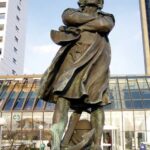

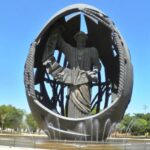
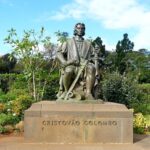
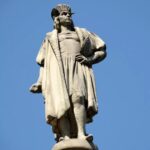
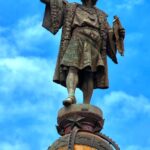
В родном городе мореплавателя, в Генуе, есть дом Христофора Колумба, который является реконструкцией оригинального средневекового здания, где предположительно он жил.
О первооткрывателе снято множество фильмов, его имя носит североамериканская киностудия и два латиноамериканских футбольных клуба. Ему посвящено несколько опер, поставлено немалое число спектаклей в разных странах Мира. В Доминиканской республике существует орден Христофора Колумба. Его изображение помещено на ряде денежных единиц, выпускаемых Коста-Рикой и Сальвадором, на памятной монете республики Сан-Марино.
Труды
- Письмо Колумба о первом плавании в Америку
- Книга привилегий
- Книга пророчеств
- Судовой журнал Колумба
Ссылки
- Страница в Википедии
Для нас важна актуальность и достоверность информации. Если вы обнаружили ошибку или неточность, пожалуйста, сообщите нам. Выделите ошибку и нажмите сочетание клавиш Ctrl+Enter.

Кто такой Христофор Колумб, знает каждый школьник: тот, кто Америку открыл. Но этого до конца жизни не знал сам Христофор Колумб. Биография его — пример верности мечте о коротком пути к сказочно богатым землям. Это стремление многих мореплавателей привело к открытию неизвестных европейцам материков, островов, торговых путей. В истории человечества этот период составил целую эпоху великих географических открытий (XV–XVII века).
Биография Колумба: интересные факты
Родина Колумба — Италия. Точнее никто не скажет: до сих пор шесть городов спорят, где именно появился на свет великий путешественник. Зато точно известно, когда родился Христофор Колумб. Это произошло 31 октября 1451-го.
Его родители — Доменико Коломбо и Сузанна Фонтанаросса — были людьми небогатыми, но смогли дать хорошее образование детям. По предположению некоторых исследователей, они были крещеными евреями, а богатые итальянцы, собратья по происхождению, помогали им.
Образование и опыт мореплавания
До 14 лет Христофор Колумб учился дома. Приходящие учителя блестяще обучили его основам математики и языкам. Отец иногда устраивал подростка юнгой на торговые шхуны, ходившие по Средиземному морю. Там будущий мореплаватель освоил искусство навигации. Тогда же от моряков он наслушался историй о неслыханных богатствах далеких стран Азии.
Дальше юноша учился в Павийском университете. Здесь он познакомился с астрономом и географом Паоло Тосканелли. Этот ученый увлек молодого человека мечтой о коротком морском пути в Индию.
Его идея основывалась на том, что двигаться туда надо не в восточном направлении, а на запад. А поскольку Земля имеет форму шара, то мысль казалась верной. Но ошибочными оказались представления о размерах планеты.
Из Португалии, где жил Христофор Колумб с 1476 года, мореплаватель ходил в морские торговые экспедиции, побывал в Англии, Исландии, Ирландии. В этих путешествиях он узнал о викингах, еще полтысячи лет назад пересекавших океан в западном направлении и доходивших до каких-то земель.
Проект путешествия в Азию
В этот же период у него окончательно сложилось убеждение, что путь в Азию лежит через Атлантику. Биография Христофора Колумба охватывает почти десятилетие, в течение которого он обивал пороги приемных европейских монархов со своим предложением.
Впервые он обратился к правителю Генуи, но его не приняли. Затем в 1483-м он предложил выгодный проект нового пути в Азию королю Португалии. Но советники сомневались в правильности расчетов, поэтому предложение отклонили. Еще несколько лет ушло на безрезультатную переписку с другими европейскими правителями.
Испанские монархи и Колумб
Переехав в Испанию, Колумб ознакомил с проектом влиятельных лиц, через которых добился встречи с королевской четой — Фердинандом и Изабеллой. Они собрали комиссию из космографов, богословов и других знающих специалистов. Но принять решение мешали обстоятельства:
- война, к которой готовилась испанская корона;
- разногласия с церковным учением, которое не признавало шарообразность Земли. А ведь на этой идее строились все предположения Колумба.
Переговоры с испанскими монархами возобновились в 1492 году. Они дали мореплавателю дворянский чин, право стать вице-королем новых земель. Но деньги на оснащение предприятия ему предстояло искать самому. Помог в этом судовладелец и единомышленник Колумба Мартин Алонсо Пинсон: он предоставил один свой корабль, дал деньги на второй, а также ссудил средства для взноса от Колумба.
Одиннадцать лет, с 1492-го до 1503-го, — самые насыщенные годы жизни Колумба: он совершил четыре знаменитые экспедиции, открыл новые земли.
Личная жизнь Колумба
Истории мало известно о личной жизни путешественника:
- В юности он женился на Фелипе Монис де Палестрелло. У них родился сын Диего.
- Позже второй сын Фернандо родился от связи с Беатрис Энрикес де Арана. Колумб заботился об обоих наследниках.
Из 4-го мореплавания Колумб возвратился тяжело больным. Средств у него не было — все истратил на оплату долгов. Дарованных ему ранее прав добиться так и не смог. В бедности великий первооткрыватель умер 20 мая 1506 года.
Христофор Колумб: открытия и достижения
В экспедициях мореход вел бортовой журнал. Благодаря его копии, которая частично сохранилась, известны открытия Колумба с точностью до одного дня. Каждая из 4-х экспедиций была знаменательным событием:
Первое путешествие
Экспедиция началась 3 августа 1492 года. В море вышли 3 корабля:
- флагман «Санта-Мария»;
- «Пинта» ;
- «Нинья».
В команде — сотня человек. Больше двух месяцев пересекали Атлантику, потом наткнулись на сушу. Огни острова заметили 12 октября 1492-го, на следующий день достигли берега и составили соответствующий нотариальный акт о вступлении во владение землей.
Это оказался Багамский архипелаг, который составляют около 3 тыс. островов, растянувшихся более чем на тысячу километров. Тот, на котором высадилась команда Колумба, имел местное название Гуанахани. Вновь прибывшие назвали его Сан-Сальвадор.
Продолжив плавание, в конце октября корабли побывали в одной из бухт на Кубе. Но Колумб посчитал, что это часть Китая, и решил направиться на восток, рассчитывая попасть в Японию. Так 6 декабря открыли остров Гаити и назвали его Эспаньолой.
Христофору Колумбу еще были неизвестны истинные размеры Земли, он даже не подозревал, что между Европой и Азией в западном направлении расположен целый материк. Мореплаватель считал, что достиг островов Восточной Азии. Эти территории долго именовали Вест-Индией.
Второе путешествие
Вторая экспедиция Колумба началась 25 сентября 1493-го и продолжалась почти три года. Эскадра состояла уже из 17 кораблей, а на их борту кроме моряков было более двух тысяч будущих поселенцев, которые везли все для основания колоний на новых землях.
В ходе этой экспедиции открыли:
- Антильские и Виргинские острова;
- большие территории — Пуэрто-Рико, Ямайку;
- исследовали южный берег Кубы, который считали оконечностью Индии.
Третье путешествие
В ходе 3-й экспедиции, начавшейся в мае 1498-го, был открыт остров Тринидад, но сам Колумб заболел и вернулся на Эспаньолу.
В том же году другой мореплаватель, Васко да Гама, обогнув Африку, открыл морской путь в Индию. Он привез оттуда драгоценные пряности, а Колумба все стали считать обманщиком. В 1500-м его арестовали и отправили в Испанию. Благодаря заступничеству влиятельных людей обвинения сняли, но обещанные титулы он не получил.
Четвертое путешествие
И все-таки Христофор Колумб был уверен, что до Индии от открытых им островов рукой подать, и убедил в этом короля, который разрешил еще одну экспедицию. Она была снаряжена из 4-х кораблей и началась в мае 1502-го. В ходе ее были открыты:
- остров Мартиника;
- обнаружен и захвачен берег Центральной Америки, который был барьером между Атлантикой и Тихим океаном;
- обнаружен узкий Панамский перешеек, где Колумб искал пролив;
- открыты Каймановы острова.
До конца своих дней Христофор Колумб считал, что нашел путь в Азию. Ценность его открытий ощутили уже в середине того же XVI века. Тогда из завоеванных Мексики, Перу европейцы стали вывозить золото и серебро.
Христофор Колумб — великий мореплаватель. Свою жизнь он посвятил поискам короткого пути в Индию, двигаясь в западном направлении. При этом открыл неизвестные европейцам земли и считал, что от них рукой подать до Азии.
Имя Колумба носит страна в Латинской Америке, округ и города в США, а 12 октября уже более 500 лет считается датой открытия Америки.
Оригинал статьи: https://www.nur.kz/family/school/1884875-hristofor-kolumb-biografia-otkrytia/
| Part of the Age of Discovery | |
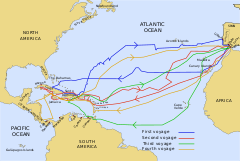
The four voyages of Columbus (conjectural) |
|
| Date | 1492, 1493, 1498 & 1502 |
|---|---|
| Location | The Americas |
| Participants | Christopher Columbus and Castilian crew (among others) |
| Outcome | European rediscovery and colonization of the Americas |
Between 1492 and 1504, Italian explorer Christopher Columbus led four Spanish transatlantic maritime expeditions of discovery to the Americas. These voyages led to the widespread knowledge of the New World. This breakthrough inaugurated the period known as the Age of Discovery, which saw the colonization of the Americas, a related biological exchange, and trans-Atlantic trade. These events, the effects and consequences of which persist to the present, are often cited as the beginning of the modern era.
Born in the Republic of Genoa, Columbus was a navigator who sailed for the Crown of Castile (a predecessor to the modern Kingdom of Spain) in search of a westward route to the Indies, thought to be the East Asian source of spices and other precious oriental goods obtainable only through arduous overland routes. Columbus was partly inspired by 13th-century Italian explorer Marco Polo in his ambition to explore Asia and never admitted his failure in this, incessantly claiming and pointing to supposed evidence that he had reached the East Indies. Ever since, the Bahamas as well as the islands of the Caribbean have been referred to as the West Indies.
At the time of Columbus’s voyages, the Americas were inhabited by Indigenous Americans. Soon after first contact, Eurasian diseases such as smallpox began to devastate the indigenous populations. Columbus participated in the beginning of the Spanish conquest of the Americas, which involved brutally treating and enslaving the natives in the range of thousands.
Columbus died in 1506, and the next year, the New World was named «America» after Amerigo Vespucci, who realized that it was a unique landmass. The search for a westward route to Asia was completed in 1521, when another Spanish voyage, the Magellan-Elcano expedition sailed across the Pacific Ocean and reached Southeast Asia, before returning to Europe and completing the first circumnavigation of the world.
Background
Many Europeans of Columbus’s day assumed that a single, uninterrupted ocean surrounded Europe and Asia, although Norse explorers had colonized areas of North America beginning with Greenland c. 986.[1][2] The Norse maintained a presence in North America for hundreds of years, but contacts between their North American settlements and Europe had all but ceased by the early 15th century.[3][4][5]
Until the mid-15th century, Europe enjoyed a safe land passage to China and India—sources of valued goods such as silk, spices, and opiates—under the hegemony of the Mongol Empire (the Pax Mongolica, or Mongol Peace). With the Fall of Constantinople to the Turkish Ottoman Empire in 1453, the land route to Asia (the Silk Road) became more difficult as Christian traders were prohibited.[6]
Portugal was the main European power interested in pursuing trade routes overseas, with the neighboring kingdom of Castile—predecessor to Spain—having been somewhat slower to begin exploring the Atlantic because of the land area it had to reconquer from the Moors during the Reconquista. This remained unchanged until the late 15th century, following the dynastic union by marriage of Queen Isabella I of Castile and King Ferdinand II of Aragon (together known as the Catholic Monarchs of Spain) in 1469, and the completion of the Reconquista in 1492, when the joint rulers conquered the Moorish kingdom of Granada, which had been providing Castile with African goods through tribute. The fledgling Spanish Empire decided to fund Columbus’s expedition in hopes of finding new trade routes and circumventing the lock Portugal had secured on Africa and the Indian Ocean with the 1481 papal bull Aeterni regis.[7]
Navigation plans
In response to the need for a new route to Asia, by the 1480s, Christopher and his brother Bartholomew had developed a plan to travel to the Indies (then construed roughly as all of southern and eastern Asia) by sailing directly west across what was believed to be the singular «Ocean Sea,» the Atlantic Ocean. By about 1481, Florentine cosmographer Paolo dal Pozzo Toscanelli sent Columbus a map depicting such a route, with no intermediary landmass other than the mythical island of Antillia.[8] In 1484 on the island of La Gomera in the Canaries, then undergoing conquest by Castile, Columbus heard from some inhabitants of El Hierro that there was supposed to be a group of islands to the west.[9]
A popular misconception that Columbus had difficulty obtaining support for his plan because Europeans thought the Earth was flat can be traced back to a 17th-century campaign of Protestants against Catholicism,[10] and was popularized in works such as Washington Irving’s 1828 biography of Columbus.[11] In fact, the knowledge that the Earth is spherical was widespread, having been the general opinion of Ancient Greek science, and gaining support throughout the Middle Ages (for example, Bede mentions it in The Reckoning of Time). The primitive maritime navigation of Columbus’s time relied on both the stars and the curvature of the Earth.[12][13]
Diameter of Earth and travel distance estimates
Columbus’s geographical conceptions (beige) compared to the known landmasses and their demarkation by Juan de la Cosa (black)
Eratosthenes had measured the diameter of the Earth with good precision in the 2nd century BC,[14] and the means of calculating its diameter using an astrolabe was known to both scholars and navigators.[12] Where Columbus differed from the generally accepted view of his time was in his incorrect assumption of a significantly smaller diameter for the Earth, claiming that Asia could be easily reached by sailing west across the Atlantic. Most scholars accepted Ptolemy’s correct assessment that the terrestrial landmass (for Europeans of the time, comprising Eurasia and Africa) occupied 180 degrees of the terrestrial sphere, and dismissed Columbus’s claim that the Earth was much smaller, and that Asia was only a few thousand nautical miles to the west of Europe.[15]
The «Columbus map», depicting only the Old World, was drawn c. 1490 in the workshop of Bartolomeo and Christopher Columbus in Lisbon.[16]
Handwritten notes by Christopher Columbus on the Latin edition of Marco Polo’s Le livre des merveilles
Columbus believed the incorrect calculations of Marinus of Tyre, putting the landmass at 225 degrees, leaving only 135 degrees of water.[17][15] Moreover, Columbus underestimated Alfraganus’s calculation of the length of a degree, reading the Arabic astronomer’s writings as if, rather than using the Arabic mile (about 1,830 m), he had used the Italian mile (about 1,480 meters). Alfraganus had calculated the length of a degree to be 56⅔ Arabic miles (66.2 nautical miles).[15] Columbus therefore estimated the size of the Earth to be about 75% of Eratosthenes’s calculation, and the distance from the Canary Islands to Japan as 2,400 nautical miles (about 23% of the real figure).[18]
Trade winds
There was a further element of key importance in the voyages of Columbus, the trade winds.[19] He planned to first sail to the Canary Islands before continuing west by utilizing the northeast trade wind.[20] Part of the return to Spain would require traveling against the wind using an arduous sailing technique called beating, during which almost no progress can be made.[21] To effectively make the return voyage, Columbus would need to follow the curving trade winds northeastward to the middle latitudes of the North Atlantic, where he would be able to catch the «westerlies» that blow eastward to the coast of Western Europe.[22]
The navigational technique for travel in the Atlantic appears to have been exploited first by the Portuguese, who referred to it as the volta do mar (‘turn of the sea’). Columbus’s knowledge of the Atlantic wind patterns was, however, imperfect at the time of his first voyage. By sailing directly due west from the Canary Islands during hurricane season, skirting the so-called horse latitudes of the mid-Atlantic, Columbus risked either being becalmed or running into a tropical cyclone, both of which, by chance, he avoided.[23]
Funding campaign
Around 1484, King John II of Portugal submitted Columbus’s proposal to his experts, who rejected it on the basis that Columbus’s estimation of a travel distance of 2,400 nautical miles was about four times too low (which was accurate).[24]
In 1486, Columbus was granted an audience with the Catholic Monarchs, and he presented his plans to Isabella. She referred these to a committee, which determined that Columbus had grossly underestimated the distance to Asia. Pronouncing the idea impractical, they advised the monarchs not to support the proposed venture. To keep Columbus from taking his ideas elsewhere, and perhaps to keep their options open, the Catholic Monarchs gave him an allowance, totaling about 14,000 maravedís for the year, or about the annual salary of a sailor.[25]
In 1488 Columbus again appealed to the court of Portugal, receiving a new invitation for an audience with John II. This again proved unsuccessful, in part because not long afterwards Bartolomeu Dias returned to Portugal following a successful rounding of the southern tip of Africa. With an eastern sea route now under its control, Portugal was no longer interested in trailblazing a western trade route to Asia crossing unknown seas.[26]
In May 1489, Isabella sent Columbus another 10,000 maravedis, and the same year the Catholic Monarchs furnished him with a letter ordering all cities and towns under their domain to provide him food and lodging at no cost.[27]
As Queen Isabella’s forces neared victory over the Moorish Emirate of Granada for Castile, Columbus was summoned to the Spanish court for renewed discussions.[28] He waited at King Ferdinand’s camp until January 1492, when the monarchs conquered Granada. A council led by Isabella’s confessor, Hernando de Talavera, found Columbus’s proposal to reach the Indies implausible. Columbus had left for France when Ferdinand intervened,[a] first sending Talavera and Bishop Diego Deza to appeal to the queen.[29] Isabella was finally convinced by the king’s clerk Luis de Santángel, who argued that Columbus would bring his ideas elsewhere, and offered to help arrange the funding.[b] Isabella then sent a royal guard to fetch Columbus, who had travelled several kilometers toward Córdoba.[29]
In the April 1492 «Capitulations of Santa Fe», Columbus was promised he would be given the title «Admiral of the Ocean Sea» and appointed viceroy and governor of the newly claimed and colonized for the Crown; he would also receive ten percent of all the revenues from the new lands in perpetuity if he was successful.[31] He had the right to nominate three people, from whom the sovereigns would choose one, for any office in the new lands. The terms were unusually generous but, as his son later wrote, the monarchs were not confident of his return.
History
First voyage (1492–1493)
Captain’s ensign of Columbus’s ships
For his westward voyage to find a shorter route to the Orient, Columbus and his crew took three medium-sized ships, the largest of which was a carrack (Spanish: nao), the Santa María, which was owned and captained by Juan de la Cosa, and under Columbus’s direct command.[32][c] The other two were smaller caravels; the name of one is lost, but it is known by the Castilian nickname Pinta («painted one»). The other, the Santa Clara, was nicknamed the Niña («girl»), perhaps in reference to her owner, Juan Niño of Moguer.[33] The Pinta and the Niña were piloted by the Pinzón brothers (Martín Alonso and Vicente Yáñez, respectively).[32] On the morning of 3 August 1492, Columbus departed from Palos de la Frontera, going down the Rio Tinto and into the Atlantic.[34][35]
Three days into the journey, on 6 August 1492, the rudder of the Pinta broke.[36] Martín Alonso Pinzón suspected the owners of the ship of sabotage, as they were afraid to go on the journey. The crew was able to secure the rudder with ropes until they could reach the Canary Islands, where they arrived on 9 August.[37] The Pinta had its rudder replaced on the island of Gran Canaria, and by September 2 the ships rendezvoused at La Gomera, where the Niña‘s lateen sails were re-rigged to standard square sails.[38] Final provisions were secured, and on 6 September the ships departed San Sebastián de La Gomera[38][39] for what turned out to be a five-week-long westward voyage across the Atlantic.
As described in the abstract of his journal made by Bartolomé de las Casas, on the outward bound voyage Columbus recorded two sets of distances: one was in measurements he normally used, the other in the Portuguese maritime leagues used by his crew. Las Casas originally interpreted that he reported the shorter distances to his crew so they would not worry about sailing too far from Spain, but Oliver Dunn and James Kelley state that this was a misunderstanding.[40]
On 13 September 1492, Columbus observed that the needle of his compass no longer pointed to the North Star. It was once believed that Columbus had discovered magnetic declination, but it was later shown that the phenomenon was already known, both in Europe and in China.[41][d]
First Landing in the Americas
First voyage (conjectural):[e] modern place names in black, Columbus’s place names in blue
After 29 days out of sight of land, on 7 October 1492, the crew spotted «[i]mmense flocks of birds», some of which his sailors trapped and determined to be «field» birds (probably Eskimo curlews and American golden plovers). Columbus changed course to follow their flight.[45]
On 11 October, Columbus changed the fleet’s course to due west, and sailed through the night, believing land was soon to be found. At around 10:00 in the evening, Columbus thought he saw a light «like a little wax candle rising and falling».[46][f] Four hours later, land was sighted by a sailor named Rodrigo de Triana (also known as Juan Rodríguez Bermejo) aboard the Pinta.[47][g] Triana immediately alerted the rest of the crew with a shout, and the ship’s captain, Martín Alonso Pinzón, verified the land sighting and alerted Columbus by firing a lombard.[48][h] Columbus would later assert that he had first seen land, thus earning the promised annual reward of 10,000 maravedís.[49][50]
Columbus called this island San Salvador, in the present-day Bahamas; the indigenous name was Guanahani.[51] According to Samuel Eliot Morison, San Salvador Island[i] is the only island fitting the position indicated by Columbus’s journal.[44][j] Columbus wrote of the natives he first encountered in his journal entry of 12 October 1492:
Many of the men I have seen have scars on their bodies, and when I made signs to them to find out how this happened, they indicated that people from other nearby islands come to San Salvador to capture them; they defend themselves the best they can. I believe that people from the mainland come here to take them as slaves. They ought to make good and skilled servants, for they repeat very quickly whatever we say to them. I think they can very easily be made Christians, for they seem to have no religion. If it pleases our Lord, I will take six of them to Your Highnesses when I depart, in order that they may learn our language.[53]
A depiction of Columbus claiming possession of the land in caravels, the Niña and the Pinta
Columbus called the indigenous Americans indios (Spanish for ‘Indians’)[54][55][56] in the mistaken belief that he had reached the East Indies;[57] the islands of the Caribbean are termed the West Indies because of this error.
Columbus initially encountered the Lucayan, Taíno, and Arawak peoples.[k] Noting their gold ear ornaments, Columbus took some of the Arawaks prisoner and insisted that they guide him to the source of the gold.[59] Columbus noted that their primitive weapons and military tactics made the natives susceptible to easy conquest.[l]
Columbus observed the people and their cultural lifestyle. He also explored the northeast coast of Cuba, landing on 28 October 1492, and the north-western coast of Hispaniola, present day Haiti, by 5 December 1492. Here, the Santa Maria ran aground on Christmas Day, 25 December 1492, and had to be abandoned. Columbus was received by the native cacique (chieftain) Guacanagari, who gave him permission to leave some of his men behind. Columbus left 39 men, including the interpreter Luis de Torres,[60][m] and founded the settlement of La Navidad.[61] He kept sailing along the northern coast of Hispaniola with a single ship, until he encountered Pinzón and the Pinta on 6 January.
On 13 January 1493, Columbus made his last stop of this voyage in the Americas, in the Bay of Rincón at the eastern end of the Samaná Peninsula in northeast Hispaniola.[62] There he encountered the Ciguayos, the only natives who offered violent resistance during this first voyage.[63] The Ciguayos refused to trade the amount of bows and arrows that Columbus desired; in the ensuing clash one Ciguayo was stabbed in the buttocks and another wounded with an arrow in his chest.[64] Because of the Ciguayos’ use of arrows, Columbus named the inlet the Bay of Arrows (or Gulf of Arrows).[65]
Four natives who boarded the Niña at Samaná Peninsula told Columbus of what was possibly the Isla de Carib (probably Puerto Rico), which was supposed to be populated by cannibalistic Caribs, as well as Matinino, an island populated only by women, which Columbus associated with an island in the Indian Ocean described by Marco Polo.[66]
First return
On 16 January 1493, the homeward journey was begun.[67]
Columbus before the King (Ferdinand II) and Queen (Isabella I) of Spain upon returning from his first voyage
While returning to Spain, the Niña and Pinta encountered the roughest storm of their journey, and on the night of 13 February, lost contact with each other. All hands on the Niña vowed, if they were spared, to make a pilgrimage to the nearest church of Our Lady wherever they first made land.
On the morning of 15 February, land was spotted. Columbus believed they were approaching the Portuguese Azores Islands, but others felt that they were considerably north of the islands. Columbus turned out to be right. On the night of 17 February, the Niña laid anchor at Santa Maria Island, but the cable broke on sharp rocks, forcing Columbus to stay offshore until morning, when a safer location was found nearby. A few sailors took a boat to the island, where they were told by several islanders of a still safer place to land, so the Niña moved once again. At this spot, Columbus took aboard several islanders with food. When told of the vow to Our Lady, the islanders directed the crew to a small shrine nearby.[68]
Columbus sent half of the crew to the island to fulfill their vow, but he and the rest stayed on the Niña, planning to send the other half later. While the shore party were in prayer, they were taken prisoner by order of the island’s captain, João de Castanheira, ostensibly out of fear that they were pirates. Castanheira commandeered their shore boat, which he took with several armed men to the Niña, planning to arrest Columbus. When Columbus defied him, Castanheira said he did not believe or care about Columbus’ story, denounced Spaniards, and went back to the island. After another two days, Castanheira released the prisoners, having been unable to get confessions from them or to capture his real target, Columbus. Some claimed that Columbus was captured, but this is contradicted by Columbus’s log book.[68]
Leaving the island of Santa Maria in the Azores on 23 February, Columbus headed for Castilian Spain, but another storm forced him into Lisbon. He anchored next to a king’s harbor patrol ship on 4 March 1493, where he was told a fleet of 100 caravels had been lost in the storm. Astoundingly, both the Niña and the Pinta had been spared. Not finding King John II of Portugal in Lisbon, Columbus wrote to him and waited for a reply. The king agreed to meet Columbus at Vale do Paraíso, despite the poor relations between Portugal and Castile at the time. Upon learning of Columbus’s discoveries, the Portuguese king informed him that he believed the voyage to be in violation of the 1479 Treaty of Alcáçovas.
After spending more than a week in Portugal, Columbus set sail for Spain. He arrived back in Palos on 15 March 1493 and later met with Ferdinand and Isabella in Barcelona to report his findings.[n][o]
Columbus showed off what he had brought back from his voyage to the monarchs, including a few small samples of gold, pearls, gold jewelry from the natives, a few Taíno he had kidnapped,[citation needed] flowers, and a hammock.[citation needed] He also brought the previously unknown tobacco plant, the pineapple fruit, and the turkey.[citation needed] He did not bring any of the precious East Indies spices such as black pepper, ginger or cloves. In his log, he wrote «there is also plenty of ‘ají’, which is their pepper, which is more valuable than black pepper, and all the people eat nothing else, it being very wholesome».[69][p]
Columbus brought captured Taínos to present to the sovereigns, never having met the infamous Caribs.[70] In Columbus’s letter on the first voyage, addressed to the Spanish court, he insisted he had reached Asia, describing the island of Hispaniola as being off the coast of China. He emphasized the potential riches of the land, exaggerating the abundance of gold, and that the natives seemed ready to convert to Christianity.[71] The letter was translated into multiple languages and widely distributed,[72] creating a sensation:
Hispaniola is a miracle. Mountains and hills, plains and pastures, are both fertile and beautiful … the harbors are unbelievably good and there are many wide rivers of which the majority contain gold. … There are many spices, and great mines of gold and other metals…[73]
Upon Columbus’s return, most people initially accepted that he had reached the East Indies, including the sovereigns and Pope Alexander VI,[57] though in a letter to the Vatican dated 1 November 1493, the historian Peter Martyr described Columbus as the discoverer of a Novi Orbis («New Globe»).[74] The pope issued four bulls (the first three of which are collectively known as the Bulls of Donation), to determine how Spain and Portugal would colonize and divide the spoils of the new lands. Inter caetera, issued 4 May 1493, divided the world outside Europe between Spain and Portugal along a north–south meridian 100 leagues west of either the Azores or Cape Verde Islands in the mid-Atlantic, thus granting Spain all the land discovered by Columbus.[75] The 1494 Treaty of Tordesillas, ratified in the next decade by Pope Julius II, moved the dividing line to 370 leagues west of the Azores or Cape Verde.[76]
Second voyage (1493–1496)
Columbus’s second voyage[q]
The stated purpose of the second voyage was to convert the indigenous Americans to Christianity. Before Columbus left Spain, he was directed by Ferdinand and Isabella to maintain friendly, even loving, relations with the natives.[78] He set sail from Cádiz, Spain, on 25 September 1493.[79]
The fleet for the second voyage was much larger: two naos and 15 caravels. The two naos were the flagship Marigalante («Gallant Mary»)[r] and the Gallega; the caravels were the Fraila (‘the nun’), San Juan, Colina (‘the hill’), Gallarda (‘the gallant’), Gutierre, Bonial, Rodriga, Triana, Vieja (‘the old’), Prieta (‘the brown’), Gorda (‘the fat’), Cardera, and Quintera.[80] The Niña returned for this expedition, which also included a ship named Pinta probably identical to that from the first expedition. In addition, the expedition saw the construction of the first ship in the Americas, the Santa Cruz or India.[81]
Caribbean exploration
On 3 November 1493, Christopher Columbus landed on a rugged shore on an island that he named Dominica. On the same day, he landed at Marie-Galante, which he named Santa María la Galante. After sailing past Les Saintes (Todos los Santos), he arrived at Guadeloupe (Santa María de Guadalupe), which he explored between 4 November and 10 November 1493. The exact course of his voyage through the Lesser Antilles is debated, but it seems likely that he turned north, sighting and naming many islands including Santa María de Montserrat (Montserrat), Santa María la Antigua (Antigua), Santa María la Redonda (Saint Martin), and Santa Cruz (Saint Croix, on 14 November).[82] He also sighted and named the island chain of the Santa Úrsula y las Once Mil Vírgenes (the Virgin Islands), and named the islands of Virgen Gorda.
On Santa Cruz, the Europeans saw a canoe with a few Carib men and two women. They had two male captives, and had recently castrated them. The Europeans pursued them, and were met with arrows from both the men and women,[83] fatally wounding at least one man, who perished about a week later.[84] The Europeans either killed or captured all aboard the canoe, thereafter beheading them.[85] Another was thrown overboard, and when he was spotted crawling away holding his entrails, the Arawaks recommended he be recaptured so he would not alert his tribe; he was thrown overboard again, and then had to be shot down with arrows.[83][s] Columbus’s childhood friend Michele da Cuneo—according to his own account—took one of the women in the skirmish, whom Columbus let him keep as a slave; Cuneo subsequently beat and raped her.[85][83][t][u]
The fleet continued to the Greater Antilles, and landed on the island of San Juan Bautista, present-day Puerto Rico, on 19 November 1493. Diego Álvarez Chanca recounts that on this island, the Europeans rescued some women from a group of at least 20 that the local Caribs had been keeping as sex slaves. The women explained that any male captives were eaten, and that their own male offspring were castrated and made to serve the Caribs until they were old enough to be considered good to eat. The Europeans rescued three of these boys.[88]
Hispaniola and Jamaica
On 22 November, Columbus sailed from San Juan Bautista to Hispaniola. The next morning, a native taken during the first voyage was returned to Samaná Bay.[84] The fleet sailed about 170 miles over two days and discovered, at Monte Cristi, decomposing bodies of four men; one had a beard implying he had been a Spaniard.[89] On the night of 27 November, cannons and flares were ignited in an attempt to signal La Navidad, but there was no response. A canoe party led by a cousin of Guacanagari presented Columbus with two golden masks and told him that Guacanagari had been injured by another chief, Caonabo, and that except for some Spanish casualties resulting from sickness and quarrel, the rest of his men were well.[89] The next day, the Spanish fleet discovered the burnt remains of the Navidad fortress, and Guacanagari’s cousin admitted that the Europeans had been wiped out by Caonabo.[90] Other natives showed the Spaniards some of the bodies, and said that they had «taken three or four women apiece».[90] While some suspicion was placed on Guacanagari, it gradually emerged that two of the Spaniards had formed a murderous gang in search of gold and women, prompting Caonabo’s wrath.[91] The fleet then fought the winds, traveling only 32 miles over 25 days, and arriving at a plain on the north coast of Hispaniola on 2 January 1494. There, they established the settlement of La Isabela.[92] Columbus spent some time exploring the interior of the island for gold. Finding some, he established a small fort in the interior.
Columbus left Hispaniola on 24 April 1494, and arrived at the island of Cuba (which he had named Juana during his first voyage) on 30 April and Discovery Bay, Jamaica, on 5 May. He explored the south coast of Cuba, which he believed to be a peninsula of China rather than an island, and several nearby islands including La Evangelista (the Isle of Youth), before returning to Hispaniola on 20 August.
Slavery, settlers, and tribute
Columbus had planned for Queen Isabella to set up trading posts with the cities of the Far East made famous by Marco Polo, but whose Silk Road and eastern maritime routes had been blockaded to her crown’s trade. However, Columbus would never find Cathay (China) or Zipangu (Japan), and there was no longer any Great Khan for trade treaties.
In 1494, Columbus sent Alonso de Ojeda (whom a contemporary described as «always the first to draw blood wherever there was a war or quarrel») to Cibao (where gold was being mined),[93] which resulted in Ojeda’s capturing several natives on an accusation of theft. Ojeda cut the ears off of one native, and sent the others to La Isabela in chains, where Columbus ordered them to be decapitated.[94] During his brief reign, Columbus executed Spanish colonists for minor crimes, and used dismemberment as another form of punishment.[95] By the end of 1494, disease and famine had claimed two-thirds of the Spanish settlers.[96][97] A native Nahuatl account depicts the social breakdown that accompanied the pandemic: «A great many died from this plague, and many others died of hunger. They could not get up to search for food, and everyone else was too sick to care for them, so they starved to death in their beds.»[98]
By 1494, Columbus had shared his viceroyship with one of his military officers named Margarit, ordering him to prioritize Christianizing the natives, but that part of their noses and ears should be cut off for stealing. Margarit’s men exploited the natives by beating, raping and enslaving them, with none on Hispaniola being baptized for another two years. Columbus’s brother Diego warned Margarit to follow the admiral’s orders, which provoked him to take three caravels back to Spain. Fray Buil, who was supposed to perform baptisms, accompanied Margarit. After arriving in Spain in late 1494, Buil complained to the Spanish court of the Columbus brothers and that there was no gold. Groups of Margarit’s soldiers who remained in the west continued brutalizing the natives. Instead of forbidding this, Columbus participated in enslaving the indigenous people.[99] In February 1495, he took over 1,500 Arawaks, some of whom had rebelled against the oppression of the colonists,[59][100] and many of whom were subsequently released or taken by the Caribs.[101][better source needed] That month, Columbus shipped approximately 500 of these Americans to Spain to be sold as slaves; about 40% died en route,[59][100] and half of the rest were sick upon arrival. In June of that year, the Spanish crown sent ships and supplies to the colony on Hispaniola, which Florentine merchant Gianotto Berardi had helped procure.[102][v] In October, Berardi received almost 40,000 maravedís worth of slaves, who were alleged to be either cannibals or prisoners.[102][w]
Columbus’s tribute system was described by his son Ferdinand: «In the Cibao, where the gold mines were, every person of fourteen years of age or upward was to pay a large hawk’s bell of gold dust;[x] all others were each to pay 25 pounds of cotton. Whenever an Indian delivered his tribute, he was to receive a brass or copper token which he must wear about his neck as proof that he had made his payment; any Indian found without such a token was to be punished.»[93] The monarchs, who suggested the tokens, called for a light punishment,[106] but any Indian found without a copper token had their hands cut off, which was a likely death sentence.[73] Since there was no abundance of gold on the island, the natives had no chance of meeting Columbus’s quota and thousands are reported to have committed suicide.[107] By 1497, the tribute system had all but collapsed.[108]
Columbus became ill in 1495, and during this time, his troops acted out of order, enacting cruelties on the natives, including torturing them to learn where the supposed gold was.[109] When he recovered, he led men and dogs to hunt down natives who fled their forced duties, killing them or cutting off their hands as a warning to others.[110] Brutalities and murders were carried out even against natives who were sick and unarmed.[110] In addition, Spanish colonists under Columbus’s rule began to buy and sell natives as slaves, including children.[111]
The Spanish fleet departed La Isabela on 10 March 1496.[112] Again set back by unfavorable trade winds, supplies began to run low; on 10 April, Columbus requested food from the natives of Guadeloupe. Upon going ashore, the Spaniards were ambushed by arrows; in response, they destroyed some huts. They then held a group of 13 native women and children hostage to force a sale of cassava.[113] The Niña and India left Guadeloupe on 20 April. On 8 June, the fleeted landed at Portugal, near Odemira, and returned to Spain via the Bay of Cádiz on 11 June.[114]
Third voyage (1498–1500)
According to the abstract of Columbus’s journal made by Bartolomé de Las Casas, the objective of the third voyage was to verify the existence of a continent that King John II of Portugal suggested was located to the southwest of the Cape Verde Islands. King John reportedly knew of the existence of such a mainland because «canoes had been found which set out from the coast of Guinea [West Africa] and sailed to the west with merchandise.»[115][116] Italian explorer John Cabot probably reached the mainland of the American continent in June 1497,[117] although his landing site is disputed.[118]
On 30 May 1498, Columbus left with six ships from Sanlúcar, Spain, for his third trip to the Americas. Three of the ships headed directly for Hispaniola with much-needed supplies, while Columbus took the other three in an exploration of what might lie to the south of the Caribbean islands he had already visited, including a hoped-for passage to continental Asia.[119] Columbus led his fleet to the Portuguese island of Porto Santo, his wife’s native land. He then sailed to Madeira and spent some time there with the Portuguese captain João Gonçalves da Camara, before sailing to the Canary Islands and Cape Verde.
On 13 July, Columbus’s fleet entered the doldrums of the mid-Atlantic, where they were becalmed for several days, the heat doing damage to their ships, food, and water supply.[120] An easterly wind finally propelled them westwards, which was maintained until 22 July, when birds flying from southwest to northeast were sighted, and the fleet turned north in the direction of Dominica.[121] The men sighted the land of Trinidad on 31 July, approaching from the southeast.[122] The fleet sailed along the southern coast and entered Dragon’s Mouth, anchoring near Soldado Rock (west of Icacos Point, Trinidad’s southwesternmost point) where they made contact with a group of Amerindians in canoes.[123][y] On 1 August, Columbus and his men arrived at a landmass near the mouth of South America’s Orinoco river, in the region of modern-day Venezuela. Columbus recognized from the topography that it must be the continent’s mainland, but while describing it as an otro mundo (‘other world’),[124] retained the belief that it was Asia—and perhaps an Earthly Paradise.[125] On 2 August, they landed at Icacos Point (which Columbus named Punta de Arenal) in modern Trinidad, narrowly avoiding a violent encounter with the natives.[126] Early on 4 August, a tsunami nearly capsized Columbus’s ship.[127] The men sailed across the Gulf of Paria, and on 5 August, landed on the mainland of South America at the Paria Peninsula.[128] Columbus, suffering from a monthlong bout of insomnia and impaired vision from his bloodshot eyes, authorized the other fleet captains to go ashore first: one planted a cross, and the other recorded that Columbus subsequently landed to formally take the province for Spain. They sailed further west, where the sight of pearls compelled Columbus to send men to obtain some, if not gold. The natives provided nourishment including a maize wine, new to Columbus. Compelled to reach Hispaniola before the food aboard his ship spoiled, Columbus was disappointed to discover that they had sailed into a gulf, and while they had obtained fresh water, they had to go back east to reach open waters again.[129]
Making observations with a quadrant at sea, Columbus inaccurately measured the polar radius of the North Star’s diurnal motion to be five degrees, double the value of another erroneous reading he had made from further north. This led him to describe the figure of the Earth as pear-shaped, with the «stalk» portion ascending towards Heaven.[130] (In fact, the Earth ever so slightly is pear-shaped, with its «stalk» pointing north.)[131] He then sailed to the islands of Chacachacare and Margarita (reaching the latter on 14 August),[132] and sighted Tobago (which he named Bella Forma) and Grenada (which he named Concepción).[133]
In poor health, Columbus returned to Hispaniola on 19 August, only to find that many of the Spanish settlers of the new colony were in rebellion against his rule, claiming that Columbus had misled them about the supposedly bountiful riches they expected to find. A number of returning settlers and sailors lobbied against Columbus at the Spanish court, accusing him and his brothers of gross mismanagement. Columbus had some of his crew hanged for disobedience. He had an economic interest in the enslavement of the Hispaniola natives and for that reason was not eager to baptize them, which attracted criticism from some churchmen.[134] An entry in his journal from September 1498 reads: «From here one might send, in the name of the Holy Trinity, as many slaves as could be sold …»[135]
Columbus was eventually forced to make peace with the rebellious colonists on humiliating terms.[136] In 1500, the Crown had him removed as governor, arrested, and transported in chains to Spain. He was eventually freed and allowed to return to the Americas, but not as governor.[137] As an added insult, in 1499, the Portuguese explorer Vasco da Gama returned from his first voyage to India, having sailed east around the southern tip of Africa—unlocking a sea route to Asia.[138]
Governorship
Colonist rebellions
After his second journey, Columbus had requested that 330 people be sent to stay permanently (though voluntarily) on Hispaniola, all on the king’s pay. Specifically, he asked for 100 men to work as wood men soldiers and laborers, 50 farmers, 40 squires, 30 sailors, 30 cabin boys, 20 goldsmiths, 10 gardeners, 20 handymen, and 30 women. In addition to this, plans were made to maintain friars and clergymen, a physician, a pharmacist, an herbalist, and musicians for entertaining the colonists. Fearing that the king was going to restrict money allotted for wages, Columbus suggested that Spanish criminals be pardoned in exchange for a few years unpaid service in Hispaniola, and the king agreed to this. A pardon for the death penalty would require two years of service, and one year of service was required for lesser crimes. They also instructed that those who had been sentenced to exile would also be redirected to be exiled in Hispaniola.[139]
These new colonists were sent directly to Hispaniola in three ships with supplies, while Columbus was taking an alternate route with the other three ships to explore. As these new Colonists arrived on Hispaniola, a rebellion was brewing under Francisco Roldán (a man Columbus had left as chief mayor, under his brothers Diego and Bartolomew). By the time Columbus arrived on Hispaniola, Roldán held the territory of Xaraguá, and some of the new colonists had joined his rebellion. Over months, Columbus tried negotiating with the rebels. At his behest, Roldán tried the other rebels, ordering his former partner, Adrián de Mújica, to be hanged.[140]
Columbus was physically and mentally exhausted; his body was wracked by arthritis and his eyes by ophthalmia. In October 1499, he sent two ships to Spain, asking the Court of Castile to appoint a royal commissioner to help him govern. On 3 February 1500, he returned to Santo Domingo with plans to sail back to Spain to defend himself from the accounts of the rebels.[141]
Bobadilla’s inquiry
The sovereigns gave Francisco de Bobadilla, a member of the Order of Calatrava, complete control as governor in the Americas. Bobadilla arrived in Santo Domingo in August 1500, where Diego was overseeing the execution of rebels, while Columbus was suppressing a revolt at Grenada.[142][z] Bobadilla immediately received many serious complaints about all three Columbus brothers, including that «seven Spanish men had been hanged that week,» with another five awaiting execution.[143][aa] Bobadilla had orders to find out «which persons were the ones who rose up against the admiral and our justice and for what cause and reason, and what … damage they have done,» then «detain those whom you find guilty … and confiscate their goods.»[145] The crown’s command regarding Columbus dictated that the admiral must relinquish all control of the colonies, keeping only his personal wealth.[145]
Bobadilla used force to prevent the execution of several prisoners, and subsequently took charge of Columbus’s possessions, including papers that he would have used to defend himself in Spain.[146] Bobadilla suspended the tribute system for a twenty-year period, then summoned the admiral. In early October 1500, Columbus and Diego presented themselves to Bobadilla, and were put in chains aboard La Gorda, Columbus’s own ship.[147] Only the ship’s cook was willing to put the shamed admiral in chains.[148] Bobadilla took much of Columbus’s gold and other treasures.[147] Ferdinand Columbus recorded that the governor took «testimony from their open enemies, the rebels, and even showing open favor,» and auctioned off some of his father’s possessions «for one third of their value.»[149]
Bobadilla’s inquiry produced testimony that Columbus forced priests not to baptize natives without his express permission, so he could first decide whether or not they should be sold into slavery. He allegedly captured a tribe of 300 under Roldán’s protection to be sold into slavery, and informed other Christians that half of the indigenous servants should be yielded to him.[150] Further, he allegedly ordered at least 12 Spaniards to be whipped and tied by the neck and feet for trading gold for something to eat without his permission. Other allegations include that he: ordered a woman to be whipped naked on the back of a donkey for lying that she was pregnant, had a woman’s tongue cut out for seeming to insult him and his brothers, cut a Spaniard’s throat for being homosexual, ordered Christians to be hanged for stealing bread, ordered a cabin boy’s hand cut off and posted publicly for using a trap to catch a fish, and ordered for a man to have his nose and ears cut off, as well as to be whipped, shackled, and banished. Multiple culprits were given a potentially fatal 100 lashes, sometimes while naked. Some fifty men starved to death on La Isabela because of tight control over the ship’s rations, despite there being an abundance.[151]
Trial in Spain
A number of returned settlers and friars lobbied against Columbus at the Spanish court, accusing him of mismanagement. By his own request, Columbus remained in chains during the entire voyage home.[148][ab] Once in Cádiz, a grieving Columbus wrote to a friend at court:
It is now seventeen years since I came to serve these princes with the Enterprise of the Indies. They made me pass eight of them in discussion, and at the end rejected it as a thing of jest. Nevertheless I persisted therein… Over there I have placed under their sovereignty more land than there is in Africa and Europe, and more than 1,700 islands… In seven years I, by the divine will, made that conquest. At a time when I was entitled to expect rewards and retirement, I was incontinently arrested and sent home loaded with chains… The accusation was brought out of malice on the basis of charges made by civilians who had revolted and wished to take possession on the land…
I beg your graces, with the zeal of faithful Christians in whom their Highnesses have confidence, to read all my papers, and to consider how I, who came from so far to serve these princes… now at the end of my days have been despoiled of my honor and my property without cause, wherein is neither justice nor mercy.[152]
Columbus and his brothers were jailed for six weeks before the busy King Ferdinand ordered them released. On 12 December 1500, the king and queen summoned the Columbus brothers to their presence at the Alhambra palace in Granada. With his chains at last removed, Columbus wore shortened sleeves so the marks on his skin would be visible.[148] At the palace, the royal couple heard the brothers’ pleas; Columbus was brought to tears as he admitted his faults and begged for forgiveness. Their freedom was restored. On 3 September 1501, the door was firmly shut on Columbus’s role as governor. From that point forward, Nicolás de Ovando y Cáceres was to be the new governor of the Indies, although Columbus retained the titles of admiral and viceroy. A royal mandate dated 27 September ordered Bobadilla to return Columbus’s possessions.[154][ac]
Fourth voyage (1502–1504)
After much persuasion, the sovereigns agreed to fund Columbus’s fourth voyage. It would be his final chance to prove himself and become the first man ever to circumnavigate the world. Columbus’s goal was to find the Strait of Malacca to the Indian Ocean.[155] On 14 March 1502, Columbus started his fourth voyage with 147 men and with strict orders from the king and queen not to stop at Hispaniola, but only to search for a westward passage to the Indian Ocean mainland. Before he left, Columbus wrote a letter to the Governors of the Bank of Saint George, Genoa, dated at Seville, 2 April 1502.[156] He wrote «Although my body is here my heart is always near you.»[157] Accompanied by his stepbrother Bartolomeo, Diego Mendez, and his 13-year-old son Ferdinand, he left Cádiz on 9 May 1502, with his flagship, Capitana, as well as the Gallega, Vizcaína, and Santiago de Palos.[158] They first sailed to Arzila on the Moroccan coast to rescue the Portuguese soldiers who he heard were under siege by the Moors.[159]
After using the trade winds to cross the Atlantic in a brisk twenty days, on 15 June, they landed at Carbet on the island of Martinique (Martinica).[159] Columbus anticipated that a hurricane was brewing and had a ship that needed to be replaced, so he headed to Hispaniola, despite being forbidden to land there. He arrived at Santo Domingo on June 29, but was denied port, and the new governor refused to listen to his warning of a storm. While Columbus’s ships sheltered at the mouth of the Haina River, Governor Bobadilla departed, with Roldán and Columbus’s gold aboard his ship, accompanied by a convoy of 30 other vessels. Columbus’s personal gold and other belongings were put on the fragile Aguya, considered the fleet’s least seaworthy vessel. The onset of a hurricane drove some ships ashore, with some sinking in the harbor of Santo Domingo; Bobadilla’s ship is thought to have reached the eastern end of Hispaniola before sinking. About 20 other vessels sank in the Atlantic, with a total of some 500 people drowning. Three damaged ships made it back to Santo Domingo; one of these had Juan de la Cosa and Rodrigo de Bastidas on board. Only the Aguya made it to Spain, causing some of Columbus’s enemies to accuse him of conjuring the storm.[160][161]
After the hurricane, Columbus regrouped with his men, and after a brief stop at Jamaica and off the coast of Cuba to replenish, he sailed to modern Central America, arriving at Guanaja[162] (Isla de los Pinos) in the Bay Islands off the coast of Honduras on 30 July 1502. Here Bartolomeo found native merchants—possibly (but not conclusively) Mayans[163][ad]—and a large canoe, which was described as «long as a galley» and was filled with cargo.[164] The natives introduced Columbus and his entourage to cacao.[165] Columbus spoke with an elder, and thought he described having seen people with swords and horses (possibly the Spaniards), and that they were «only ten days’ journey to the river Ganges».[166] On 14 August, Columbus landed on the mainland of the Americas at Puerto Castilla, near Trujillo, Honduras. He spent two months exploring the coasts of Honduras, Nicaragua, and Costa Rica looking for the passage, before arriving in Almirante Bay, Panama, on 16 October.
In mid-November, Columbus was told by some of the natives that a province called Ciguare «lie just nine days’ journey by land to the west», or some 200 miles from his location in Veragua. Here was supposed to be found «gold without limit», «people who wear coral on their heads» who «know of pepper», «do business in fairs and markets», and who were «accustomed to warfare». Columbus would later write to the sovereigns that, according to the natives, «the sea encompasses Ciguare and … it is a journey of ten days to the Ganges River.» This could suggest that Columbus knew he had found a unknown continent distinct from Asia.[167][166]
On 5 December 1502, Columbus and his crew found themselves in a storm unlike any they had ever experienced. In his journal Columbus writes,
For nine days I was as one lost, without hope of life. Eyes never beheld the sea so angry, so high, so covered with foam. The wind not only prevented our progress, but offered no opportunity to run behind any headland for shelter; hence we were forced to keep out in this bloody ocean, seething like a pot on a hot fire. Never did the sky look more terrible; for one whole day and night it blazed like a furnace, and the lightning broke with such violence that each time I wondered if it had carried off my spars and sails; the flashes came with such fury and frightfulness that we all thought that the ship would be blasted. All this time the water never ceased to fall from the sky; I do not say it rained, for it was like another deluge. The men were so worn out that they longed for death to end their dreadful suffering.[168]
In Panamá, he learned from the Ngobe of gold and a strait to another ocean. After some exploration, he established a garrison at the mouth of Belén River in January 1503. By 6 April, the garrison he had established captured the local tribe leader El Quibían, who had demanded they not go down[dubious – discuss] the Belén River. El Quibían escaped, and returned with an army to attack and repel the Spanish, damaging some of the ships so that one vessel had to be abandoned. Columbus left for Hispaniola on 16 April; on 10 May, he sighted the Cayman Islands, naming them Las Tortugas after the numerous sea turtles there.[169] His ships next sustained more damage in a storm off the coast of Cuba.[169] Unable to travel any farther, the ships were beached in St. Ann’s Bay, Jamaica, on 25 June.[170]
Columbus fills the natives with fear and awe by predicting the lunar eclipse
For a year Columbus and his men remained stranded on Jamaica. A Spaniard, Diego Mendez, and some natives paddled a canoe to get help from Hispaniola. The island’s governor, Nicolás de Ovando y Cáceres, detested Columbus and obstructed all efforts to rescue him and his men. In the meantime, Columbus had to mesmerize the natives in order to prevent being attacked by them and gain their goodwill. He did so by correctly predicting a lunar eclipse for 29 February 1504, using the Ephemeris of the German astronomer Regiomontanus.[171][172]
In May 1504 a battle took place between men loyal to Columbus and those loyal to the Porras brothers, in which there was a sword fight between Bartholomew Columbus and Francisco de Porras. Bartholomew won against Francisco but he spared his life. In this way, the mutiny ended. Help finally arrived from the governor Ovando, on 29 June, when a caravel sent by Diego Méndez finally appeared on the island. At this time there were 110 members of the expedition alive out of the 147 who sailed from Spain with Columbus. Due to the strong winds, it took the caravel 45 days to reach La Hispaniola. This was a trip that Diego Méndez had previously made in four days in a canoe.
About 38 of the 110 men who survived decided not to board again and stayed in Hispaniola instead of returning to Spain. On 11 September 1504, Christopher Columbus and his son Fernando embarked in a caravel to travel from Hispaniola to Spain, paying their corresponding tickets. They arrived in Sanlúcar de Barrameda on 7 November and from there they traveled to Seville.
Legacy
The news of Columbus’s first voyage set off many other westward explorations by European states, which aimed to profit from trade and colonization. This would instigate a related biological exchange, and trans-Atlantic trade. These events, the effects and consequences of which persist to the present, are sometimes cited as the beginning of the modern era.[173]
Upon first landing in the West, Columbus pondered enslaving the natives,[l] and upon his return broadcast the perceived willingness of the natives to convert to Christianity.[71] Columbus’s second voyage saw the first major skirmish between Europeans and Native Americans for five centuries, when the Vikings had come to the Americas.[85] One of the women was captured in the battle by a friend of Columbus, who let him keep her as a slave; this man subsequently beat and raped her.[85][83][t][u] In 1503, the Spanish monarchs established the Indian reductions, settlements intended to relocate and exploit the natives.[174]
With the Age of Discovery starting in the 15th century, Europeans explored the world by ocean, searching for particular trade goods, humans to enslave, and trading locations and ports. The most desired trading goods were gold, silver and spices. For the Catholic monarchies of Spain and Portugal, a division of influence of the land discovered by Columbus became necessary to avoid conflict. This was resolved by papal intervention in 1494 when the Treaty of Tordesillas purported to divide the world between the two powers.[76] The Portuguese were to receive everything outside of Europe east of a line that ran 270 leagues west of the Cape Verde Islands.[76] The Spanish received everything west of this line, territory that was still almost completely unknown, and proved to be primarily the vast majority of the continents of the Americas and the Islands of the Pacific Ocean. In 1500, the Portuguese navigator Pedro Álvares Cabral arrived at a point on the eastern coast of South America on the Portuguese side of the dividing line. This would lead to the Portuguese colonization of what is now Brazil.[175]
In 1499, Italian explorer Amerigo Vespucci participated in a voyage to the western world with Columbus’s associates Alonso de Ojeda and Juan de la Cosa.[176] Columbus referred to the West Indies as the Indias Occidentales (‘West Indies’) in his 1502 Book of Privileges, calling them «unknown to all the world». He gathered information later that year from the natives of Central America which seem to further indicate that he realized he had found a new land.[167][166] Vespucci, who had initially followed Columbus in the belief that he had reached Asia,[177] suggested in a 1503 letter to Lorenzo di Pierfrancesco that he had known for two years that these lands composed a new continent.[177][178] A letter to Piero Soderini, published c. 1505 and purportedly by Vespucci, claims that he first voyaged to the American mainland in 1497, a year before Columbus.[179] In 1507, a year after Columbus’s death,[180] the New World was named «America» on a map by German cartographer Martin Waldseemüller.[181] Waldseemüller retracted this naming in 1513, seemingly after Sebastian Cabot, Las Casas, and many historians convincingly argued that the Soderini letter had been a falsification.[179] On his new map, Waldseemüller labelled the continent discovered by Columbus Terra Incognita (‘unknown land’).[182]
On 25 September 1513, the Spanish conquistador Vasco Núñez de Balboa, exploring overland, became the first European to encounter the Pacific Ocean from the shores of the Americas, calling it the «South Sea». Later, on 29 October 1520, Magellan’s circumnavigation expedition discovered the first maritime passage from the Atlantic to the Pacific, at the southern end of what is now Chile (Strait of Magellan), and his fleet ended up sailing around the whole Earth. Almost a century later, another, wider passage to the Pacific would be discovered farther to the south, bordering Cape Horn.
In the Americas the Spanish found a number of empires that were as large and populous as those in Europe. Small bodies of Spanish conquistadors, with large armies of indigenous groups, managed to conquer these states. The most notable amongst them were the Aztec Empire in modern Mexico (conquered in 1521) and the Inca Empire in modern Peru (conquered in 1532). During this time, pandemics of European diseases such as smallpox devastated the indigenous populations.[183][184][185] Once Spanish sovereignty was established, the Spanish focused on the extraction and export of gold and silver.[186]
See also
- Columbus Day
- Columbus’s vow
- Exploration of North America
- Lugares colombinos
- Pre-Columbian trans-oceanic contact
- Knights of Colombus
Notes
- ^ Ferdinand later claimed credit for being «the principal cause why those islands were discovered.»[29]
- ^ Some have argued that Santángel, a Jew who had converted to Catholicism to avoid Spanish persecution, aimed to open a channel to a safer place for fellow Jews to reside.[30]
- ^ Always referred to by Columbus as La Capitana (‘The Captain’)
- ^ Shen Kuo discovered 400 years earlier, in Asia, the concept of true north in terms of magnetic declination towards the north pole, with experimentation of suspended magnetic needles and «the improved meridian determined by Shen’s [astronomical] measurement of the distance between the polestar and true north».[42]
- ^ This map is based on the premise that Columbus first landed at Plana Cays.[43] The island considered by Samuel Eliot Morison to be the most likely location of first contact[44] is the easternmost land touching the top edge of this image.
- ^ Two others thought they saw this light, one independently from Columbus. The strong winds and the fact that they were some 56 kilometres (35 mi) from land indicate that this was unlikely from a native inhabitant fishing.[46]
- ^ According to Samuel Eliot Morison, Triana saw «something like a white sand cliff gleaming in the moonlight on the western horizon, then another, and a dark line of sand connecting them.»[48]
- ^ Columbus is said to have responded to Pinzón, «I give you five thousand maravedis as a present!»[48]
- ^ Renamed from Watling’s Island in 1925 in the belief that it was Columbus’s San Salvador[52]
- ^ Other candidates are the Grand Turk, Cat Island, Rum Cay, Samana Cay, or Mayaguana.[44]
- ^ At the time, three major indigenous peoples populated the islands. The Taíno occupied the Greater Antilles, the Bahamas, and the Leeward Islands; they can be subdivided into Classic Taínos, who occupied Hispaniola and Puerto Rico; Western Taínos, who occupied Cuba, Jamaica, and the Bahamian archipelago; and the Eastern Taínos, who occupied the Leeward Islands.[58] The other two peoples are the Kalinago and Galibi in the Windward Islands and Guadeloupe, and the Ciboney (a Taíno people) and Guanahatabey of central and western Cuba, respectively.
- ^ a b «… these people are very simple as regards the use of arms, as your Highnesses will see from the seven that I have caused to be taken … unless your Highnesses should order them all to be brought to Castille, or to be kept as captives on the same island; for with fifty men they can all be subjugated and made to do what is required of them.» (Columbus 1893, p. 41)
- ^ Torres spoke Hebrew and some Arabic; the latter was then believed to be the mother tongue of all languages.[60]
- ^ The Monument a Colom in that city commemorates the event.
- ^ A taster even tasted the food from each of his dishes before he ate to «make sure it was not poisoned». He was given his own footmen to open doors for him and to serve him at the table. Columbus was even rewarded with his own coat of arms.
- ^ The word «ají» is still used in South American Spanish for chili peppers.
- ^ Omitted from this image, Columbus returned to Guadeloupe at the end of his second voyage before sailing back to Spain.[77]
- ^ Officially known as the Santa María after the ship lost on the first voyage and also known as Capitana («Flagship») for its role in the expedition. It was owned by Antonio Torres, brother of the nurse to Don Juan.
- ^ This was the first major battle between Europeans and Native Americans for five centuries, when the Vikings had come to the Americas.[85]
- ^ a b Tony Horwitz notes that this is the first recorded instance of sexuality between a European and Native American.[86]
- ^ a b Cuneo wrote,
While I was in the boat, I captured a very beautiful Carib woman, whom the said Lord Admiral gave to me. When I had taken her to my cabin she was naked—as was their custom. I was filled with a desire to take my pleasure with her and attempted to satisfy my desire. She was unwilling, and so treated me with her nails that I wished I had never begun. But—to cut a long story short—I then took a piece of rope and whipped her soundly, and she let forth such incredible screams that you would not have believed your ears. Eventually we came to such terms, I assure you, that you would have thought that she had been brought up in a school for whores.[87]
- ^ Amerigo Vespucci was an associate of Berardi.[103]
- ^ Berardi became unwell in December, and recorded that Columbus still owed him 180,000 maravedís for his contributions. He also left his daughter to the admiral’s care, calling him «his lordship», although it is unknown what became of her.[102]
- ^ The hawk’s bells were to be filled with gold every three months.[100] Based on Bartolomé de las Casas’ account, the required quarterly weight was about the equivalent of $400 in 2021 currency.[104][105]
- ^ Trinidad was inhabited by both Carib-speaking and Arawak-speaking groups.
- ^ According to Las Casas, Christopher and Diego Columbus went about arresting rebels with a priest at hand so they could be forced to convert to Christianity before their execution.[142]
- ^ Bobadilla’s 48-page report, derived from the testimonies of 23 people who had seen or heard about the treatment meted out by Columbus and his brothers—had originally been lost for centuries, but was rediscovered in 2005 in the Spanish archives in Valladolid. It contained an account of Columbus’s seven-year reign as the first governor of the Indies. Consuelo Varela, a Spanish historian, states: «Even those who loved him [Columbus] had to admit the atrocities that had taken place.»[144]
- ^ Ferdinand Columbus later wrote, «I always saw those irons in his bedroom, which he demanded be buried with his bones.»[148]
- ^ Columbus in his Book of Privileges listed all that which he believed was still owed to him.[154]
- ^ Most of Central America was part of the Mesoamerican civilization. The Amerindian societies of Mesoamerica occupied the land ranging from central Mexico in the north to Costa Rica in the south. The cultures of Panama traded with both Mesoamerica and South America and can be considered transitional between those two cultural areas.[citation needed]
References
- ^ The Fate of Greenland’s Vikings Archived 11 January 2011 at the Wayback Machine, by Dale Mackenzie Brown, Archaeological Institute of America, February 28, 2000. Accessed September 26, 2020.
- ^ Morison 1991, pp. 25–26, 33, 383.
- ^ Wahlgren, Erik (1986). The Vikings and America. New York: Thames and Hudson. ISBN 0-500-02109-0.
- ^ Curran, James Watson (1939). Here was Vinland: The Great Lakes Region of America. Sault Ste. Marie, Ontario: Sault Daily Star. p. 207.
- ^ Weaver, Jace (2011). The red atlantic. American Indian Quarterly. pp. 418–463, 477.
- ^ Jeakle, Will (October 11, 2020). «Six Things You Didn’t Know About Christopher Columbus». Forbes. Retrieved October 14, 2020.
- ^ Jensen, De Ladickmar (1992), Renaissance Europe 2nd ed. p. 341
- ^ Morison 1991, pp. 34, 58, 63–64.
- ^ Columbus 1893, p. 20.
- ^ Hannam, James (May 18, 2010). «Science Versus Christianity?». Patheos.com. Retrieved September 5, 2020.
- ^ Boller, Paul F (1995). Not So!:Popular Myths about America from Columbus to Clinton. New York: Oxford University Press. ISBN 978-0-19-509186-1.
- ^ a b Russell, Jeffrey Burton (1991). Inventing the Flat Earth. Columbus and modern historians, Praeger, New York, Westport, London 1991.
- ^ Zinn 2003, p. 2.
- ^ Sagan, Carl. Cosmos; the mean circumference of the Earth is 40,041 km (about 22,000 nautical miles or 25,000 miles).
- ^ a b c Morison 1991, p. 65.
- ^ «Marco Polo et le Livre des Merveilles», ISBN 978-2-35404-007-9 p. 37
- ^ Dyson 1991, pp. 67–68.
- ^ Morison 1991, p. 68.
- ^ Morison 1991, p. 59.
- ^ Morison 1991, p. 157.
- ^ Morison 1991, p. 132.
- ^ Morison 1991, p. 314.
- ^ Morison 1991, pp. 198–199.
- ^ Morison 1991, pp. 68–70.
- ^ Dyson 1991, p. 84.
- ^ Murphy & Coye 2013, pp. 34, 38.
- ^ Durant, Will; Durant, Ariel (1957). The Story of Civilization Vol. VI, The Reformation. New York: Simon & Schuster. ISBN 0-671-61050-3. p. 260.
- ^ Dyson 1991, p. 92.
- ^ a b c Phillips & Phillips 1992, pp. 131–32.
- ^ Kritzler, Edward (2008). Jewish Pirates of the Caribbean: How a Generation of Swashbuckling Jews Carved Out an Empire in the New World in Their Quest for Treasure, Religious Freedom—and Revenge (First ed.). New York. pp. 13–16. ISBN 9780385513982. OCLC 191922741.
- ^ Stuart, Isabella of Castile: The First Renaissance Queen, 2004, p. 295.
- ^ a b Dyson 1991, p. 102.
- ^ «The Original Niña». The Niña & Pinta. British Virgin Islands: The Columbus Foundation. Archived from the original on May 26, 2015. Retrieved October 12, 2013.
- ^ Phillips, Jr & Phillips 1992, p. 145.
- ^ Tharoor, Shashi (December 8, 2014). «Trying to discover India». Outlook India. Retrieved October 25, 2016.
- ^ Columbus 1893, p. 19.
- ^ Columbus 1893, pp. 19–20.
- ^ a b Columbus 1893, pp. 20–22.
- ^ Phillips, Jr & Phillips 1992, p. 147.
- ^ Review by Carla Rahn Phillips, Renaissance Quarterly, Vol. 44, No. 3. (Autumn, 1991), pp. 572–574.The Diario of Christopher Columbus’s First Voyage to America 1492–93, Abstracted by Fray Bartolomé de Las Casas. by Oliver Dunn; James E. Kelley, Jr.
- ^ Peter J. Smith & Joseph Needham, «Magnetic Declination in Mediaeval China Archived September 6, 2014, at the Wayback Machine», Nature 214, 1213–1214 (17 June 1967); doi:10.1038/2141213b0.
- ^ Sivin, Nathan (1984). «Why the Scientific Revolution Did Not Take Place in China – Or Didn’t It?» in Transformation and Tradition in the Sciences: Essays in Honor of I. Bernard Cohen, 531–555, ed. Everett Mendelsohn. Cambridge: Cambridge University Press. ISBN 0-521-52485-7. Vol. III, p. 22.
- ^ Pickering, Keith A. (August 1994). «Columbus’s Plana landfall: Evidence for the Plana Cays as Columbus’s ‘San Salvador’» (PDF). DIO – the International Journal of Scientific History. 4 (1): 13–32. Retrieved 16 March 2009.
- ^ a b c Morison 1991, p. 228.
- ^ Nicholls, Steve (2009). Paradise Found: Nature in America at the Time of Discovery. Chicago: University of Chicago Press. pp. 103–104. ISBN 978-0-226-58340-2.
- ^ a b Morison 1991, pp. 223–225.
- ^ Columbus 1893, p. 35.
- ^ a b c Morison 1991, p. 226.
- ^ Columbus 1893, p. 36.
- ^ Clements R. Markham, ed.,A People’s History Of The United States 1492–Present Archived December 5, 2022, at the Wayback Machine, HarperCollins, 2001, p. 2.
- ^ Bergreen 2011, p. 99.
- ^ William D. Phillips Jr., ‘Columbus, Christopher’, in David Buisseret (ed.), The Oxford Companion to World Exploration, (Oxford: Oxford University Press, online edition 2012).
- ^ Robert H. Fuson, ed., The Log of Christopher Columbus, Tab Books, 1992, International Marine Publishing, ISBN 0-87742-316-4.
- ^ Hoxie, Frederick (1996). Encyclopedia of North American Indians. Boston: Houghton Mifflin Co. p. 568. ISBN 978-0-395-66921-1.
- ^ Herbst, Philip (1997). The Color of Words: An Encyclopaedic Dictionary of Ethnic Bias in the United States. Intercultural Press. p. 116. ISBN 978-1-877864-97-1. Retrieved February 28, 2016.
- ^ Wilton, David (2004). Word Myths: Debunking Linguistic Urban Legends. Oxford University Press. pp. 164–165. ISBN 978-0-19-517284-3.
- ^ a b Morison 1991, p. 381.
- ^ Rouse, Irving (1992). The Taínos: Rise and Decline of the People Who Greeted Columbus. Yale University Press. ISBN 0-300-05696-6.
- ^ a b c Zinn 2003, pp. 1–22
- ^ a b Morison 1991, p. 145.
- ^ Maclean, Frances (January 2008). «The Lost Fort of Columbus». Smithsonian Magazine. Retrieved January 24, 2008.
- ^ Fuson, Robert. The Log of Christopher Columbus (Camden, International Marine, 1987) 173.
- ^ Yewell, John; Chris Dodge (1992). Confronting Columbus: An Anthology. Jefferson, NC: McFarland & Company. p. 33. ISBN 978-0-89950-696-8. Retrieved February 28, 2016.
- ^ Columbus 1893, pp. 159–60.
- ^ Oliver Dunn and James Kelly. The Diario of Christopher Columbus’s First Voyage to America (London: University of Oklahoma Press), 333–343.
- ^ Morison 1991, p. 315.
- ^ Morison 1991, pp. 313–14.
- ^ a b Catz, Rebecca (January 1, 1990). «Columbus in the Azores». Portuguese Studies. 6: 17–23. JSTOR 41104900.
- ^ Turner, 2004, p. 11
- ^ Fernández-Armesto 2007, p. 54.
- ^ a b Columbus, Christopher (2006). «Letter of Christopher Columbus to Luis de St. Angel on his first voyage to America, 1492» (PDF). National Humanities Center. Retrieved September 27, 2020.
- ^ Matthew Edney (1996, rev. 2009), «The Columbus Letter: The Diffusion of Columbus’s Letter through Europe, 1493–1497» online Archived September 25, 2020, at the Wayback Machine at the University of Southern Maine (accessed 27 September 2020).
- ^ a b Zinn 2003, p. 3.
- ^ Morison 1991, p. 383.
- ^ Diffie, Bailey Wallys (1977). Foundations of the Portuguese Empire, 1415–1580. Winius, George D. Minneapolis: University of Minnesota Press. p. 173. ISBN 0-8166-0782-6. OCLC 3488742.
- ^ a b c Parise, Agustín (2017). Ownership Paradigms in American Civil Law Jurisdictions: Manifestations of the Shifts in the Legislation of Louisiana, Chile, and Argentina (16th-20th Centuries). Brill. p. 68. ISBN 9789004338203. Retrieved September 11, 2020.
- ^ Morison 1991, pp. 498–501.
- ^ Morison 1991, p. 391.
- ^ Bergreen 2011, p. 128.
- ^ M.ª Montserrat León Guerrero. «Pasajeros del Segundo Viaje de Cristóbal Colón Archived 2013-05-13 at the Wayback Machine» [«Passengers of the Second Voyage of Christopher Columbus»]. (in Spanish)
- ^ Pickering, Keith A. Columbus’s Ships, archived from the original. 1997. Accessed 21 May 2012.
- ^ Morison 1991, p. 414.
- ^ a b c d Morison 1991, p. 417.
- ^ a b Morison 1991, p. 422.
- ^ a b c d e Phillips & Phillips 1992, pp. 197–98.
- ^ Horwitz, Tony (2008). A Voyage Long and Strange: Rediscovering the New World (1st ed.). New York: Henry Holt and Co. p. 69. ISBN 978-0-8050-7603-5. OCLC 180989602.
- ^ Cohen, J.M. (1969). The Four Voyages of Christopher Columbus. NY: Penguin. p. 139. ISBN 978-0-14-044217-5.
- ^ Phillips & Phillips 1992, p. 197.
- ^ a b Morison 1991, p. 423.
- ^ a b Morison 1991, p. 424.
- ^ Morison 1991, pp. 426–27.
- ^ Morison 1991, p. 428.
- ^ a b Colón, Fernando (1976). «61 ‘How the Admiral Completed the Conquest of Española, and What He Did to Make It Yield Revenue’«. The Life of the Admiral Christopher Columbus by His Son, Ferdinand. Translated by Keen, Benjamin. Folio Society. Retrieved October 16, 2019.
- ^ Horwitz 2008, p. 70.
- ^ Lane, Kris (October 8, 2015). «Five myths about Christopher Columbus». The Washington Post. Retrieved August 4, 2018.
- ^ Austin Alchon, Suzanne (2003). A Pest in the Land: New World Epidemics in a Global Perspective. University of New Mexico Press. p. 62. ISBN 978-0-8263-2871-7. Retrieved February 28, 2016.
- ^ Alfred W. Crosby, The Columbian Exchange, Westport, 1972, pp. 39, 45, 47.
- ^ Cook, Noble David (1998). Born to Die: Disease and the New World Conquest. Cambridge: Cambridge University Press. p. 202.
- ^ Morison 1991, pp. 482–85.
- ^ a b c Dyson 1991, pp. 183, 190.
- ^ Montague, Peter. «Celebrating Columbus Day». The Ecologist. Dec. 1999: 468–470. SIRS Issues Researcher. Web. 22 Feb. 2016.
- ^ a b c Fernández-Armesto 2007, pp. 54–55.
- ^ Arciniegas, Germán (1955). Amerigo and the New World: The Life and Times of Amerigo Vespucci. Translated by de Onís, Harriet. New York: Alfred A. Knopf. pp. 98, 102. ISBN 0-374-90280-1.
- ^ Irving, Washington (1881). Life and voyages of Columbus, v.1-2. Vol. 1. G. P. Putnam’s Sons. p. 52.
- ^ «$15 in 1881 → 2021». Inflation Calculator. U.S. Official Inflation Data, Alioth Finance. Retrieved September 26, 2021.
{{cite web}}: CS1 maint: url-status (link) - ^ Delaney, Carol (2011). Columbus and the Quest for Jerusalem. Simon and Schuster. p. 162.
- ^ Koning, Hans. Columbus, His Enterprise: Exploding the Myth. New York: Monthly Review Press, 1976: 83-83.
- ^ Deagan, Kathleen A.; Cruxent, José María (2008). Columbus’s Outpost Among the Taínos: Spain and America at La Isabela, 1493–1498. New Haven, CT: Yale University Press. p. 62. ISBN 978-0-300-13389-9.
- ^ Stannard, David E. (1993). American Holocaust: The Conquest of the New World. Oxford University Press. p. 69. ISBN 978-0-19-508557-0. Retrieved November 21, 2018.
- ^ a b Stannard, David E. (1993). American Holocaust: The Conquest of the New World. Oxford University Press. p. 70. ISBN 978-0-19-508557-0. Retrieved May 1, 2015.
- ^ Olson, Julius E. and Edward G. Bourne (editors). «The Northmen, Columbus and Cabot, 985–1503», in The Voyages of the Northmen; The Voyages of Columbus and of John Cabot. (New York: Charles Scribner’s Sons, 1906), pp. 369–383.
- ^ Morison 1991, p. 497.
- ^ Morison 1991, pp. 498–499.
- ^ Morison 1991, pp. 500–501.
- ^ Morison, Samuel Eliot (1963). Journals & Other Documents on the Life & Voyages of Christopher Columbus. New York: The Heritage Press. pp. 262–263.
- ^ Thacher, John Boyd (1903). Christopher Columbus: his life, his work, his remains, as revealed by original printed and manuscript records, together with an essay on Peter Martyr of Anghera and Bartolomé De Las Casas, the first Historians of America. New York: G. P. Putnam’s Sons. pp. 379–380.
- ^ Weare, G. E. (1897) Cabot’s Discovery of North America, London, p. 116
- ^ Croxton, Derek (2007). «The Cabot Dilemma: John Cabot’s 1497 Voyage & the Limits of Historiography». Essays in History. Archived from the original on October 31, 2020. Retrieved November 23, 2021 – via University of Virginia.
- ^ Minster, Christopher (June 21, 2018). «The Third Voyage of Christopher Columbus». ThoughtCo. Retrieved November 24, 2021.
{{cite web}}: CS1 maint: url-status (link) - ^ Bergreen 2011, p. 234.
- ^ Bergreen 2011, p. 235.
- ^ Joseph 1838, p. 124.
- ^ Joseph 1838, p. 125.
- ^ Morison 1991, p. 547.
- ^ Bergreen 2011, p. 236.
- ^ Joseph 1838, p. 126.
- ^ Bergreen 2011, pp. 239–40.
- ^ Bergreen 2011, p. 249.
- ^ Bergreen 2011, pp. 240–243.
- ^ Morison 1991, p. 557.
- ^ Tyson, Neil deGrasse (2014) [2007]. Death By Black Hole: And Other Cosmic Quandaries (1st ed.). New York: W. W. Norton. p. 52. ISBN 978-0-393-06224-3. OCLC 70265574.
- ^ Bergreen 2011, p. 258.
- ^ «Christopher Columbus Voyage on Tripline». www.tripline.net. Retrieved January 5, 2019.
- ^ Varela, Consuelo; Aguirre, Isabel (2006). «La venta de esclavos» [The sale of slaves]. La caída de Cristóbal Colón: el juicio de Bobadilla [The fall of Christopher Columbus: the Bobadilla trial] (in Spanish). Marcial Pons Historia. pp. 111–118. ISBN 978-84-96467-28-6.
- ^ Stone, Edward T. (1975). «Columbus and Genocide». American Heritage. Vol. 26, no. 6. American Heritage Publishing Company.
- ^ Keith A. Pickering. «The Third Voyage of Columbus, 1498–1500». Archived from the original on September 26, 2011.
- ^ Noble, David Cook. «Nicolás de Ovando» in Encyclopedia of Latin American History and Culture, vol.4, p. 254. New York: Charles Scribner’s Sons 1996.
- ^ Diffie, Bailey W.; Winius, George D. (1977). Foundations of the Portuguese Empire, 1415–1850. Europe and the World in the Age of Expansion. Vol. 1. pp. 176–177. ISBN 978-0-8166-0850-8.
- ^ Las Casas, Bartolomé. History of the Indies. «Trans. Andrée M. Collard. New York, Evanston and London: Harper & Row, 1971. Book 1, Ch. 112, pp. 59-60
- ^ Bergreen 2011, pp. 284–85.
- ^ Bergreen 2011, p. 274.
- ^ a b Bergreen 2011, p. 276.
- ^ Bergreen 2011, pp. 276–77.
- ^ Giles Tremlett (August 7, 2006). «Lost document reveals Columbus as tyrant of the Caribbean». The Guardian. Retrieved October 10, 2006.
- ^ a b Bergreen 2011, p. 278.
- ^ Bergreen 2011, p. 280.
- ^ a b Bergreen 2011, p. 281.
- ^ a b c d Bergreen 2011, p. 286.
- ^ Bergreen 2011, p. 282.
- ^ Bergreen 2011, p. 283.
- ^ Bergreen 2011, pp. 283–84.
- ^ Morison 1991, p. 576.
- ^ The Brooklyn Museum catalogue notes that the most likely source for Leutze’s trio of Columbus paintings is Washington Irving’s best-selling Life and Voyages of Columbus (1828).
- ^ a b Bergreen 2011, p. 287.
- ^ Dugard 2005, pp. 149–50.
- ^ Colombo, Cristoforo; Curtis, William Eleroy (1894). The Authentic Letters of Columbus. Field Columbian Museum. p. 128.
- ^ Columbus, Christopher; Curtis, William Eleroy (1894). The authentic letters of Columbus. Field Columbia Museum. p. 129. Retrieved July 29, 2010.
- ^ Bergreen 2011, pp. 298–99.
- ^ a b Bergreen 2011, p. 299.
- ^ Bergreen 2011, pp. 288–89, 302–3.
- ^ Dugard 2005, pp. 130–31.
- ^ Bergreen 2011, p. 304.
- ^ Morison 1991, pp. 595–96.
- ^ Bergreen 2011, pp. 304–5.
- ^ Bergreen 2011, p. 306.
- ^ a b c Bergreen 2011, p. 307.
- ^ a b Sale, Kirkpatrick (1991) [1990]. The Conquest of Paradise: Christopher Columbus and the Columbian Legacy. New York: Plume. pp. 204–209. ISBN 0-452-26669-6. OCLC 23940970.
- ^ Morison 1991, p. 617.
- ^ a b Bergreen 2011, p. 330.
- ^ Bergreen 2011, p. 332.
- ^ Morison 1991, pp. 653–654.
- ^ Morison, Samuel Eliot, Christopher Columbus, Mariner, 1955, pp. 184–192.
- ^ Mills, Keneth and Taylor, William B., Colonial Spanish America: A Documentary History, p. 36, SR Books, 1998, ISBN 0-8420-2573-1
- ^ Mumford, Jeremy Ravi (2012). Vertical Empire: The General Resettlement of Indians in the Colonial Andes. Durham, NC: Duke University Press. p. 44. ISBN 978-0-8223-5310-2.
- ^ Cavendish, Richard (April 4, 2000). «Cabral Discovers Brazil». History Today. Retrieved September 27, 2020.
- ^ Vigneras, Louis-André (1976). The Discovery of South America and the Andalusian Voyages. Chicago: University of Chicago Press. pp. 47–63. ISBN 9780226856094.
- ^ a b Fernández-Armesto 2007, p. 73.
- ^ Davidson, M. H. (1997). Columbus Then and Now: A Life Re-examined. Norman: University of Oklahoma Press, p. 417.
- ^ a b Morison, Samuel Eliot (1974). The European Discovery of America: The Southern Voyages, 1492–1616. New York: Oxford University Press. pp. 305–308.
- ^ Morison 1991, p. 669.
- ^ Lawless, Jill (November 7, 2017). «Oldest map to use word ‘America’ up for sale». News and Record. Associated Press. Retrieved September 25, 2020.
- ^ Fernández-Armesto 2007, pp. 143–44, 186–87.
- ^ Mann, Charles C. (2011). 1493: Uncovering the New World Columbus Created. New York: Alfred A. Knopf. p. 12.
- ^ Noble David Cook (February 13, 1998). Born to Die: Disease and New World Conquest, 1492–1650. Cambridge University Press. pp. 9–14. ISBN 978-0-521-62730-6.
- ^ Arthur C. Aufderheide, Conrado Rodríguez-Martín, Odin Langsjoen (1998). The Cambridge encyclopedia of human paleopathology Archived December 5, 2022, at the Wayback Machine. Cambridge University Press. p. 205. ISBN 0-521-55203-6
- ^ Treuer, David (May 13, 2016). «The new book ‘The Other Slavery’ will make you rethink American history». Los Angeles Times. Retrieved June 21, 2019.
Sources
- Bergreen, Lawrence (2011). Columbus: The Four Voyages, 1493–1504. Penguin Group US. ISBN 978-1101544327.
- Columbus, Christopher (1893). Markham, Clements R. (ed.). The Journal of Christopher Columbus (During His First Voyage, 1492–93) and Documents Relating to the Voyages of John Cabot and Gaspar Corte Real. et al. London: Hakluyt Society.
- Dugard, Martin (2005). The Last Voyage of Columbus: Being the Epic Tale of the Great Captain’s Fourth Expedition, Including Accounts of Swordfight, Mutiny, Shipwreck, Gold, War, Hurricane, and Discovery. Little, Brown. ISBN 978-0-7595-1378-5.
- Dyson, John (1991). Columbus: For Gold, God and Glory. Madison Press Books. ISBN 978-0-670-83725-0.
- Fernández-Armesto, Felipe (2007). Amerigo: The Man Who Gave His Name to America. New York: Random House. ISBN 978-1-4000-6281-2.
- Joseph, Edward Lanzar (1838). History of Trinidad. A. K. Newman & Co.
- Morison, Samuel Eliot (1991) [1942]. Admiral of the Ocean Sea: A Life of Christopher Columbus. Boston, MA: Little, Brown. ISBN 978-0316584784. OCLC 559825317.
- Murphy, Patrick J.; Coye, Ray W. (2013). Mutiny and Its Bounty: Leadership Lessons from the Age of Discovery. New Haven, CT: Yale University Press. ISBN 978-0-300-17028-3.
- Phillips, William D. Jr.; Phillips, Carla Rahn (1992). The Worlds of Christopher Columbus. Cambridge, UK: Cambridge University Press. ISBN 978-0-521-35097-6.
- Zinn, Howard (2003) [1980]. A People’s History of the United States. New York: HarperCollins. ISBN 978-0-06-052837-9.
Further reading
- Landstrom, Bjorn, 1966. Columbus: The story of Don Cristobal Colon Admiral of the Ocean. Macmillan.
- Young, Filson, and Windham Thomas Wyndham-Quin Dunraven. Christopher Columbus and the New World of His Discovery. Philadelphia: J.B. Lippincott, 1906. (ed., Different version available)
- Young, Alexander Bell Filson, Christopher Columbus and the New World of His Discovery; a Narrative, with a Note on the Navigation of Columbus’s First Voyage by the Earl of Dunraven, v. 2. J.B. Lippincott company, 1906 (ed., another version)
- Pastor, Ludwig, Frederick Ignatius Antrobus, Ralph Francis Kerr, Ernest Graf, and E. F. Peeler. The History of the Popes from the Close of the Middle Ages. Drawn from the Secret Archives of the Vatican and Other Original Sources. St. Louis: Herder, 1899.
- Kayserling, Meyer, and Charles Gross. Christopher Columbus and the Participation of the Jews in the Spanish and Portuguese Discoveries. New York: Longmans, Green, 1894.
- Winsor, Justin. Christopher Columbus and How He Received and Imparted the Spirit of Discovery. Boston: Houghton, Mifflin, 1892.
- Tarducci, Francesco, and Henry F. Brownson. The Life of Christopher Columbus. Detroit: H.F. Brownson, 1890.
- Lester, C. Edwards, and Andrew Foster. The Life and Voyage of Americus Vespucius, with Illustrations Concerning the Navigator and the Discovery of the New World. New Haven: H. Mansfield, 1856.
- Lester, C. Edwards, Andrew Foster, and Amerigo Vespucci. The Life and Voyages of Americus Vespucius: With Illustrations Concerning the Navigator, and the Discovery of the New World. New York: Baker & Scribner, 1846.
External links
- European Voyages of Exploration: Christopher Columbus
- Teaching about the Voyages of Columbus
- Columbus’s Last Voyage on the History Channel
| Part of the Age of Discovery | |

The four voyages of Columbus (conjectural) |
|
| Date | 1492, 1493, 1498 & 1502 |
|---|---|
| Location | The Americas |
| Participants | Christopher Columbus and Castilian crew (among others) |
| Outcome | European rediscovery and colonization of the Americas |
Between 1492 and 1504, Italian explorer Christopher Columbus led four Spanish transatlantic maritime expeditions of discovery to the Americas. These voyages led to the widespread knowledge of the New World. This breakthrough inaugurated the period known as the Age of Discovery, which saw the colonization of the Americas, a related biological exchange, and trans-Atlantic trade. These events, the effects and consequences of which persist to the present, are often cited as the beginning of the modern era.
Born in the Republic of Genoa, Columbus was a navigator who sailed for the Crown of Castile (a predecessor to the modern Kingdom of Spain) in search of a westward route to the Indies, thought to be the East Asian source of spices and other precious oriental goods obtainable only through arduous overland routes. Columbus was partly inspired by 13th-century Italian explorer Marco Polo in his ambition to explore Asia and never admitted his failure in this, incessantly claiming and pointing to supposed evidence that he had reached the East Indies. Ever since, the Bahamas as well as the islands of the Caribbean have been referred to as the West Indies.
At the time of Columbus’s voyages, the Americas were inhabited by Indigenous Americans. Soon after first contact, Eurasian diseases such as smallpox began to devastate the indigenous populations. Columbus participated in the beginning of the Spanish conquest of the Americas, which involved brutally treating and enslaving the natives in the range of thousands.
Columbus died in 1506, and the next year, the New World was named «America» after Amerigo Vespucci, who realized that it was a unique landmass. The search for a westward route to Asia was completed in 1521, when another Spanish voyage, the Magellan-Elcano expedition sailed across the Pacific Ocean and reached Southeast Asia, before returning to Europe and completing the first circumnavigation of the world.
Background
Many Europeans of Columbus’s day assumed that a single, uninterrupted ocean surrounded Europe and Asia, although Norse explorers had colonized areas of North America beginning with Greenland c. 986.[1][2] The Norse maintained a presence in North America for hundreds of years, but contacts between their North American settlements and Europe had all but ceased by the early 15th century.[3][4][5]
Until the mid-15th century, Europe enjoyed a safe land passage to China and India—sources of valued goods such as silk, spices, and opiates—under the hegemony of the Mongol Empire (the Pax Mongolica, or Mongol Peace). With the Fall of Constantinople to the Turkish Ottoman Empire in 1453, the land route to Asia (the Silk Road) became more difficult as Christian traders were prohibited.[6]
Portugal was the main European power interested in pursuing trade routes overseas, with the neighboring kingdom of Castile—predecessor to Spain—having been somewhat slower to begin exploring the Atlantic because of the land area it had to reconquer from the Moors during the Reconquista. This remained unchanged until the late 15th century, following the dynastic union by marriage of Queen Isabella I of Castile and King Ferdinand II of Aragon (together known as the Catholic Monarchs of Spain) in 1469, and the completion of the Reconquista in 1492, when the joint rulers conquered the Moorish kingdom of Granada, which had been providing Castile with African goods through tribute. The fledgling Spanish Empire decided to fund Columbus’s expedition in hopes of finding new trade routes and circumventing the lock Portugal had secured on Africa and the Indian Ocean with the 1481 papal bull Aeterni regis.[7]
Navigation plans
In response to the need for a new route to Asia, by the 1480s, Christopher and his brother Bartholomew had developed a plan to travel to the Indies (then construed roughly as all of southern and eastern Asia) by sailing directly west across what was believed to be the singular «Ocean Sea,» the Atlantic Ocean. By about 1481, Florentine cosmographer Paolo dal Pozzo Toscanelli sent Columbus a map depicting such a route, with no intermediary landmass other than the mythical island of Antillia.[8] In 1484 on the island of La Gomera in the Canaries, then undergoing conquest by Castile, Columbus heard from some inhabitants of El Hierro that there was supposed to be a group of islands to the west.[9]
A popular misconception that Columbus had difficulty obtaining support for his plan because Europeans thought the Earth was flat can be traced back to a 17th-century campaign of Protestants against Catholicism,[10] and was popularized in works such as Washington Irving’s 1828 biography of Columbus.[11] In fact, the knowledge that the Earth is spherical was widespread, having been the general opinion of Ancient Greek science, and gaining support throughout the Middle Ages (for example, Bede mentions it in The Reckoning of Time). The primitive maritime navigation of Columbus’s time relied on both the stars and the curvature of the Earth.[12][13]
Diameter of Earth and travel distance estimates
Columbus’s geographical conceptions (beige) compared to the known landmasses and their demarkation by Juan de la Cosa (black)
Eratosthenes had measured the diameter of the Earth with good precision in the 2nd century BC,[14] and the means of calculating its diameter using an astrolabe was known to both scholars and navigators.[12] Where Columbus differed from the generally accepted view of his time was in his incorrect assumption of a significantly smaller diameter for the Earth, claiming that Asia could be easily reached by sailing west across the Atlantic. Most scholars accepted Ptolemy’s correct assessment that the terrestrial landmass (for Europeans of the time, comprising Eurasia and Africa) occupied 180 degrees of the terrestrial sphere, and dismissed Columbus’s claim that the Earth was much smaller, and that Asia was only a few thousand nautical miles to the west of Europe.[15]
The «Columbus map», depicting only the Old World, was drawn c. 1490 in the workshop of Bartolomeo and Christopher Columbus in Lisbon.[16]
Handwritten notes by Christopher Columbus on the Latin edition of Marco Polo’s Le livre des merveilles
Columbus believed the incorrect calculations of Marinus of Tyre, putting the landmass at 225 degrees, leaving only 135 degrees of water.[17][15] Moreover, Columbus underestimated Alfraganus’s calculation of the length of a degree, reading the Arabic astronomer’s writings as if, rather than using the Arabic mile (about 1,830 m), he had used the Italian mile (about 1,480 meters). Alfraganus had calculated the length of a degree to be 56⅔ Arabic miles (66.2 nautical miles).[15] Columbus therefore estimated the size of the Earth to be about 75% of Eratosthenes’s calculation, and the distance from the Canary Islands to Japan as 2,400 nautical miles (about 23% of the real figure).[18]
Trade winds
There was a further element of key importance in the voyages of Columbus, the trade winds.[19] He planned to first sail to the Canary Islands before continuing west by utilizing the northeast trade wind.[20] Part of the return to Spain would require traveling against the wind using an arduous sailing technique called beating, during which almost no progress can be made.[21] To effectively make the return voyage, Columbus would need to follow the curving trade winds northeastward to the middle latitudes of the North Atlantic, where he would be able to catch the «westerlies» that blow eastward to the coast of Western Europe.[22]
The navigational technique for travel in the Atlantic appears to have been exploited first by the Portuguese, who referred to it as the volta do mar (‘turn of the sea’). Columbus’s knowledge of the Atlantic wind patterns was, however, imperfect at the time of his first voyage. By sailing directly due west from the Canary Islands during hurricane season, skirting the so-called horse latitudes of the mid-Atlantic, Columbus risked either being becalmed or running into a tropical cyclone, both of which, by chance, he avoided.[23]
Funding campaign
Around 1484, King John II of Portugal submitted Columbus’s proposal to his experts, who rejected it on the basis that Columbus’s estimation of a travel distance of 2,400 nautical miles was about four times too low (which was accurate).[24]
In 1486, Columbus was granted an audience with the Catholic Monarchs, and he presented his plans to Isabella. She referred these to a committee, which determined that Columbus had grossly underestimated the distance to Asia. Pronouncing the idea impractical, they advised the monarchs not to support the proposed venture. To keep Columbus from taking his ideas elsewhere, and perhaps to keep their options open, the Catholic Monarchs gave him an allowance, totaling about 14,000 maravedís for the year, or about the annual salary of a sailor.[25]
In 1488 Columbus again appealed to the court of Portugal, receiving a new invitation for an audience with John II. This again proved unsuccessful, in part because not long afterwards Bartolomeu Dias returned to Portugal following a successful rounding of the southern tip of Africa. With an eastern sea route now under its control, Portugal was no longer interested in trailblazing a western trade route to Asia crossing unknown seas.[26]
In May 1489, Isabella sent Columbus another 10,000 maravedis, and the same year the Catholic Monarchs furnished him with a letter ordering all cities and towns under their domain to provide him food and lodging at no cost.[27]
As Queen Isabella’s forces neared victory over the Moorish Emirate of Granada for Castile, Columbus was summoned to the Spanish court for renewed discussions.[28] He waited at King Ferdinand’s camp until January 1492, when the monarchs conquered Granada. A council led by Isabella’s confessor, Hernando de Talavera, found Columbus’s proposal to reach the Indies implausible. Columbus had left for France when Ferdinand intervened,[a] first sending Talavera and Bishop Diego Deza to appeal to the queen.[29] Isabella was finally convinced by the king’s clerk Luis de Santángel, who argued that Columbus would bring his ideas elsewhere, and offered to help arrange the funding.[b] Isabella then sent a royal guard to fetch Columbus, who had travelled several kilometers toward Córdoba.[29]
In the April 1492 «Capitulations of Santa Fe», Columbus was promised he would be given the title «Admiral of the Ocean Sea» and appointed viceroy and governor of the newly claimed and colonized for the Crown; he would also receive ten percent of all the revenues from the new lands in perpetuity if he was successful.[31] He had the right to nominate three people, from whom the sovereigns would choose one, for any office in the new lands. The terms were unusually generous but, as his son later wrote, the monarchs were not confident of his return.
History
First voyage (1492–1493)
Captain’s ensign of Columbus’s ships
For his westward voyage to find a shorter route to the Orient, Columbus and his crew took three medium-sized ships, the largest of which was a carrack (Spanish: nao), the Santa María, which was owned and captained by Juan de la Cosa, and under Columbus’s direct command.[32][c] The other two were smaller caravels; the name of one is lost, but it is known by the Castilian nickname Pinta («painted one»). The other, the Santa Clara, was nicknamed the Niña («girl»), perhaps in reference to her owner, Juan Niño of Moguer.[33] The Pinta and the Niña were piloted by the Pinzón brothers (Martín Alonso and Vicente Yáñez, respectively).[32] On the morning of 3 August 1492, Columbus departed from Palos de la Frontera, going down the Rio Tinto and into the Atlantic.[34][35]
Three days into the journey, on 6 August 1492, the rudder of the Pinta broke.[36] Martín Alonso Pinzón suspected the owners of the ship of sabotage, as they were afraid to go on the journey. The crew was able to secure the rudder with ropes until they could reach the Canary Islands, where they arrived on 9 August.[37] The Pinta had its rudder replaced on the island of Gran Canaria, and by September 2 the ships rendezvoused at La Gomera, where the Niña‘s lateen sails were re-rigged to standard square sails.[38] Final provisions were secured, and on 6 September the ships departed San Sebastián de La Gomera[38][39] for what turned out to be a five-week-long westward voyage across the Atlantic.
As described in the abstract of his journal made by Bartolomé de las Casas, on the outward bound voyage Columbus recorded two sets of distances: one was in measurements he normally used, the other in the Portuguese maritime leagues used by his crew. Las Casas originally interpreted that he reported the shorter distances to his crew so they would not worry about sailing too far from Spain, but Oliver Dunn and James Kelley state that this was a misunderstanding.[40]
On 13 September 1492, Columbus observed that the needle of his compass no longer pointed to the North Star. It was once believed that Columbus had discovered magnetic declination, but it was later shown that the phenomenon was already known, both in Europe and in China.[41][d]
First Landing in the Americas
First voyage (conjectural):[e] modern place names in black, Columbus’s place names in blue
After 29 days out of sight of land, on 7 October 1492, the crew spotted «[i]mmense flocks of birds», some of which his sailors trapped and determined to be «field» birds (probably Eskimo curlews and American golden plovers). Columbus changed course to follow their flight.[45]
On 11 October, Columbus changed the fleet’s course to due west, and sailed through the night, believing land was soon to be found. At around 10:00 in the evening, Columbus thought he saw a light «like a little wax candle rising and falling».[46][f] Four hours later, land was sighted by a sailor named Rodrigo de Triana (also known as Juan Rodríguez Bermejo) aboard the Pinta.[47][g] Triana immediately alerted the rest of the crew with a shout, and the ship’s captain, Martín Alonso Pinzón, verified the land sighting and alerted Columbus by firing a lombard.[48][h] Columbus would later assert that he had first seen land, thus earning the promised annual reward of 10,000 maravedís.[49][50]
Columbus called this island San Salvador, in the present-day Bahamas; the indigenous name was Guanahani.[51] According to Samuel Eliot Morison, San Salvador Island[i] is the only island fitting the position indicated by Columbus’s journal.[44][j] Columbus wrote of the natives he first encountered in his journal entry of 12 October 1492:
Many of the men I have seen have scars on their bodies, and when I made signs to them to find out how this happened, they indicated that people from other nearby islands come to San Salvador to capture them; they defend themselves the best they can. I believe that people from the mainland come here to take them as slaves. They ought to make good and skilled servants, for they repeat very quickly whatever we say to them. I think they can very easily be made Christians, for they seem to have no religion. If it pleases our Lord, I will take six of them to Your Highnesses when I depart, in order that they may learn our language.[53]
A depiction of Columbus claiming possession of the land in caravels, the Niña and the Pinta
Columbus called the indigenous Americans indios (Spanish for ‘Indians’)[54][55][56] in the mistaken belief that he had reached the East Indies;[57] the islands of the Caribbean are termed the West Indies because of this error.
Columbus initially encountered the Lucayan, Taíno, and Arawak peoples.[k] Noting their gold ear ornaments, Columbus took some of the Arawaks prisoner and insisted that they guide him to the source of the gold.[59] Columbus noted that their primitive weapons and military tactics made the natives susceptible to easy conquest.[l]
Columbus observed the people and their cultural lifestyle. He also explored the northeast coast of Cuba, landing on 28 October 1492, and the north-western coast of Hispaniola, present day Haiti, by 5 December 1492. Here, the Santa Maria ran aground on Christmas Day, 25 December 1492, and had to be abandoned. Columbus was received by the native cacique (chieftain) Guacanagari, who gave him permission to leave some of his men behind. Columbus left 39 men, including the interpreter Luis de Torres,[60][m] and founded the settlement of La Navidad.[61] He kept sailing along the northern coast of Hispaniola with a single ship, until he encountered Pinzón and the Pinta on 6 January.
On 13 January 1493, Columbus made his last stop of this voyage in the Americas, in the Bay of Rincón at the eastern end of the Samaná Peninsula in northeast Hispaniola.[62] There he encountered the Ciguayos, the only natives who offered violent resistance during this first voyage.[63] The Ciguayos refused to trade the amount of bows and arrows that Columbus desired; in the ensuing clash one Ciguayo was stabbed in the buttocks and another wounded with an arrow in his chest.[64] Because of the Ciguayos’ use of arrows, Columbus named the inlet the Bay of Arrows (or Gulf of Arrows).[65]
Four natives who boarded the Niña at Samaná Peninsula told Columbus of what was possibly the Isla de Carib (probably Puerto Rico), which was supposed to be populated by cannibalistic Caribs, as well as Matinino, an island populated only by women, which Columbus associated with an island in the Indian Ocean described by Marco Polo.[66]
First return
On 16 January 1493, the homeward journey was begun.[67]
Columbus before the King (Ferdinand II) and Queen (Isabella I) of Spain upon returning from his first voyage
While returning to Spain, the Niña and Pinta encountered the roughest storm of their journey, and on the night of 13 February, lost contact with each other. All hands on the Niña vowed, if they were spared, to make a pilgrimage to the nearest church of Our Lady wherever they first made land.
On the morning of 15 February, land was spotted. Columbus believed they were approaching the Portuguese Azores Islands, but others felt that they were considerably north of the islands. Columbus turned out to be right. On the night of 17 February, the Niña laid anchor at Santa Maria Island, but the cable broke on sharp rocks, forcing Columbus to stay offshore until morning, when a safer location was found nearby. A few sailors took a boat to the island, where they were told by several islanders of a still safer place to land, so the Niña moved once again. At this spot, Columbus took aboard several islanders with food. When told of the vow to Our Lady, the islanders directed the crew to a small shrine nearby.[68]
Columbus sent half of the crew to the island to fulfill their vow, but he and the rest stayed on the Niña, planning to send the other half later. While the shore party were in prayer, they were taken prisoner by order of the island’s captain, João de Castanheira, ostensibly out of fear that they were pirates. Castanheira commandeered their shore boat, which he took with several armed men to the Niña, planning to arrest Columbus. When Columbus defied him, Castanheira said he did not believe or care about Columbus’ story, denounced Spaniards, and went back to the island. After another two days, Castanheira released the prisoners, having been unable to get confessions from them or to capture his real target, Columbus. Some claimed that Columbus was captured, but this is contradicted by Columbus’s log book.[68]
Leaving the island of Santa Maria in the Azores on 23 February, Columbus headed for Castilian Spain, but another storm forced him into Lisbon. He anchored next to a king’s harbor patrol ship on 4 March 1493, where he was told a fleet of 100 caravels had been lost in the storm. Astoundingly, both the Niña and the Pinta had been spared. Not finding King John II of Portugal in Lisbon, Columbus wrote to him and waited for a reply. The king agreed to meet Columbus at Vale do Paraíso, despite the poor relations between Portugal and Castile at the time. Upon learning of Columbus’s discoveries, the Portuguese king informed him that he believed the voyage to be in violation of the 1479 Treaty of Alcáçovas.
After spending more than a week in Portugal, Columbus set sail for Spain. He arrived back in Palos on 15 March 1493 and later met with Ferdinand and Isabella in Barcelona to report his findings.[n][o]
Columbus showed off what he had brought back from his voyage to the monarchs, including a few small samples of gold, pearls, gold jewelry from the natives, a few Taíno he had kidnapped,[citation needed] flowers, and a hammock.[citation needed] He also brought the previously unknown tobacco plant, the pineapple fruit, and the turkey.[citation needed] He did not bring any of the precious East Indies spices such as black pepper, ginger or cloves. In his log, he wrote «there is also plenty of ‘ají’, which is their pepper, which is more valuable than black pepper, and all the people eat nothing else, it being very wholesome».[69][p]
Columbus brought captured Taínos to present to the sovereigns, never having met the infamous Caribs.[70] In Columbus’s letter on the first voyage, addressed to the Spanish court, he insisted he had reached Asia, describing the island of Hispaniola as being off the coast of China. He emphasized the potential riches of the land, exaggerating the abundance of gold, and that the natives seemed ready to convert to Christianity.[71] The letter was translated into multiple languages and widely distributed,[72] creating a sensation:
Hispaniola is a miracle. Mountains and hills, plains and pastures, are both fertile and beautiful … the harbors are unbelievably good and there are many wide rivers of which the majority contain gold. … There are many spices, and great mines of gold and other metals…[73]
Upon Columbus’s return, most people initially accepted that he had reached the East Indies, including the sovereigns and Pope Alexander VI,[57] though in a letter to the Vatican dated 1 November 1493, the historian Peter Martyr described Columbus as the discoverer of a Novi Orbis («New Globe»).[74] The pope issued four bulls (the first three of which are collectively known as the Bulls of Donation), to determine how Spain and Portugal would colonize and divide the spoils of the new lands. Inter caetera, issued 4 May 1493, divided the world outside Europe between Spain and Portugal along a north–south meridian 100 leagues west of either the Azores or Cape Verde Islands in the mid-Atlantic, thus granting Spain all the land discovered by Columbus.[75] The 1494 Treaty of Tordesillas, ratified in the next decade by Pope Julius II, moved the dividing line to 370 leagues west of the Azores or Cape Verde.[76]
Second voyage (1493–1496)
Columbus’s second voyage[q]
The stated purpose of the second voyage was to convert the indigenous Americans to Christianity. Before Columbus left Spain, he was directed by Ferdinand and Isabella to maintain friendly, even loving, relations with the natives.[78] He set sail from Cádiz, Spain, on 25 September 1493.[79]
The fleet for the second voyage was much larger: two naos and 15 caravels. The two naos were the flagship Marigalante («Gallant Mary»)[r] and the Gallega; the caravels were the Fraila (‘the nun’), San Juan, Colina (‘the hill’), Gallarda (‘the gallant’), Gutierre, Bonial, Rodriga, Triana, Vieja (‘the old’), Prieta (‘the brown’), Gorda (‘the fat’), Cardera, and Quintera.[80] The Niña returned for this expedition, which also included a ship named Pinta probably identical to that from the first expedition. In addition, the expedition saw the construction of the first ship in the Americas, the Santa Cruz or India.[81]
Caribbean exploration
On 3 November 1493, Christopher Columbus landed on a rugged shore on an island that he named Dominica. On the same day, he landed at Marie-Galante, which he named Santa María la Galante. After sailing past Les Saintes (Todos los Santos), he arrived at Guadeloupe (Santa María de Guadalupe), which he explored between 4 November and 10 November 1493. The exact course of his voyage through the Lesser Antilles is debated, but it seems likely that he turned north, sighting and naming many islands including Santa María de Montserrat (Montserrat), Santa María la Antigua (Antigua), Santa María la Redonda (Saint Martin), and Santa Cruz (Saint Croix, on 14 November).[82] He also sighted and named the island chain of the Santa Úrsula y las Once Mil Vírgenes (the Virgin Islands), and named the islands of Virgen Gorda.
On Santa Cruz, the Europeans saw a canoe with a few Carib men and two women. They had two male captives, and had recently castrated them. The Europeans pursued them, and were met with arrows from both the men and women,[83] fatally wounding at least one man, who perished about a week later.[84] The Europeans either killed or captured all aboard the canoe, thereafter beheading them.[85] Another was thrown overboard, and when he was spotted crawling away holding his entrails, the Arawaks recommended he be recaptured so he would not alert his tribe; he was thrown overboard again, and then had to be shot down with arrows.[83][s] Columbus’s childhood friend Michele da Cuneo—according to his own account—took one of the women in the skirmish, whom Columbus let him keep as a slave; Cuneo subsequently beat and raped her.[85][83][t][u]
The fleet continued to the Greater Antilles, and landed on the island of San Juan Bautista, present-day Puerto Rico, on 19 November 1493. Diego Álvarez Chanca recounts that on this island, the Europeans rescued some women from a group of at least 20 that the local Caribs had been keeping as sex slaves. The women explained that any male captives were eaten, and that their own male offspring were castrated and made to serve the Caribs until they were old enough to be considered good to eat. The Europeans rescued three of these boys.[88]
Hispaniola and Jamaica
On 22 November, Columbus sailed from San Juan Bautista to Hispaniola. The next morning, a native taken during the first voyage was returned to Samaná Bay.[84] The fleet sailed about 170 miles over two days and discovered, at Monte Cristi, decomposing bodies of four men; one had a beard implying he had been a Spaniard.[89] On the night of 27 November, cannons and flares were ignited in an attempt to signal La Navidad, but there was no response. A canoe party led by a cousin of Guacanagari presented Columbus with two golden masks and told him that Guacanagari had been injured by another chief, Caonabo, and that except for some Spanish casualties resulting from sickness and quarrel, the rest of his men were well.[89] The next day, the Spanish fleet discovered the burnt remains of the Navidad fortress, and Guacanagari’s cousin admitted that the Europeans had been wiped out by Caonabo.[90] Other natives showed the Spaniards some of the bodies, and said that they had «taken three or four women apiece».[90] While some suspicion was placed on Guacanagari, it gradually emerged that two of the Spaniards had formed a murderous gang in search of gold and women, prompting Caonabo’s wrath.[91] The fleet then fought the winds, traveling only 32 miles over 25 days, and arriving at a plain on the north coast of Hispaniola on 2 January 1494. There, they established the settlement of La Isabela.[92] Columbus spent some time exploring the interior of the island for gold. Finding some, he established a small fort in the interior.
Columbus left Hispaniola on 24 April 1494, and arrived at the island of Cuba (which he had named Juana during his first voyage) on 30 April and Discovery Bay, Jamaica, on 5 May. He explored the south coast of Cuba, which he believed to be a peninsula of China rather than an island, and several nearby islands including La Evangelista (the Isle of Youth), before returning to Hispaniola on 20 August.
Slavery, settlers, and tribute
Columbus had planned for Queen Isabella to set up trading posts with the cities of the Far East made famous by Marco Polo, but whose Silk Road and eastern maritime routes had been blockaded to her crown’s trade. However, Columbus would never find Cathay (China) or Zipangu (Japan), and there was no longer any Great Khan for trade treaties.
In 1494, Columbus sent Alonso de Ojeda (whom a contemporary described as «always the first to draw blood wherever there was a war or quarrel») to Cibao (where gold was being mined),[93] which resulted in Ojeda’s capturing several natives on an accusation of theft. Ojeda cut the ears off of one native, and sent the others to La Isabela in chains, where Columbus ordered them to be decapitated.[94] During his brief reign, Columbus executed Spanish colonists for minor crimes, and used dismemberment as another form of punishment.[95] By the end of 1494, disease and famine had claimed two-thirds of the Spanish settlers.[96][97] A native Nahuatl account depicts the social breakdown that accompanied the pandemic: «A great many died from this plague, and many others died of hunger. They could not get up to search for food, and everyone else was too sick to care for them, so they starved to death in their beds.»[98]
By 1494, Columbus had shared his viceroyship with one of his military officers named Margarit, ordering him to prioritize Christianizing the natives, but that part of their noses and ears should be cut off for stealing. Margarit’s men exploited the natives by beating, raping and enslaving them, with none on Hispaniola being baptized for another two years. Columbus’s brother Diego warned Margarit to follow the admiral’s orders, which provoked him to take three caravels back to Spain. Fray Buil, who was supposed to perform baptisms, accompanied Margarit. After arriving in Spain in late 1494, Buil complained to the Spanish court of the Columbus brothers and that there was no gold. Groups of Margarit’s soldiers who remained in the west continued brutalizing the natives. Instead of forbidding this, Columbus participated in enslaving the indigenous people.[99] In February 1495, he took over 1,500 Arawaks, some of whom had rebelled against the oppression of the colonists,[59][100] and many of whom were subsequently released or taken by the Caribs.[101][better source needed] That month, Columbus shipped approximately 500 of these Americans to Spain to be sold as slaves; about 40% died en route,[59][100] and half of the rest were sick upon arrival. In June of that year, the Spanish crown sent ships and supplies to the colony on Hispaniola, which Florentine merchant Gianotto Berardi had helped procure.[102][v] In October, Berardi received almost 40,000 maravedís worth of slaves, who were alleged to be either cannibals or prisoners.[102][w]
Columbus’s tribute system was described by his son Ferdinand: «In the Cibao, where the gold mines were, every person of fourteen years of age or upward was to pay a large hawk’s bell of gold dust;[x] all others were each to pay 25 pounds of cotton. Whenever an Indian delivered his tribute, he was to receive a brass or copper token which he must wear about his neck as proof that he had made his payment; any Indian found without such a token was to be punished.»[93] The monarchs, who suggested the tokens, called for a light punishment,[106] but any Indian found without a copper token had their hands cut off, which was a likely death sentence.[73] Since there was no abundance of gold on the island, the natives had no chance of meeting Columbus’s quota and thousands are reported to have committed suicide.[107] By 1497, the tribute system had all but collapsed.[108]
Columbus became ill in 1495, and during this time, his troops acted out of order, enacting cruelties on the natives, including torturing them to learn where the supposed gold was.[109] When he recovered, he led men and dogs to hunt down natives who fled their forced duties, killing them or cutting off their hands as a warning to others.[110] Brutalities and murders were carried out even against natives who were sick and unarmed.[110] In addition, Spanish colonists under Columbus’s rule began to buy and sell natives as slaves, including children.[111]
The Spanish fleet departed La Isabela on 10 March 1496.[112] Again set back by unfavorable trade winds, supplies began to run low; on 10 April, Columbus requested food from the natives of Guadeloupe. Upon going ashore, the Spaniards were ambushed by arrows; in response, they destroyed some huts. They then held a group of 13 native women and children hostage to force a sale of cassava.[113] The Niña and India left Guadeloupe on 20 April. On 8 June, the fleeted landed at Portugal, near Odemira, and returned to Spain via the Bay of Cádiz on 11 June.[114]
Third voyage (1498–1500)
According to the abstract of Columbus’s journal made by Bartolomé de Las Casas, the objective of the third voyage was to verify the existence of a continent that King John II of Portugal suggested was located to the southwest of the Cape Verde Islands. King John reportedly knew of the existence of such a mainland because «canoes had been found which set out from the coast of Guinea [West Africa] and sailed to the west with merchandise.»[115][116] Italian explorer John Cabot probably reached the mainland of the American continent in June 1497,[117] although his landing site is disputed.[118]
On 30 May 1498, Columbus left with six ships from Sanlúcar, Spain, for his third trip to the Americas. Three of the ships headed directly for Hispaniola with much-needed supplies, while Columbus took the other three in an exploration of what might lie to the south of the Caribbean islands he had already visited, including a hoped-for passage to continental Asia.[119] Columbus led his fleet to the Portuguese island of Porto Santo, his wife’s native land. He then sailed to Madeira and spent some time there with the Portuguese captain João Gonçalves da Camara, before sailing to the Canary Islands and Cape Verde.
On 13 July, Columbus’s fleet entered the doldrums of the mid-Atlantic, where they were becalmed for several days, the heat doing damage to their ships, food, and water supply.[120] An easterly wind finally propelled them westwards, which was maintained until 22 July, when birds flying from southwest to northeast were sighted, and the fleet turned north in the direction of Dominica.[121] The men sighted the land of Trinidad on 31 July, approaching from the southeast.[122] The fleet sailed along the southern coast and entered Dragon’s Mouth, anchoring near Soldado Rock (west of Icacos Point, Trinidad’s southwesternmost point) where they made contact with a group of Amerindians in canoes.[123][y] On 1 August, Columbus and his men arrived at a landmass near the mouth of South America’s Orinoco river, in the region of modern-day Venezuela. Columbus recognized from the topography that it must be the continent’s mainland, but while describing it as an otro mundo (‘other world’),[124] retained the belief that it was Asia—and perhaps an Earthly Paradise.[125] On 2 August, they landed at Icacos Point (which Columbus named Punta de Arenal) in modern Trinidad, narrowly avoiding a violent encounter with the natives.[126] Early on 4 August, a tsunami nearly capsized Columbus’s ship.[127] The men sailed across the Gulf of Paria, and on 5 August, landed on the mainland of South America at the Paria Peninsula.[128] Columbus, suffering from a monthlong bout of insomnia and impaired vision from his bloodshot eyes, authorized the other fleet captains to go ashore first: one planted a cross, and the other recorded that Columbus subsequently landed to formally take the province for Spain. They sailed further west, where the sight of pearls compelled Columbus to send men to obtain some, if not gold. The natives provided nourishment including a maize wine, new to Columbus. Compelled to reach Hispaniola before the food aboard his ship spoiled, Columbus was disappointed to discover that they had sailed into a gulf, and while they had obtained fresh water, they had to go back east to reach open waters again.[129]
Making observations with a quadrant at sea, Columbus inaccurately measured the polar radius of the North Star’s diurnal motion to be five degrees, double the value of another erroneous reading he had made from further north. This led him to describe the figure of the Earth as pear-shaped, with the «stalk» portion ascending towards Heaven.[130] (In fact, the Earth ever so slightly is pear-shaped, with its «stalk» pointing north.)[131] He then sailed to the islands of Chacachacare and Margarita (reaching the latter on 14 August),[132] and sighted Tobago (which he named Bella Forma) and Grenada (which he named Concepción).[133]
In poor health, Columbus returned to Hispaniola on 19 August, only to find that many of the Spanish settlers of the new colony were in rebellion against his rule, claiming that Columbus had misled them about the supposedly bountiful riches they expected to find. A number of returning settlers and sailors lobbied against Columbus at the Spanish court, accusing him and his brothers of gross mismanagement. Columbus had some of his crew hanged for disobedience. He had an economic interest in the enslavement of the Hispaniola natives and for that reason was not eager to baptize them, which attracted criticism from some churchmen.[134] An entry in his journal from September 1498 reads: «From here one might send, in the name of the Holy Trinity, as many slaves as could be sold …»[135]
Columbus was eventually forced to make peace with the rebellious colonists on humiliating terms.[136] In 1500, the Crown had him removed as governor, arrested, and transported in chains to Spain. He was eventually freed and allowed to return to the Americas, but not as governor.[137] As an added insult, in 1499, the Portuguese explorer Vasco da Gama returned from his first voyage to India, having sailed east around the southern tip of Africa—unlocking a sea route to Asia.[138]
Governorship
Colonist rebellions
After his second journey, Columbus had requested that 330 people be sent to stay permanently (though voluntarily) on Hispaniola, all on the king’s pay. Specifically, he asked for 100 men to work as wood men soldiers and laborers, 50 farmers, 40 squires, 30 sailors, 30 cabin boys, 20 goldsmiths, 10 gardeners, 20 handymen, and 30 women. In addition to this, plans were made to maintain friars and clergymen, a physician, a pharmacist, an herbalist, and musicians for entertaining the colonists. Fearing that the king was going to restrict money allotted for wages, Columbus suggested that Spanish criminals be pardoned in exchange for a few years unpaid service in Hispaniola, and the king agreed to this. A pardon for the death penalty would require two years of service, and one year of service was required for lesser crimes. They also instructed that those who had been sentenced to exile would also be redirected to be exiled in Hispaniola.[139]
These new colonists were sent directly to Hispaniola in three ships with supplies, while Columbus was taking an alternate route with the other three ships to explore. As these new Colonists arrived on Hispaniola, a rebellion was brewing under Francisco Roldán (a man Columbus had left as chief mayor, under his brothers Diego and Bartolomew). By the time Columbus arrived on Hispaniola, Roldán held the territory of Xaraguá, and some of the new colonists had joined his rebellion. Over months, Columbus tried negotiating with the rebels. At his behest, Roldán tried the other rebels, ordering his former partner, Adrián de Mújica, to be hanged.[140]
Columbus was physically and mentally exhausted; his body was wracked by arthritis and his eyes by ophthalmia. In October 1499, he sent two ships to Spain, asking the Court of Castile to appoint a royal commissioner to help him govern. On 3 February 1500, he returned to Santo Domingo with plans to sail back to Spain to defend himself from the accounts of the rebels.[141]
Bobadilla’s inquiry
The sovereigns gave Francisco de Bobadilla, a member of the Order of Calatrava, complete control as governor in the Americas. Bobadilla arrived in Santo Domingo in August 1500, where Diego was overseeing the execution of rebels, while Columbus was suppressing a revolt at Grenada.[142][z] Bobadilla immediately received many serious complaints about all three Columbus brothers, including that «seven Spanish men had been hanged that week,» with another five awaiting execution.[143][aa] Bobadilla had orders to find out «which persons were the ones who rose up against the admiral and our justice and for what cause and reason, and what … damage they have done,» then «detain those whom you find guilty … and confiscate their goods.»[145] The crown’s command regarding Columbus dictated that the admiral must relinquish all control of the colonies, keeping only his personal wealth.[145]
Bobadilla used force to prevent the execution of several prisoners, and subsequently took charge of Columbus’s possessions, including papers that he would have used to defend himself in Spain.[146] Bobadilla suspended the tribute system for a twenty-year period, then summoned the admiral. In early October 1500, Columbus and Diego presented themselves to Bobadilla, and were put in chains aboard La Gorda, Columbus’s own ship.[147] Only the ship’s cook was willing to put the shamed admiral in chains.[148] Bobadilla took much of Columbus’s gold and other treasures.[147] Ferdinand Columbus recorded that the governor took «testimony from their open enemies, the rebels, and even showing open favor,» and auctioned off some of his father’s possessions «for one third of their value.»[149]
Bobadilla’s inquiry produced testimony that Columbus forced priests not to baptize natives without his express permission, so he could first decide whether or not they should be sold into slavery. He allegedly captured a tribe of 300 under Roldán’s protection to be sold into slavery, and informed other Christians that half of the indigenous servants should be yielded to him.[150] Further, he allegedly ordered at least 12 Spaniards to be whipped and tied by the neck and feet for trading gold for something to eat without his permission. Other allegations include that he: ordered a woman to be whipped naked on the back of a donkey for lying that she was pregnant, had a woman’s tongue cut out for seeming to insult him and his brothers, cut a Spaniard’s throat for being homosexual, ordered Christians to be hanged for stealing bread, ordered a cabin boy’s hand cut off and posted publicly for using a trap to catch a fish, and ordered for a man to have his nose and ears cut off, as well as to be whipped, shackled, and banished. Multiple culprits were given a potentially fatal 100 lashes, sometimes while naked. Some fifty men starved to death on La Isabela because of tight control over the ship’s rations, despite there being an abundance.[151]
Trial in Spain
A number of returned settlers and friars lobbied against Columbus at the Spanish court, accusing him of mismanagement. By his own request, Columbus remained in chains during the entire voyage home.[148][ab] Once in Cádiz, a grieving Columbus wrote to a friend at court:
It is now seventeen years since I came to serve these princes with the Enterprise of the Indies. They made me pass eight of them in discussion, and at the end rejected it as a thing of jest. Nevertheless I persisted therein… Over there I have placed under their sovereignty more land than there is in Africa and Europe, and more than 1,700 islands… In seven years I, by the divine will, made that conquest. At a time when I was entitled to expect rewards and retirement, I was incontinently arrested and sent home loaded with chains… The accusation was brought out of malice on the basis of charges made by civilians who had revolted and wished to take possession on the land…
I beg your graces, with the zeal of faithful Christians in whom their Highnesses have confidence, to read all my papers, and to consider how I, who came from so far to serve these princes… now at the end of my days have been despoiled of my honor and my property without cause, wherein is neither justice nor mercy.[152]
Columbus and his brothers were jailed for six weeks before the busy King Ferdinand ordered them released. On 12 December 1500, the king and queen summoned the Columbus brothers to their presence at the Alhambra palace in Granada. With his chains at last removed, Columbus wore shortened sleeves so the marks on his skin would be visible.[148] At the palace, the royal couple heard the brothers’ pleas; Columbus was brought to tears as he admitted his faults and begged for forgiveness. Their freedom was restored. On 3 September 1501, the door was firmly shut on Columbus’s role as governor. From that point forward, Nicolás de Ovando y Cáceres was to be the new governor of the Indies, although Columbus retained the titles of admiral and viceroy. A royal mandate dated 27 September ordered Bobadilla to return Columbus’s possessions.[154][ac]
Fourth voyage (1502–1504)
After much persuasion, the sovereigns agreed to fund Columbus’s fourth voyage. It would be his final chance to prove himself and become the first man ever to circumnavigate the world. Columbus’s goal was to find the Strait of Malacca to the Indian Ocean.[155] On 14 March 1502, Columbus started his fourth voyage with 147 men and with strict orders from the king and queen not to stop at Hispaniola, but only to search for a westward passage to the Indian Ocean mainland. Before he left, Columbus wrote a letter to the Governors of the Bank of Saint George, Genoa, dated at Seville, 2 April 1502.[156] He wrote «Although my body is here my heart is always near you.»[157] Accompanied by his stepbrother Bartolomeo, Diego Mendez, and his 13-year-old son Ferdinand, he left Cádiz on 9 May 1502, with his flagship, Capitana, as well as the Gallega, Vizcaína, and Santiago de Palos.[158] They first sailed to Arzila on the Moroccan coast to rescue the Portuguese soldiers who he heard were under siege by the Moors.[159]
After using the trade winds to cross the Atlantic in a brisk twenty days, on 15 June, they landed at Carbet on the island of Martinique (Martinica).[159] Columbus anticipated that a hurricane was brewing and had a ship that needed to be replaced, so he headed to Hispaniola, despite being forbidden to land there. He arrived at Santo Domingo on June 29, but was denied port, and the new governor refused to listen to his warning of a storm. While Columbus’s ships sheltered at the mouth of the Haina River, Governor Bobadilla departed, with Roldán and Columbus’s gold aboard his ship, accompanied by a convoy of 30 other vessels. Columbus’s personal gold and other belongings were put on the fragile Aguya, considered the fleet’s least seaworthy vessel. The onset of a hurricane drove some ships ashore, with some sinking in the harbor of Santo Domingo; Bobadilla’s ship is thought to have reached the eastern end of Hispaniola before sinking. About 20 other vessels sank in the Atlantic, with a total of some 500 people drowning. Three damaged ships made it back to Santo Domingo; one of these had Juan de la Cosa and Rodrigo de Bastidas on board. Only the Aguya made it to Spain, causing some of Columbus’s enemies to accuse him of conjuring the storm.[160][161]
After the hurricane, Columbus regrouped with his men, and after a brief stop at Jamaica and off the coast of Cuba to replenish, he sailed to modern Central America, arriving at Guanaja[162] (Isla de los Pinos) in the Bay Islands off the coast of Honduras on 30 July 1502. Here Bartolomeo found native merchants—possibly (but not conclusively) Mayans[163][ad]—and a large canoe, which was described as «long as a galley» and was filled with cargo.[164] The natives introduced Columbus and his entourage to cacao.[165] Columbus spoke with an elder, and thought he described having seen people with swords and horses (possibly the Spaniards), and that they were «only ten days’ journey to the river Ganges».[166] On 14 August, Columbus landed on the mainland of the Americas at Puerto Castilla, near Trujillo, Honduras. He spent two months exploring the coasts of Honduras, Nicaragua, and Costa Rica looking for the passage, before arriving in Almirante Bay, Panama, on 16 October.
In mid-November, Columbus was told by some of the natives that a province called Ciguare «lie just nine days’ journey by land to the west», or some 200 miles from his location in Veragua. Here was supposed to be found «gold without limit», «people who wear coral on their heads» who «know of pepper», «do business in fairs and markets», and who were «accustomed to warfare». Columbus would later write to the sovereigns that, according to the natives, «the sea encompasses Ciguare and … it is a journey of ten days to the Ganges River.» This could suggest that Columbus knew he had found a unknown continent distinct from Asia.[167][166]
On 5 December 1502, Columbus and his crew found themselves in a storm unlike any they had ever experienced. In his journal Columbus writes,
For nine days I was as one lost, without hope of life. Eyes never beheld the sea so angry, so high, so covered with foam. The wind not only prevented our progress, but offered no opportunity to run behind any headland for shelter; hence we were forced to keep out in this bloody ocean, seething like a pot on a hot fire. Never did the sky look more terrible; for one whole day and night it blazed like a furnace, and the lightning broke with such violence that each time I wondered if it had carried off my spars and sails; the flashes came with such fury and frightfulness that we all thought that the ship would be blasted. All this time the water never ceased to fall from the sky; I do not say it rained, for it was like another deluge. The men were so worn out that they longed for death to end their dreadful suffering.[168]
In Panamá, he learned from the Ngobe of gold and a strait to another ocean. After some exploration, he established a garrison at the mouth of Belén River in January 1503. By 6 April, the garrison he had established captured the local tribe leader El Quibían, who had demanded they not go down[dubious – discuss] the Belén River. El Quibían escaped, and returned with an army to attack and repel the Spanish, damaging some of the ships so that one vessel had to be abandoned. Columbus left for Hispaniola on 16 April; on 10 May, he sighted the Cayman Islands, naming them Las Tortugas after the numerous sea turtles there.[169] His ships next sustained more damage in a storm off the coast of Cuba.[169] Unable to travel any farther, the ships were beached in St. Ann’s Bay, Jamaica, on 25 June.[170]
Columbus fills the natives with fear and awe by predicting the lunar eclipse
For a year Columbus and his men remained stranded on Jamaica. A Spaniard, Diego Mendez, and some natives paddled a canoe to get help from Hispaniola. The island’s governor, Nicolás de Ovando y Cáceres, detested Columbus and obstructed all efforts to rescue him and his men. In the meantime, Columbus had to mesmerize the natives in order to prevent being attacked by them and gain their goodwill. He did so by correctly predicting a lunar eclipse for 29 February 1504, using the Ephemeris of the German astronomer Regiomontanus.[171][172]
In May 1504 a battle took place between men loyal to Columbus and those loyal to the Porras brothers, in which there was a sword fight between Bartholomew Columbus and Francisco de Porras. Bartholomew won against Francisco but he spared his life. In this way, the mutiny ended. Help finally arrived from the governor Ovando, on 29 June, when a caravel sent by Diego Méndez finally appeared on the island. At this time there were 110 members of the expedition alive out of the 147 who sailed from Spain with Columbus. Due to the strong winds, it took the caravel 45 days to reach La Hispaniola. This was a trip that Diego Méndez had previously made in four days in a canoe.
About 38 of the 110 men who survived decided not to board again and stayed in Hispaniola instead of returning to Spain. On 11 September 1504, Christopher Columbus and his son Fernando embarked in a caravel to travel from Hispaniola to Spain, paying their corresponding tickets. They arrived in Sanlúcar de Barrameda on 7 November and from there they traveled to Seville.
Legacy
The news of Columbus’s first voyage set off many other westward explorations by European states, which aimed to profit from trade and colonization. This would instigate a related biological exchange, and trans-Atlantic trade. These events, the effects and consequences of which persist to the present, are sometimes cited as the beginning of the modern era.[173]
Upon first landing in the West, Columbus pondered enslaving the natives,[l] and upon his return broadcast the perceived willingness of the natives to convert to Christianity.[71] Columbus’s second voyage saw the first major skirmish between Europeans and Native Americans for five centuries, when the Vikings had come to the Americas.[85] One of the women was captured in the battle by a friend of Columbus, who let him keep her as a slave; this man subsequently beat and raped her.[85][83][t][u] In 1503, the Spanish monarchs established the Indian reductions, settlements intended to relocate and exploit the natives.[174]
With the Age of Discovery starting in the 15th century, Europeans explored the world by ocean, searching for particular trade goods, humans to enslave, and trading locations and ports. The most desired trading goods were gold, silver and spices. For the Catholic monarchies of Spain and Portugal, a division of influence of the land discovered by Columbus became necessary to avoid conflict. This was resolved by papal intervention in 1494 when the Treaty of Tordesillas purported to divide the world between the two powers.[76] The Portuguese were to receive everything outside of Europe east of a line that ran 270 leagues west of the Cape Verde Islands.[76] The Spanish received everything west of this line, territory that was still almost completely unknown, and proved to be primarily the vast majority of the continents of the Americas and the Islands of the Pacific Ocean. In 1500, the Portuguese navigator Pedro Álvares Cabral arrived at a point on the eastern coast of South America on the Portuguese side of the dividing line. This would lead to the Portuguese colonization of what is now Brazil.[175]
In 1499, Italian explorer Amerigo Vespucci participated in a voyage to the western world with Columbus’s associates Alonso de Ojeda and Juan de la Cosa.[176] Columbus referred to the West Indies as the Indias Occidentales (‘West Indies’) in his 1502 Book of Privileges, calling them «unknown to all the world». He gathered information later that year from the natives of Central America which seem to further indicate that he realized he had found a new land.[167][166] Vespucci, who had initially followed Columbus in the belief that he had reached Asia,[177] suggested in a 1503 letter to Lorenzo di Pierfrancesco that he had known for two years that these lands composed a new continent.[177][178] A letter to Piero Soderini, published c. 1505 and purportedly by Vespucci, claims that he first voyaged to the American mainland in 1497, a year before Columbus.[179] In 1507, a year after Columbus’s death,[180] the New World was named «America» on a map by German cartographer Martin Waldseemüller.[181] Waldseemüller retracted this naming in 1513, seemingly after Sebastian Cabot, Las Casas, and many historians convincingly argued that the Soderini letter had been a falsification.[179] On his new map, Waldseemüller labelled the continent discovered by Columbus Terra Incognita (‘unknown land’).[182]
On 25 September 1513, the Spanish conquistador Vasco Núñez de Balboa, exploring overland, became the first European to encounter the Pacific Ocean from the shores of the Americas, calling it the «South Sea». Later, on 29 October 1520, Magellan’s circumnavigation expedition discovered the first maritime passage from the Atlantic to the Pacific, at the southern end of what is now Chile (Strait of Magellan), and his fleet ended up sailing around the whole Earth. Almost a century later, another, wider passage to the Pacific would be discovered farther to the south, bordering Cape Horn.
In the Americas the Spanish found a number of empires that were as large and populous as those in Europe. Small bodies of Spanish conquistadors, with large armies of indigenous groups, managed to conquer these states. The most notable amongst them were the Aztec Empire in modern Mexico (conquered in 1521) and the Inca Empire in modern Peru (conquered in 1532). During this time, pandemics of European diseases such as smallpox devastated the indigenous populations.[183][184][185] Once Spanish sovereignty was established, the Spanish focused on the extraction and export of gold and silver.[186]
See also
- Columbus Day
- Columbus’s vow
- Exploration of North America
- Lugares colombinos
- Pre-Columbian trans-oceanic contact
- Knights of Colombus
Notes
- ^ Ferdinand later claimed credit for being «the principal cause why those islands were discovered.»[29]
- ^ Some have argued that Santángel, a Jew who had converted to Catholicism to avoid Spanish persecution, aimed to open a channel to a safer place for fellow Jews to reside.[30]
- ^ Always referred to by Columbus as La Capitana (‘The Captain’)
- ^ Shen Kuo discovered 400 years earlier, in Asia, the concept of true north in terms of magnetic declination towards the north pole, with experimentation of suspended magnetic needles and «the improved meridian determined by Shen’s [astronomical] measurement of the distance between the polestar and true north».[42]
- ^ This map is based on the premise that Columbus first landed at Plana Cays.[43] The island considered by Samuel Eliot Morison to be the most likely location of first contact[44] is the easternmost land touching the top edge of this image.
- ^ Two others thought they saw this light, one independently from Columbus. The strong winds and the fact that they were some 56 kilometres (35 mi) from land indicate that this was unlikely from a native inhabitant fishing.[46]
- ^ According to Samuel Eliot Morison, Triana saw «something like a white sand cliff gleaming in the moonlight on the western horizon, then another, and a dark line of sand connecting them.»[48]
- ^ Columbus is said to have responded to Pinzón, «I give you five thousand maravedis as a present!»[48]
- ^ Renamed from Watling’s Island in 1925 in the belief that it was Columbus’s San Salvador[52]
- ^ Other candidates are the Grand Turk, Cat Island, Rum Cay, Samana Cay, or Mayaguana.[44]
- ^ At the time, three major indigenous peoples populated the islands. The Taíno occupied the Greater Antilles, the Bahamas, and the Leeward Islands; they can be subdivided into Classic Taínos, who occupied Hispaniola and Puerto Rico; Western Taínos, who occupied Cuba, Jamaica, and the Bahamian archipelago; and the Eastern Taínos, who occupied the Leeward Islands.[58] The other two peoples are the Kalinago and Galibi in the Windward Islands and Guadeloupe, and the Ciboney (a Taíno people) and Guanahatabey of central and western Cuba, respectively.
- ^ a b «… these people are very simple as regards the use of arms, as your Highnesses will see from the seven that I have caused to be taken … unless your Highnesses should order them all to be brought to Castille, or to be kept as captives on the same island; for with fifty men they can all be subjugated and made to do what is required of them.» (Columbus 1893, p. 41)
- ^ Torres spoke Hebrew and some Arabic; the latter was then believed to be the mother tongue of all languages.[60]
- ^ The Monument a Colom in that city commemorates the event.
- ^ A taster even tasted the food from each of his dishes before he ate to «make sure it was not poisoned». He was given his own footmen to open doors for him and to serve him at the table. Columbus was even rewarded with his own coat of arms.
- ^ The word «ají» is still used in South American Spanish for chili peppers.
- ^ Omitted from this image, Columbus returned to Guadeloupe at the end of his second voyage before sailing back to Spain.[77]
- ^ Officially known as the Santa María after the ship lost on the first voyage and also known as Capitana («Flagship») for its role in the expedition. It was owned by Antonio Torres, brother of the nurse to Don Juan.
- ^ This was the first major battle between Europeans and Native Americans for five centuries, when the Vikings had come to the Americas.[85]
- ^ a b Tony Horwitz notes that this is the first recorded instance of sexuality between a European and Native American.[86]
- ^ a b Cuneo wrote,
While I was in the boat, I captured a very beautiful Carib woman, whom the said Lord Admiral gave to me. When I had taken her to my cabin she was naked—as was their custom. I was filled with a desire to take my pleasure with her and attempted to satisfy my desire. She was unwilling, and so treated me with her nails that I wished I had never begun. But—to cut a long story short—I then took a piece of rope and whipped her soundly, and she let forth such incredible screams that you would not have believed your ears. Eventually we came to such terms, I assure you, that you would have thought that she had been brought up in a school for whores.[87]
- ^ Amerigo Vespucci was an associate of Berardi.[103]
- ^ Berardi became unwell in December, and recorded that Columbus still owed him 180,000 maravedís for his contributions. He also left his daughter to the admiral’s care, calling him «his lordship», although it is unknown what became of her.[102]
- ^ The hawk’s bells were to be filled with gold every three months.[100] Based on Bartolomé de las Casas’ account, the required quarterly weight was about the equivalent of $400 in 2021 currency.[104][105]
- ^ Trinidad was inhabited by both Carib-speaking and Arawak-speaking groups.
- ^ According to Las Casas, Christopher and Diego Columbus went about arresting rebels with a priest at hand so they could be forced to convert to Christianity before their execution.[142]
- ^ Bobadilla’s 48-page report, derived from the testimonies of 23 people who had seen or heard about the treatment meted out by Columbus and his brothers—had originally been lost for centuries, but was rediscovered in 2005 in the Spanish archives in Valladolid. It contained an account of Columbus’s seven-year reign as the first governor of the Indies. Consuelo Varela, a Spanish historian, states: «Even those who loved him [Columbus] had to admit the atrocities that had taken place.»[144]
- ^ Ferdinand Columbus later wrote, «I always saw those irons in his bedroom, which he demanded be buried with his bones.»[148]
- ^ Columbus in his Book of Privileges listed all that which he believed was still owed to him.[154]
- ^ Most of Central America was part of the Mesoamerican civilization. The Amerindian societies of Mesoamerica occupied the land ranging from central Mexico in the north to Costa Rica in the south. The cultures of Panama traded with both Mesoamerica and South America and can be considered transitional between those two cultural areas.[citation needed]
References
- ^ The Fate of Greenland’s Vikings Archived 11 January 2011 at the Wayback Machine, by Dale Mackenzie Brown, Archaeological Institute of America, February 28, 2000. Accessed September 26, 2020.
- ^ Morison 1991, pp. 25–26, 33, 383.
- ^ Wahlgren, Erik (1986). The Vikings and America. New York: Thames and Hudson. ISBN 0-500-02109-0.
- ^ Curran, James Watson (1939). Here was Vinland: The Great Lakes Region of America. Sault Ste. Marie, Ontario: Sault Daily Star. p. 207.
- ^ Weaver, Jace (2011). The red atlantic. American Indian Quarterly. pp. 418–463, 477.
- ^ Jeakle, Will (October 11, 2020). «Six Things You Didn’t Know About Christopher Columbus». Forbes. Retrieved October 14, 2020.
- ^ Jensen, De Ladickmar (1992), Renaissance Europe 2nd ed. p. 341
- ^ Morison 1991, pp. 34, 58, 63–64.
- ^ Columbus 1893, p. 20.
- ^ Hannam, James (May 18, 2010). «Science Versus Christianity?». Patheos.com. Retrieved September 5, 2020.
- ^ Boller, Paul F (1995). Not So!:Popular Myths about America from Columbus to Clinton. New York: Oxford University Press. ISBN 978-0-19-509186-1.
- ^ a b Russell, Jeffrey Burton (1991). Inventing the Flat Earth. Columbus and modern historians, Praeger, New York, Westport, London 1991.
- ^ Zinn 2003, p. 2.
- ^ Sagan, Carl. Cosmos; the mean circumference of the Earth is 40,041 km (about 22,000 nautical miles or 25,000 miles).
- ^ a b c Morison 1991, p. 65.
- ^ «Marco Polo et le Livre des Merveilles», ISBN 978-2-35404-007-9 p. 37
- ^ Dyson 1991, pp. 67–68.
- ^ Morison 1991, p. 68.
- ^ Morison 1991, p. 59.
- ^ Morison 1991, p. 157.
- ^ Morison 1991, p. 132.
- ^ Morison 1991, p. 314.
- ^ Morison 1991, pp. 198–199.
- ^ Morison 1991, pp. 68–70.
- ^ Dyson 1991, p. 84.
- ^ Murphy & Coye 2013, pp. 34, 38.
- ^ Durant, Will; Durant, Ariel (1957). The Story of Civilization Vol. VI, The Reformation. New York: Simon & Schuster. ISBN 0-671-61050-3. p. 260.
- ^ Dyson 1991, p. 92.
- ^ a b c Phillips & Phillips 1992, pp. 131–32.
- ^ Kritzler, Edward (2008). Jewish Pirates of the Caribbean: How a Generation of Swashbuckling Jews Carved Out an Empire in the New World in Their Quest for Treasure, Religious Freedom—and Revenge (First ed.). New York. pp. 13–16. ISBN 9780385513982. OCLC 191922741.
- ^ Stuart, Isabella of Castile: The First Renaissance Queen, 2004, p. 295.
- ^ a b Dyson 1991, p. 102.
- ^ «The Original Niña». The Niña & Pinta. British Virgin Islands: The Columbus Foundation. Archived from the original on May 26, 2015. Retrieved October 12, 2013.
- ^ Phillips, Jr & Phillips 1992, p. 145.
- ^ Tharoor, Shashi (December 8, 2014). «Trying to discover India». Outlook India. Retrieved October 25, 2016.
- ^ Columbus 1893, p. 19.
- ^ Columbus 1893, pp. 19–20.
- ^ a b Columbus 1893, pp. 20–22.
- ^ Phillips, Jr & Phillips 1992, p. 147.
- ^ Review by Carla Rahn Phillips, Renaissance Quarterly, Vol. 44, No. 3. (Autumn, 1991), pp. 572–574.The Diario of Christopher Columbus’s First Voyage to America 1492–93, Abstracted by Fray Bartolomé de Las Casas. by Oliver Dunn; James E. Kelley, Jr.
- ^ Peter J. Smith & Joseph Needham, «Magnetic Declination in Mediaeval China Archived September 6, 2014, at the Wayback Machine», Nature 214, 1213–1214 (17 June 1967); doi:10.1038/2141213b0.
- ^ Sivin, Nathan (1984). «Why the Scientific Revolution Did Not Take Place in China – Or Didn’t It?» in Transformation and Tradition in the Sciences: Essays in Honor of I. Bernard Cohen, 531–555, ed. Everett Mendelsohn. Cambridge: Cambridge University Press. ISBN 0-521-52485-7. Vol. III, p. 22.
- ^ Pickering, Keith A. (August 1994). «Columbus’s Plana landfall: Evidence for the Plana Cays as Columbus’s ‘San Salvador’» (PDF). DIO – the International Journal of Scientific History. 4 (1): 13–32. Retrieved 16 March 2009.
- ^ a b c Morison 1991, p. 228.
- ^ Nicholls, Steve (2009). Paradise Found: Nature in America at the Time of Discovery. Chicago: University of Chicago Press. pp. 103–104. ISBN 978-0-226-58340-2.
- ^ a b Morison 1991, pp. 223–225.
- ^ Columbus 1893, p. 35.
- ^ a b c Morison 1991, p. 226.
- ^ Columbus 1893, p. 36.
- ^ Clements R. Markham, ed.,A People’s History Of The United States 1492–Present Archived December 5, 2022, at the Wayback Machine, HarperCollins, 2001, p. 2.
- ^ Bergreen 2011, p. 99.
- ^ William D. Phillips Jr., ‘Columbus, Christopher’, in David Buisseret (ed.), The Oxford Companion to World Exploration, (Oxford: Oxford University Press, online edition 2012).
- ^ Robert H. Fuson, ed., The Log of Christopher Columbus, Tab Books, 1992, International Marine Publishing, ISBN 0-87742-316-4.
- ^ Hoxie, Frederick (1996). Encyclopedia of North American Indians. Boston: Houghton Mifflin Co. p. 568. ISBN 978-0-395-66921-1.
- ^ Herbst, Philip (1997). The Color of Words: An Encyclopaedic Dictionary of Ethnic Bias in the United States. Intercultural Press. p. 116. ISBN 978-1-877864-97-1. Retrieved February 28, 2016.
- ^ Wilton, David (2004). Word Myths: Debunking Linguistic Urban Legends. Oxford University Press. pp. 164–165. ISBN 978-0-19-517284-3.
- ^ a b Morison 1991, p. 381.
- ^ Rouse, Irving (1992). The Taínos: Rise and Decline of the People Who Greeted Columbus. Yale University Press. ISBN 0-300-05696-6.
- ^ a b c Zinn 2003, pp. 1–22
- ^ a b Morison 1991, p. 145.
- ^ Maclean, Frances (January 2008). «The Lost Fort of Columbus». Smithsonian Magazine. Retrieved January 24, 2008.
- ^ Fuson, Robert. The Log of Christopher Columbus (Camden, International Marine, 1987) 173.
- ^ Yewell, John; Chris Dodge (1992). Confronting Columbus: An Anthology. Jefferson, NC: McFarland & Company. p. 33. ISBN 978-0-89950-696-8. Retrieved February 28, 2016.
- ^ Columbus 1893, pp. 159–60.
- ^ Oliver Dunn and James Kelly. The Diario of Christopher Columbus’s First Voyage to America (London: University of Oklahoma Press), 333–343.
- ^ Morison 1991, p. 315.
- ^ Morison 1991, pp. 313–14.
- ^ a b Catz, Rebecca (January 1, 1990). «Columbus in the Azores». Portuguese Studies. 6: 17–23. JSTOR 41104900.
- ^ Turner, 2004, p. 11
- ^ Fernández-Armesto 2007, p. 54.
- ^ a b Columbus, Christopher (2006). «Letter of Christopher Columbus to Luis de St. Angel on his first voyage to America, 1492» (PDF). National Humanities Center. Retrieved September 27, 2020.
- ^ Matthew Edney (1996, rev. 2009), «The Columbus Letter: The Diffusion of Columbus’s Letter through Europe, 1493–1497» online Archived September 25, 2020, at the Wayback Machine at the University of Southern Maine (accessed 27 September 2020).
- ^ a b Zinn 2003, p. 3.
- ^ Morison 1991, p. 383.
- ^ Diffie, Bailey Wallys (1977). Foundations of the Portuguese Empire, 1415–1580. Winius, George D. Minneapolis: University of Minnesota Press. p. 173. ISBN 0-8166-0782-6. OCLC 3488742.
- ^ a b c Parise, Agustín (2017). Ownership Paradigms in American Civil Law Jurisdictions: Manifestations of the Shifts in the Legislation of Louisiana, Chile, and Argentina (16th-20th Centuries). Brill. p. 68. ISBN 9789004338203. Retrieved September 11, 2020.
- ^ Morison 1991, pp. 498–501.
- ^ Morison 1991, p. 391.
- ^ Bergreen 2011, p. 128.
- ^ M.ª Montserrat León Guerrero. «Pasajeros del Segundo Viaje de Cristóbal Colón Archived 2013-05-13 at the Wayback Machine» [«Passengers of the Second Voyage of Christopher Columbus»]. (in Spanish)
- ^ Pickering, Keith A. Columbus’s Ships, archived from the original. 1997. Accessed 21 May 2012.
- ^ Morison 1991, p. 414.
- ^ a b c d Morison 1991, p. 417.
- ^ a b Morison 1991, p. 422.
- ^ a b c d e Phillips & Phillips 1992, pp. 197–98.
- ^ Horwitz, Tony (2008). A Voyage Long and Strange: Rediscovering the New World (1st ed.). New York: Henry Holt and Co. p. 69. ISBN 978-0-8050-7603-5. OCLC 180989602.
- ^ Cohen, J.M. (1969). The Four Voyages of Christopher Columbus. NY: Penguin. p. 139. ISBN 978-0-14-044217-5.
- ^ Phillips & Phillips 1992, p. 197.
- ^ a b Morison 1991, p. 423.
- ^ a b Morison 1991, p. 424.
- ^ Morison 1991, pp. 426–27.
- ^ Morison 1991, p. 428.
- ^ a b Colón, Fernando (1976). «61 ‘How the Admiral Completed the Conquest of Española, and What He Did to Make It Yield Revenue’«. The Life of the Admiral Christopher Columbus by His Son, Ferdinand. Translated by Keen, Benjamin. Folio Society. Retrieved October 16, 2019.
- ^ Horwitz 2008, p. 70.
- ^ Lane, Kris (October 8, 2015). «Five myths about Christopher Columbus». The Washington Post. Retrieved August 4, 2018.
- ^ Austin Alchon, Suzanne (2003). A Pest in the Land: New World Epidemics in a Global Perspective. University of New Mexico Press. p. 62. ISBN 978-0-8263-2871-7. Retrieved February 28, 2016.
- ^ Alfred W. Crosby, The Columbian Exchange, Westport, 1972, pp. 39, 45, 47.
- ^ Cook, Noble David (1998). Born to Die: Disease and the New World Conquest. Cambridge: Cambridge University Press. p. 202.
- ^ Morison 1991, pp. 482–85.
- ^ a b c Dyson 1991, pp. 183, 190.
- ^ Montague, Peter. «Celebrating Columbus Day». The Ecologist. Dec. 1999: 468–470. SIRS Issues Researcher. Web. 22 Feb. 2016.
- ^ a b c Fernández-Armesto 2007, pp. 54–55.
- ^ Arciniegas, Germán (1955). Amerigo and the New World: The Life and Times of Amerigo Vespucci. Translated by de Onís, Harriet. New York: Alfred A. Knopf. pp. 98, 102. ISBN 0-374-90280-1.
- ^ Irving, Washington (1881). Life and voyages of Columbus, v.1-2. Vol. 1. G. P. Putnam’s Sons. p. 52.
- ^ «$15 in 1881 → 2021». Inflation Calculator. U.S. Official Inflation Data, Alioth Finance. Retrieved September 26, 2021.
{{cite web}}: CS1 maint: url-status (link) - ^ Delaney, Carol (2011). Columbus and the Quest for Jerusalem. Simon and Schuster. p. 162.
- ^ Koning, Hans. Columbus, His Enterprise: Exploding the Myth. New York: Monthly Review Press, 1976: 83-83.
- ^ Deagan, Kathleen A.; Cruxent, José María (2008). Columbus’s Outpost Among the Taínos: Spain and America at La Isabela, 1493–1498. New Haven, CT: Yale University Press. p. 62. ISBN 978-0-300-13389-9.
- ^ Stannard, David E. (1993). American Holocaust: The Conquest of the New World. Oxford University Press. p. 69. ISBN 978-0-19-508557-0. Retrieved November 21, 2018.
- ^ a b Stannard, David E. (1993). American Holocaust: The Conquest of the New World. Oxford University Press. p. 70. ISBN 978-0-19-508557-0. Retrieved May 1, 2015.
- ^ Olson, Julius E. and Edward G. Bourne (editors). «The Northmen, Columbus and Cabot, 985–1503», in The Voyages of the Northmen; The Voyages of Columbus and of John Cabot. (New York: Charles Scribner’s Sons, 1906), pp. 369–383.
- ^ Morison 1991, p. 497.
- ^ Morison 1991, pp. 498–499.
- ^ Morison 1991, pp. 500–501.
- ^ Morison, Samuel Eliot (1963). Journals & Other Documents on the Life & Voyages of Christopher Columbus. New York: The Heritage Press. pp. 262–263.
- ^ Thacher, John Boyd (1903). Christopher Columbus: his life, his work, his remains, as revealed by original printed and manuscript records, together with an essay on Peter Martyr of Anghera and Bartolomé De Las Casas, the first Historians of America. New York: G. P. Putnam’s Sons. pp. 379–380.
- ^ Weare, G. E. (1897) Cabot’s Discovery of North America, London, p. 116
- ^ Croxton, Derek (2007). «The Cabot Dilemma: John Cabot’s 1497 Voyage & the Limits of Historiography». Essays in History. Archived from the original on October 31, 2020. Retrieved November 23, 2021 – via University of Virginia.
- ^ Minster, Christopher (June 21, 2018). «The Third Voyage of Christopher Columbus». ThoughtCo. Retrieved November 24, 2021.
{{cite web}}: CS1 maint: url-status (link) - ^ Bergreen 2011, p. 234.
- ^ Bergreen 2011, p. 235.
- ^ Joseph 1838, p. 124.
- ^ Joseph 1838, p. 125.
- ^ Morison 1991, p. 547.
- ^ Bergreen 2011, p. 236.
- ^ Joseph 1838, p. 126.
- ^ Bergreen 2011, pp. 239–40.
- ^ Bergreen 2011, p. 249.
- ^ Bergreen 2011, pp. 240–243.
- ^ Morison 1991, p. 557.
- ^ Tyson, Neil deGrasse (2014) [2007]. Death By Black Hole: And Other Cosmic Quandaries (1st ed.). New York: W. W. Norton. p. 52. ISBN 978-0-393-06224-3. OCLC 70265574.
- ^ Bergreen 2011, p. 258.
- ^ «Christopher Columbus Voyage on Tripline». www.tripline.net. Retrieved January 5, 2019.
- ^ Varela, Consuelo; Aguirre, Isabel (2006). «La venta de esclavos» [The sale of slaves]. La caída de Cristóbal Colón: el juicio de Bobadilla [The fall of Christopher Columbus: the Bobadilla trial] (in Spanish). Marcial Pons Historia. pp. 111–118. ISBN 978-84-96467-28-6.
- ^ Stone, Edward T. (1975). «Columbus and Genocide». American Heritage. Vol. 26, no. 6. American Heritage Publishing Company.
- ^ Keith A. Pickering. «The Third Voyage of Columbus, 1498–1500». Archived from the original on September 26, 2011.
- ^ Noble, David Cook. «Nicolás de Ovando» in Encyclopedia of Latin American History and Culture, vol.4, p. 254. New York: Charles Scribner’s Sons 1996.
- ^ Diffie, Bailey W.; Winius, George D. (1977). Foundations of the Portuguese Empire, 1415–1850. Europe and the World in the Age of Expansion. Vol. 1. pp. 176–177. ISBN 978-0-8166-0850-8.
- ^ Las Casas, Bartolomé. History of the Indies. «Trans. Andrée M. Collard. New York, Evanston and London: Harper & Row, 1971. Book 1, Ch. 112, pp. 59-60
- ^ Bergreen 2011, pp. 284–85.
- ^ Bergreen 2011, p. 274.
- ^ a b Bergreen 2011, p. 276.
- ^ Bergreen 2011, pp. 276–77.
- ^ Giles Tremlett (August 7, 2006). «Lost document reveals Columbus as tyrant of the Caribbean». The Guardian. Retrieved October 10, 2006.
- ^ a b Bergreen 2011, p. 278.
- ^ Bergreen 2011, p. 280.
- ^ a b Bergreen 2011, p. 281.
- ^ a b c d Bergreen 2011, p. 286.
- ^ Bergreen 2011, p. 282.
- ^ Bergreen 2011, p. 283.
- ^ Bergreen 2011, pp. 283–84.
- ^ Morison 1991, p. 576.
- ^ The Brooklyn Museum catalogue notes that the most likely source for Leutze’s trio of Columbus paintings is Washington Irving’s best-selling Life and Voyages of Columbus (1828).
- ^ a b Bergreen 2011, p. 287.
- ^ Dugard 2005, pp. 149–50.
- ^ Colombo, Cristoforo; Curtis, William Eleroy (1894). The Authentic Letters of Columbus. Field Columbian Museum. p. 128.
- ^ Columbus, Christopher; Curtis, William Eleroy (1894). The authentic letters of Columbus. Field Columbia Museum. p. 129. Retrieved July 29, 2010.
- ^ Bergreen 2011, pp. 298–99.
- ^ a b Bergreen 2011, p. 299.
- ^ Bergreen 2011, pp. 288–89, 302–3.
- ^ Dugard 2005, pp. 130–31.
- ^ Bergreen 2011, p. 304.
- ^ Morison 1991, pp. 595–96.
- ^ Bergreen 2011, pp. 304–5.
- ^ Bergreen 2011, p. 306.
- ^ a b c Bergreen 2011, p. 307.
- ^ a b Sale, Kirkpatrick (1991) [1990]. The Conquest of Paradise: Christopher Columbus and the Columbian Legacy. New York: Plume. pp. 204–209. ISBN 0-452-26669-6. OCLC 23940970.
- ^ Morison 1991, p. 617.
- ^ a b Bergreen 2011, p. 330.
- ^ Bergreen 2011, p. 332.
- ^ Morison 1991, pp. 653–654.
- ^ Morison, Samuel Eliot, Christopher Columbus, Mariner, 1955, pp. 184–192.
- ^ Mills, Keneth and Taylor, William B., Colonial Spanish America: A Documentary History, p. 36, SR Books, 1998, ISBN 0-8420-2573-1
- ^ Mumford, Jeremy Ravi (2012). Vertical Empire: The General Resettlement of Indians in the Colonial Andes. Durham, NC: Duke University Press. p. 44. ISBN 978-0-8223-5310-2.
- ^ Cavendish, Richard (April 4, 2000). «Cabral Discovers Brazil». History Today. Retrieved September 27, 2020.
- ^ Vigneras, Louis-André (1976). The Discovery of South America and the Andalusian Voyages. Chicago: University of Chicago Press. pp. 47–63. ISBN 9780226856094.
- ^ a b Fernández-Armesto 2007, p. 73.
- ^ Davidson, M. H. (1997). Columbus Then and Now: A Life Re-examined. Norman: University of Oklahoma Press, p. 417.
- ^ a b Morison, Samuel Eliot (1974). The European Discovery of America: The Southern Voyages, 1492–1616. New York: Oxford University Press. pp. 305–308.
- ^ Morison 1991, p. 669.
- ^ Lawless, Jill (November 7, 2017). «Oldest map to use word ‘America’ up for sale». News and Record. Associated Press. Retrieved September 25, 2020.
- ^ Fernández-Armesto 2007, pp. 143–44, 186–87.
- ^ Mann, Charles C. (2011). 1493: Uncovering the New World Columbus Created. New York: Alfred A. Knopf. p. 12.
- ^ Noble David Cook (February 13, 1998). Born to Die: Disease and New World Conquest, 1492–1650. Cambridge University Press. pp. 9–14. ISBN 978-0-521-62730-6.
- ^ Arthur C. Aufderheide, Conrado Rodríguez-Martín, Odin Langsjoen (1998). The Cambridge encyclopedia of human paleopathology Archived December 5, 2022, at the Wayback Machine. Cambridge University Press. p. 205. ISBN 0-521-55203-6
- ^ Treuer, David (May 13, 2016). «The new book ‘The Other Slavery’ will make you rethink American history». Los Angeles Times. Retrieved June 21, 2019.
Sources
- Bergreen, Lawrence (2011). Columbus: The Four Voyages, 1493–1504. Penguin Group US. ISBN 978-1101544327.
- Columbus, Christopher (1893). Markham, Clements R. (ed.). The Journal of Christopher Columbus (During His First Voyage, 1492–93) and Documents Relating to the Voyages of John Cabot and Gaspar Corte Real. et al. London: Hakluyt Society.
- Dugard, Martin (2005). The Last Voyage of Columbus: Being the Epic Tale of the Great Captain’s Fourth Expedition, Including Accounts of Swordfight, Mutiny, Shipwreck, Gold, War, Hurricane, and Discovery. Little, Brown. ISBN 978-0-7595-1378-5.
- Dyson, John (1991). Columbus: For Gold, God and Glory. Madison Press Books. ISBN 978-0-670-83725-0.
- Fernández-Armesto, Felipe (2007). Amerigo: The Man Who Gave His Name to America. New York: Random House. ISBN 978-1-4000-6281-2.
- Joseph, Edward Lanzar (1838). History of Trinidad. A. K. Newman & Co.
- Morison, Samuel Eliot (1991) [1942]. Admiral of the Ocean Sea: A Life of Christopher Columbus. Boston, MA: Little, Brown. ISBN 978-0316584784. OCLC 559825317.
- Murphy, Patrick J.; Coye, Ray W. (2013). Mutiny and Its Bounty: Leadership Lessons from the Age of Discovery. New Haven, CT: Yale University Press. ISBN 978-0-300-17028-3.
- Phillips, William D. Jr.; Phillips, Carla Rahn (1992). The Worlds of Christopher Columbus. Cambridge, UK: Cambridge University Press. ISBN 978-0-521-35097-6.
- Zinn, Howard (2003) [1980]. A People’s History of the United States. New York: HarperCollins. ISBN 978-0-06-052837-9.
Further reading
- Landstrom, Bjorn, 1966. Columbus: The story of Don Cristobal Colon Admiral of the Ocean. Macmillan.
- Young, Filson, and Windham Thomas Wyndham-Quin Dunraven. Christopher Columbus and the New World of His Discovery. Philadelphia: J.B. Lippincott, 1906. (ed., Different version available)
- Young, Alexander Bell Filson, Christopher Columbus and the New World of His Discovery; a Narrative, with a Note on the Navigation of Columbus’s First Voyage by the Earl of Dunraven, v. 2. J.B. Lippincott company, 1906 (ed., another version)
- Pastor, Ludwig, Frederick Ignatius Antrobus, Ralph Francis Kerr, Ernest Graf, and E. F. Peeler. The History of the Popes from the Close of the Middle Ages. Drawn from the Secret Archives of the Vatican and Other Original Sources. St. Louis: Herder, 1899.
- Kayserling, Meyer, and Charles Gross. Christopher Columbus and the Participation of the Jews in the Spanish and Portuguese Discoveries. New York: Longmans, Green, 1894.
- Winsor, Justin. Christopher Columbus and How He Received and Imparted the Spirit of Discovery. Boston: Houghton, Mifflin, 1892.
- Tarducci, Francesco, and Henry F. Brownson. The Life of Christopher Columbus. Detroit: H.F. Brownson, 1890.
- Lester, C. Edwards, and Andrew Foster. The Life and Voyage of Americus Vespucius, with Illustrations Concerning the Navigator and the Discovery of the New World. New Haven: H. Mansfield, 1856.
- Lester, C. Edwards, Andrew Foster, and Amerigo Vespucci. The Life and Voyages of Americus Vespucius: With Illustrations Concerning the Navigator, and the Discovery of the New World. New York: Baker & Scribner, 1846.
External links
- European Voyages of Exploration: Christopher Columbus
- Teaching about the Voyages of Columbus
- Columbus’s Last Voyage on the History Channel
1-ый доклад (пример)
Короткая биография Христофора Колумба
Христофор Колумб родился в Республике Генуя, в нынешней северо-западной Италии. Его отец был торговцем шерстью среднего класса. Колумб научился плавать с раннего возраста, а затем работал бизнес-агентом, путешествуя из Европы в Англию, Ирландию, а затем вдоль западного побережья Африки. Он не был ученым, но был восторженным самообразованным человеком, который читал много трудов по астрономии, науке и навигации. Он свободно говорил на латинском, португальском и испанском языках.
Христофор Колумб был верующим в сферическую природу мира (некоторые христиане в то время по-прежнему придерживались мнения о том, что земля была плоской). Как амбициозный человек, Христофор Колумб надеялся найти западный торговый путь к прибыльным рынкам специй в Азии. Вместо того, чтобы плыть на восток, он надеялся, что путь на запад приведет его к таким странам, как Япония и Китай.
Чтобы получить необходимое финансирование и поддержку своих путешествий, он обратился к католическим монархам Испании. В рамках своего предложения он сказал, что надеется, что сможет распространять христианство на «языческих землях» востока. Испанские монархи согласились финансировать Колумба, частично и на миссионерские усилия, но больше делали ставку на прибыльные торговые рынки.
Молодость Колумба. Первые плавания
Христофор Колумб родился между 26 августа и 31 октября 1451 года на острове Корсика в Генуэзской республике. Образование будущий открыватель получил в Павийском университете.
Краткая биография Колумба не сохранила точных свидетельств о его первых плаваниях, однако известно, что в 1470-х годах он совершал морские экспедиции с торговыми целями. Уже тогда у Колумба возникла идея путешествия в Индию через запад. Мореплаватель много раз обращался к правителям европейских стран с просьбой помочь ему организовать экспедицию – к королю Жуану ІІ, герцогу Медина-Сели, королю Генриху VII и другим. Лишь в 1492 году путешествие Колумба было одобрено испанскими правителями, прежде всего, королевой Изабеллой. Ему был присвоен титул «дона», обещаны вознаграждения в случае удачного проведения проекта.
Путешествие в Америку
Первое путешествие Колумба было в 1492 году. Он намеревался отправиться в Японию, но оказался на Багамах, которые он назвал Сан-Сальвадором.
Колумб совершил в общей сложности четыре путешествия. Он плавал вдоль Карибских островов Кубы, Ямайки, Багам, а также дошел до материка Панамы.
Колумб не был первым человеком, который достиг Америки. Предыдущие успешные путешествия совершила туда норвежская экспедиция под руководством Лейфа Эриксона. Однако Колумб первым высадился в Америке и основал на ней постоянные поселения.
Доклады Колумба в течение следующих 400 лет побуждали все основные европейские державы стремиться колонизировать какую-либо часть этого континента.
В рамках заключенной сделки испанские монархи даровали Колумбу титул вице-короля и губернатора штатов на острове Эспаньола. Позже он делегировал губернаторство своим братьям. Однако в 1500 году, по приказу испанских короля и королевы, Колумб был арестован и помещен в цепи. Ему были предъявлены обвинения о некомпетентности и варварской практике при управлении новыми колониями. После нескольких недель в тюрьме Колумб и его братья были освобождены, но Колумбу больше не разрешалось быть губернатором Эспаньолы.
К концу своей жизни Колумб становился все более религиозным. В частности, он увлекся библейскими пророчествами и написал свою «Книгу пророчеств» (1505).
Колумб умер в 1506 году, в возрасте 54 лет от сердечного приступа, связанного с реактивным артритом. Несомненно, суровость путешествий по морю, стоила Колумбу здоровья. К концу своей жизни он часто болел.
Колумба почитают многие европейцы и американцы как человека, начертившего Америку на карте. День Колумба отмечается 12 октября в Испании и по всей Америке. Другие придерживаются более критического взгляда на него, утверждая, что его «открытие» на самом деле не было открытием, если земля уже была заселена, и что благодаря его действиям последующие европейские колонизации привели к жестокому обращению и геноциду коренных американцев.
Четыре экспедиции. Открытие Америки
В 1492 году было совершено первое плавание Колумба. Во время путешествия мореплавателем были открыты Багамские острова, Гаити, Куба, хотя сам он считал эти земли «Западной Индией».
Во время второй экспедиции помощников Колумба были такие известные личности как будущий завоеватель Кубы Диего Веласкес де Куэльяр, нотариус Родриго де Бастидас, первопроходец Хуан де ла Коса. Тогда открытия мореплавателя включали Виргинские, Малые Антильские острова, Ямайку, Пуэрто-Рико.
Третья экспедиция Христофора Колумба была совершена в 1498 году. Главным открытием мореплавателя был остров Тринидад. Однако в это же время Васко да Гама нашел настоящий путь в Индию, поэтому Колумб был объявлен обманщиком и отправлен под конвоем из Эспаньолы в Испанию. Тем не менее, по его прибытию местным финансистам удалось уговорить короля Фердинанда II снять обвинения.
Колумба не покидала надежда открыть новый краткий путь к Южной Азии. В 1502 году мореплаватель смог добиться разрешения короля на четвертое путешествие. Колумб достиг берега Центральной Америки, доказав, что между Атлантическим океаном и Южным морем лежит материк.
Пример короткого доклада на тему Христофор Колумб (по истории, 7 класс)
Родился Христофор Колумб между 25 августа и 31 октября 1451года в Италии. Он является одним из самых знаменитых мореплавателей и вписал свое имя в истории, как человек открывший миру Америку и по праву считается самой загадочной личностью того времени.
Историкам и по сей день не известна подлинная история великого мореплавателя, ведь подлинных материалов сохранилось очень мало и каждый новый биограф вносит новые выдуманные факты.
В истории не сохранилось достоверных сведений о его первых путешествиях, известно только, что уже в 70-х годах он совершал торговые плаванья к берегам Англии, вот тогда Колумба и посетила идея совершить плаванье в Индию через запад. И только лишь через 10 лет, ему удалось найти спонсоров для своей первой полноценной экспедиции в лице короля Фердинанда второго.
В первой же экспедиции им была открыта Куба, Багамские острова и Гаити, хотя он думал что это «Западная Индия».
Во второй экспедиции были открыты Венгерские и Малые Антильские острова, Пуэрто-Рико и Ямайка. После этой экспедиции Колумбу был дарован мраморный замок и его доход приближался к 200 000 франков, в то время ему уже можно было заканчивать карьеру мореплавателя и уходить на покой. Однако, короткий маршрут в Индию все еще не был открыт и он не остановился на достигнутом.
Очередная, третья по счету экспедиция, была совершена Колумбом в 1498 году. В этом плаванье был открыт остров Тринидад. Одновременно с этим, был открыт настоящий путь к берегам Индии и открыл его, мореплаватель Васко Да Гама. Колумба признали обманщиком и лгуном, все дарованные привилегии были отобраны.
В 1502 году Колумб чудом добивается разрешения короля на новое путешествие, с целью открыть более короткий путь к Южной Азии. Именно в этой экспедиции и была открыта Центральная Америка. Было доказано, что существует новый, поистине огромный материк. Однако, действительно первооткрывателем Америки, Колумба назвать сложно. Ведь еще в средние века, эти земли посещали исландские викинги, но из-за того, что сведения об их путешествиях не выходили за приделы Скандинавии, то первым стал Христофор Колумб.
За время последнего путешествия, Колумб серьезно заболел. По возвращению на родину, ему удается восстановить свои права и привилегии. Христофор Колумб скончался в 1506 году и был похоронен в Севилье. За свою жизнь он выучил множество языков, был дважды женат и имел двух детей, большую часть жизни он провел в море, открывая миру незнакомые земли.
Последние годы
Во время последнего путешествия Колумб тяжело заболел. По возвращению в Испанию ему не удалось восстановить дарованные ему привилегии и права. Умер Христофор Колумб 20 мая 1506 года в Севилье в Испании. Мореплаватель был сначала похоронен в Севилье, однако в 1540 году, по приказу императора Карла V останки Колумба были перевезены на остров Эспаньола (Гаити), а в 1899 году снова в Севилью.
Кротчайший доклад
Христофор Колумб родился 27 октября 1451 года в городке Генуя, Италия. Несмотря на то, что Христофор Колумб не ходил в школу, он знал, как и кто-либо другой, что Земля – круглая.Когда Колумб был подростком, он осознал, что для того, чтобы его мечта осуществилась, ему надо научиться как читать и писать так и считать, чтобы рассчитывать дистанцию и скорость кораблей. В то время как Христофор увлекся этой идеей, никто еще даже не предполагал, что на пути находится огромное препятствие -Северная и Южная Америка.
Колумб попросил королеву Испании Изабеллу и короля Фердинанда спонсировать его план, обещая при этом привезти золото, специи и шелк. В итоге ему выделили средства и 3 августа 1492 года он отправился в путь. 2 месяца спустя,12 октября, Христофор Колумб со своей командой сошли на берег острова, который сейчас известен как Багамы.
Христофор Колумб верил в то, что он был в Индии, что люди, которых он встретил были индийцами. Будучи до сих пор неосведомленным, Христофор Колумб заявил что они прибыли в Японию! Колумб 4 раза путешествовал в место, которое стало известным как “Новый Свет”, а позже – Америка. Но Христофор Колумб так и не узнал, что он открыл Америку. Перед смертью, 20 мая 1506 года, он был убежден что побывал в Азии.
Христофор Колумб — легендарный путешественник-мореплаватель, считающийся первооткрывателем Американского континента. Кроме того, именно Колумб первым нанес на карты Саргассово и Карибское моря, Багамские и Антильские острова. Христофор Колумб является первым из известных путешественников, которому удалось пересечь Атлантический океан.
Биография Колумба по своему содержанию не может восприниматься как истина, так как реальных фактов о его происхождении и жизни вплоть до первой экспедиции найти крайне сложно. Так сложилась история, что даже судовой журнал, в который Христофор Колумб заносил сведения о путешествии в Новый свет, т.е. самый значительный исторический документ этого плавания, не сохранился. Биография Христофора Колумба кратко следующая…
Детство и юность
Итальянец по происхождению. Родился в Генуе между 25 августа и 31 октября 1451 в семье ткача-шерстянщика Доменико Коломбо (точная дата не установлена). Также в источниках встречается имя Кристобаль Колон, видимо итальянская транскрипция. В целом о детстве и юности известно очень мало. Право называться родиной мореплавателя на самом деле оспаривают 6 городов Италии и Испании, т.е. Генуя — это тоже не точно.
Мать Христофора, Сусанна Фонтанаросса, была дочерью ткача. У Христофора было 3 младших брата — Бартоломе (около 1460 г/р), Джакомо (около 1468 г/р), очень рано умерший Джованни Пеллегрино – и сестренка Бьянкинетта.
Документальные свидетельства того времени показывают, что финансовое положение семьи было плачевным. Особенно крупные финансовые проблемы возникли из-за дома, в который семейство переехало, когда Христофору было 4 года. Много позже на фундаменте того дома в Санто-Доминго, где Христофоро провел детство, было возведено здание, названное «Каса-ди-Коломбо» (исп. Casa di Colombo – «Дом Колумба»). На фасаде дома в 1887 г. появилась надпись: «Ни один родительский дом не может быть почитаем более этого».
Так как Коломбо-старший был уважаемым в городе ремесленником, в 1470 году его направили с важной миссией в Савону, чтобы обсудить с ткачами вопрос о введении единых цен на текстильную продукцию. Видимо, поэтому Доминико переселился с семьей в этот город, где после смерти супруги и младшего сына, а также после ухода из дома старших сыновей и замужества Бьянки, он все чаще стал искать утешение в чарке с вином.
Поскольку будущий первооткрыватель Америки рос возле моря, с детства его влекли морские просторы. Христофора с юности отличали вера в предзнаменования и божественное провидение, болезненное самолюбие и страсть к золоту. Он обладал недюжинным умом, разносторонними знаниями, талантом красноречия и даром убеждения. Известно, что поучившись немного в Павийском Университете, примерно в 1465 г. юноша поступил на службу в генуэзский флот и в довольно раннем возрасте стал плавать матросом по Средиземному морю на торговых судах. Через некоторое время он был тяжело ранен и временно оставил службу.
Жизнь в Португалии
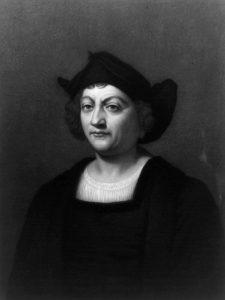
В Португалии он выгодно женился на Фелипе Монис де Палестрелло, которая была дочерью губернатора этой страны. Бракосочетание состоялось в 1479 г., через год родился их сын, которого называли Диего. Колумб перевез жену в Геную, а сам и дальше продолжал путешествовать.
До 1485 г. Колумб «ходил» на португальских судах, занимался торговлей и самообразованием, увлекся составлением карт. В 1483 г. у него уже был готов новый проект морского торгового пути в Индию и Японию. Мысль о возможности такого плаванья выражали Аристотель и Сенека, Плиний Старший, Страбон и Плутарх, а в средние столетия теория Единого Океана была освящена церковью. Ее признавали арабский мир и его великие географы: Масуди, ал-Бируни, Идриси.
Колумбу удалось представить свой план королю Португалии Жуану II. Но, видно, его время еще не настало, или ему не удалось аргументированно убедить монарха в необходимости снаряжения экспедиции. После 2-х лет раздумий король отверг это предприятие, а дерзкий моряк попал в опалу. Тогда Колумб перешел на испанскую службу.
Переезд в Испанию
В Испании Колумб находит работу в монастыре, заводит роман с другой женщиной. Первая жена Колумба не прожила долго, хотя дата её смерти точно не установлена. Второй супругой Колумба стала Беатрис Энрикес де Арана. В этом браке также родился сын, получивший имя Фернандо.
Уже в 1486 г. Христофор Колумб сумел заинтриговать своим проектом влиятельного герцога Медина-Сели, который ввел небогатого, но одержимого мореплавателя в круг королевского окружения, банкиров и купцов.
В 1488 г. он получил от португальского короля приглашение к возвращению в Португалию, испанцы тоже хотели организовать экспедицию, но страна находилась в состоянии затянувшейся войны и не имела возможности выделить средства на плавание.
Прошло еще 4 года. В январе 1492 г. война завершилась, и вскоре Христофор Колумб добился разрешения от испанского короля на организацию экспедиции, но его в который раз подвел скверный характер! Требования мореплавателя были чрезмерными: назначение вице-королем всех новых земель, титул «главного адмирала океана» и большое количество денег. Король ему отказал, однако, королева Изабелла пообещала свою помощь и содействие. В итоге, 30 апреля 1492 г. король официально сделал Колумба дворянином, пожаловав ему титул «дон» и утвердив все выдвинутые требования.
Всего Колумб совершил к побережью Америки 4 плавания.
1-я экспедиция Колумба
Она состоялась 2 августа 1492 г. — 15 марта 1493 г. Целью первой испанской экспедиции, руководимой Христофором Колумбом, был поиск кратчайшего морского пути в Индию. Эта небольшая экспедиция, состоявшая из 90 человек на трех каравеллах «Санта-Мария» (исп. Santa María), «Пинта» (исп. Pinta) и «Нинья» (исп. La Niña). «Санта-Мария» — 3 августа 1492 г. отправилась в путь из Палоса (исп. Cabo de Palos). Дойдя до Канарских островов и повернув на запад, она пересекла Атлантику и открыла Саргассово море (англ. Sargasso Sea). Первой землей, увиденной среди волн, стал один из островов Багамского архипелага, названный Сан-Сальвадором (англ. San Salvador Island). На нем Колумб высадился 12 октября 1492 г. — этот день считается официальной датой открытия Америки. Далее были открыты еще ряд Багамских островов, Куба, Гаити.
В марте 1493 г. корабли вернулись в Кастилию, везя в трюмах некоторое количество золота, диковинные растения, яркие перья птиц и нескольких туземцев. Христофор Колумб объявил, что открыл западную Индию.
2-я экспедиция Колумба
25 сентября 1493 г — 11 июня 1496 г в подчинении адмирала находилось уже 17 кораблей. А численность экипажа достигала 2,5 тыс. человек. Экспедиция исследовала Гаити, где был проведен военный поход для поиска золота, а также открыты: Острова – Гваделупа, Доминикана, Малые Антильские, Поэрто-Рико, Ямайка, Хувентуд. Южные берега Кубы и Гаити.
Открыв остров Пуэрто-Рико, Колумб 22 ноября 1493 г. подплыл к Эспаньоле. Ночью суда подошли к месту, где стоял заложенный ими в первом плавании форт.
Все было тихо. На берегу не было ни одного огонька. Прибывшие дали залп из бомбард, но только эхо перекатилось вдали. Утром Колумб узнал, что испанцы своей жестокостью и жадностью так восстановили против себя индейцев, что однажды ночью те внезапно напали на крепость и сожгли ее, перебив насильников. Так новая земля встретила Колумба во время его второго плавания!
Вторая экспедиция Колумба была неудачной: открытия были незначительными; несмотря на тщательные поиски, золота нашли мало; в опять построенной колонии Изабелла свирепствовали болезни.
После второго плавания Колумб отчитывался перед государями Испании и утверждал, что нашел новый путь в Азию. Новые земли были провозглашены собственностью испанской короны. Началась их колонизация, на территории и острова перевозили уголовников, поскольку вольные поселенцы не хотели работать в колониях. Последствия были печальными – разрушены, разграблены, а потом и уничтожены древние империи ацтеков, инков, майя.
3-я экспедиция Колумба
Третья исследовательская экспедиция состоялась 30 мая 1498 г. — 25 ноября 1500 г. В плавание двинулось всего 6 судов. 31 июля был открыт остров Тринидад (исп. Trinidad), затем залив Пария (исп. Golfo de Paria), полуостров Пария и устье реки Ориноко (исп. Río Orinoco). 15 августа экипаж обнаружил остров Маргарита (исп. Isla Margarita).
Испанская королевская казна почти не получала доходов от своей новой колонии, а в это время португалец Васко да Гама открыл морской путь в настоящую Индию (1498) и вернулся с грузом пряностей, доказав таким образом, что земли, открытые Колумбом, — совсем не Индия, а сам он — обманщик.
В 1499 монопольное право Колумба на открытие новых земель было отменено. В 1500 королевская чета направила на Эспаньолу с неограниченными полномочиями своего представителя Франсиско де Бобадилью. Тот взял в свои руки всю власть на острове, арестовал Христофора Колумба вместе с братьями, заковал их в кандалы и отправил в Испанию.
В заключении Колумб просидел недолго, но, получив свободу, он лишился многих привилегий и большей части своих богатств — это стало самым большим разочарованием в жизни мореплавателя.
4-я, последняя экспедиция Колумба
9 мая 1502 г. — ноябрь 1504 г. Мореплавателю не давало покоя то, что в течение стольких лет, не был найден западный путь в Индию. Флотилия из четырех небольших каравелл (140–150 чел.) отплыла из Кадиса. Зайдя на Канарские острова, она 25 мая вышла в открытый океан и 15 июня достигла острова Матининьо, который Колумб переименовал в Мартинику. Пройдя мимо берегов Эспаньолы и обогнув Ямайку с юга, корабли подошли к островам Хардинес-де-ла-Рейна («Сады Королевы»), а затем круто повернули на юго-запад. За три дня (27–30 июля) они пересекли Карибское море и достигли архипелага Ислас-де-ла-Баия и земли, которой адмирал дал имя Гондурас («Глубины») из-за больших прибрежных глубин. Так была открыта Центральная Америка.
Взяв сначала курс на восток, Колумб обогнул м.Грасьяс-а-Дьос («Благодарение Богу») и поплыл на юг вдоль берегов Никарагуа, Коста-Рики и Панамы. Узнав от панамских индейцев о лежащей на западе богатейшей стране Сигуаре и большой реке, он решил, что это и Индия и река Ганг. 6 января 1503 корабли встали у устья р.Белен и в марте основали там небольшое поселение Санта-Мария. Однако уже в первой половине апреля им пришлось покинуть его из-за нападения индейцев. При отступлении они бросили одну каравеллу.
Двинувшись затем на восток вдоль панамского побережья, флотилия в конце апреля дошла до Дарьенского залива и берегов современной Колумбии, а 1 мая от мыса Пунта-де-Москитас повернула на север и 12 мая достигла о-вов Хардинес-де-ла-Рейна. Из-за плачевного состояния судов Колумб смог довести их только до северного берега Ямайки (25 июня). Затем мореплаватели были вынуждены провести целый год в бухте Санта-Глория (совр. Сент-Аннс).
От неминуемой гибели их спас волонтер Д.Мендес, которому удалось на двух каноэ добраться до Санто-Доминго и прислать оттуда каравеллу. 13 августа 1504 спасенные прибыли в столицу Эспаньолы. 12 сентября Колумб отплыл на родину и 7 ноября высадился в Сан-Лукаре.
Последние годы
В начале 1505 Колумб окончательно отказался от дальнейших планов морских экспедиций. Последние полтора года жизни он посвятил борьбе за восстановление его в должности вице-короля Индий и удовлетворение финансовых претензий, однако добился лишь частичной денежной компенсации.
До самой смерти он оставался в убеждении, что открытые им земли являлись частью Азиатского материка, а не новым континентом.
Колумб умер 20 мая 1506 в Вальядолиде, где и был похоронен. Интересной является судьба останков Колумба, которые из Испании перевезли на Гаити. Когда испанцы ушли с острова, то прах великого мореплавателя перевезли в Гавану, а оттуда – в Санта-Доминго, а затем – Севилью. Долгое время считалось, что останки покоятся в кафедральном соборе Севильи, но генетические исследование доказали обратное. Было установлено, что кости принадлежат другом человеку в возрасте 45 лет. Колумбу же на момент смерти было около 60 лет. Где находятся сейчас останки мореплавателя, никто из историков не знает.
Итоги жизни
Как оценивал Колумб свою жизнь -сложно предположить. Однако, он так и не сумел добраться до берегов сказочно богатой Индии, а ведь именно это было его сокровенной мечтой. Он даже не понял, что открыл. А континенты, увиденные впервые именно им, получили имя другого человека — Америго Веспуччи (итал. Amerigo Vespucci), который просто продлил проторенные великим генуэзцем тропы.
Христофор Колумб не был первооткрывателем Америки: острова и побережье Северной Америки посещались норманнами за сотни лет до него. Однако только открытия Колумба имели всемирно-историческое значение.
Имя Колумба носит государство Колумбия в Южной Америке, Колумбийское плато и река Колумбия в Северной Америке, федеральный округ Колумбия в США и провинция Британская Колумбия в Канаде; в США есть пять городов с названием Колумбус и четыре с названием Колумбия.
Биография Христофора Колумба
26 Августа 1451 – 20 Мая 1506 гг. (54 года)
4.4
Средняя оценка: 4.4
Всего получено оценок: 1694.
Христофор Колумб (1451–1506 гг.) – испанский мореплаватель, открывший Америку и близлежащие острова. Первый из путешественников, который пересек Атлантический океан. Совершил четыре экспедиции в тщетных попытках отыскать западный, более короткий путь в Индию. Его именем названа страна в Южной Америке — Колумбия.
Опыт работы учителем географии — 35 лет.
Молодость. Первые плавания
Христофор Колумб родился между 26 августа и 31 октября 1451 года на острове Корсика в Генуэзской республике. Образование будущий открыватель получил в Павийском университете.
Краткая биография Колумба не сохранила точных свидетельств о его первых плаваниях, однако известно, что в 1470-х годах он совершал морские экспедиции с торговыми целями. Уже тогда у Колумба возникла идея путешествия в Индию через запад. Мореплаватель много раз обращался к правителям европейских стран с просьбой помочь ему организовать экспедицию к королю Жуану ІІ, герцогу Медина-Сели, королю Генриху VII и другим. Лишь в 1492 году путешествие Колумба было одобрено испанскими правителями, прежде всего, королевой Изабеллой. Ему был присвоен титул «дона», обещаны вознаграждения в случае удачного проведения проекта.
Четыре экспедиции. Открытие Америки
В 1492 году было совершено первое плавание Колумба. Во время путешествия мореплавателем были открыты Багамские острова, Гаити, Куба, хотя сам он считал эти земли «Западной Индией».
Во время второй экспедиции среди помощников Колумба были такие известные личности как будущий завоеватель Кубы Диего Веласкес де Куэльяр, нотариус Родриго де Бастидас, первопроходец Хуан де ла Коса. Тогда открытия мореплавателя включали Виргинские, Малые Антильские острова, Ямайку, Пуэрто-Рико.
Третья экспедиция Христофора Колумба была совершена в 1498 году. Главным открытием мореплавателя был остров Тринидад. Однако в это же время Васко-да-Гама нашел настоящий путь в Индию, поэтому Колумб был объявлен обманщиком и отправлен под конвоем из Эспаньолы в Испанию. Тем не менее, по его прибытию местным финансистам удалось уговорить короля Фердинанда II снять обвинения.
Колумба не покидала надежда открыть новый краткий путь к Южной Азии. В 1502 году мореплаватель смог добиться разрешения короля на четвертое путешествие. Колумб достиг берега Центральной Америки, доказав, что между Атлантическим океаном и Южным морем лежит материк.
Последние годы
Во время последнего путешествия Колумб тяжело заболел. По возвращению в Испанию ему не удалось восстановить дарованные ему привилегии и права. Умер Христофор Колумб 20 мая 1506 года в Севилье в Испании. Мореплаватель был сначала похоронен в Севилье, однако в 1540 году, по приказу императора Карла V останки Колумба были перевезены на остров Эспаньола (Гаити), а в 1899 году снова в Севилью.
Другие варианты биографии
Более сжатая для доклада или сообщения в классе
Вариант 2
Интересные факты
- Историкам до сих пор не известна подлинная биография Христофора Колумба – фактических материалов о его судьбе и экспедициях так мало, что биографы мореплавателя вносят в его жизнеописание множество выдуманных утверждений.
- Вернувшись в Испанию после второй экспедиции, Колумб предложил селить на недавно открытые земли преступников.
- Предсмертными словами Колумба были: «In manus tuas, Domine, commendo spiritum meum» («В твои руки, Господи, я вручаю мой дух»).
- Значение открытий мореплавателя было признано только в середине XVI века.
Тест по биографии
Биография запомнится лучше, если попытаетесь ответить на вопросы теста:
Доска почёта

Чтобы попасть сюда — пройдите тест.
-
Мария Вощенко
10/11
-
Анна Полянская
11/11
-
Наталия Ворошилова
11/11
-
Ирина Стрелкова
11/11
-
Соня Коваль
9/11
-
Татьяна Коваль
7/11
-
Сергей Волков
8/11
-
Людмила Перес
11/11
-
Светик Жемчугова
11/11
-
Дмитрий Желтухин
9/11
Оценка по биографии
4.4
Средняя оценка: 4.4
Всего получено оценок: 1694.
А какая ваша оценка за эту биографию?
Биография
Христофор Колумб – средневековый мореплаватель, открывший Саргассово и Карибское моря, Антильские, Багамские острова и Американский континент для европейцев, первым из известных путешественников, переплывший Атлантический океан.
По разным свидетельствам, Христофор Колумб родился в 1451 году в Генуе, на территории нынешней Корсики. Шесть итальянских и испанских городов претендуют на право зваться его родиной. О детстве и юности мореплавателя достоверно неизвестно практически ничего, так же смутно и происхождение семейства Колумбов.
Некоторые исследователи называют Колумба итальянцем, другие считают, что его родители были крещеными евреями, марранами. Это предположение объясняет невероятный по тем временам уровень образования, которое получил Христофор, выходец из семьи обычного ткача и домохозяйки.
Согласно некоторым историкам и биографам, Колумб до 14 лет учился на дому, при этом имел блестящие познания в математике, знал несколько языков, включая латынь. У мальчика было три младших брата и сестра, и все они обучались приходящими учителями. Один из братьев, Джованни, умер еще в детстве, сестра Бьянкелла выросла и вышла замуж, а Бартоломео и Джакомо сопровождали Колумба в его странствиях.
Скорее всего, Колумбам посильную помощь оказывали собратья по вере, богатые генуэзские финансисты из марранов. С их помощью юноша из небогатой семьи попал в университет города Падуя.
Будучи образованным человеком, Колумб был знаком с учениями древнегреческих философов и мыслителей, изображавших Землю шаром, а не плоским блином, как считали в Средневековье. Однако такие мысли, как и еврейское происхождение во времена инквизиции, которая свирепствовала в Европе, следовало тщательно скрывать.
В университете Колумб сдружился со студентами и преподавателями. Одним из его близких приятелей стал астроном Тосканелли. По его расчетам выходило, что до заветной Индии, полной несметных богатств, гораздо ближе плыть в западном направлении, а не в восточном, огибая Африку. Позже Христофор провел собственные расчеты, которые, будучи неверными, подтвердили гипотезу Тосканелли. Так родилась мечта о западном путешествии, и ей Колумб посвятил всю жизнь.
Еще до поступления в университет четырнадцатилетним подростком Христофор Колумб испытал тяготы морских странствий. Отец устроил сына на одну из торговых шхун для обучения искусству навигации, навыкам торговли, и с этого момента стартовала биография Колумба-мореплавателя.
Первые плавания Колумб в должности юнги совершил по Средиземному морю, где пересекались торгово-экономические пути между Европой и Азией. При этом о богатствах и золотых россыпях Азии и Индии европейские купцы знали со слов арабов, которые перепродавали им чудесные шелка и пряности из этих стран.
Юноша слушал необычайные истории из уст восточных купцов и воспылал мечтой достичь берегов Индии, дабы найти ее сокровища и разбогатеть.
Экспедиции
В 70-х годах 15 века Колумб женился на Фелипе Мониш из богатой итало-португальской семьи. Тесть Христофора, поселившегося в Лиссабоне и ходившего в море под португальским флагом, также был мореплавателем. После смерти он оставил морские карты, дневники и другие документы, перешедшие по наследству к Колумбу. По ним путешественник продолжил изучение географии, одновременно штудируя труды Пикколомини, Пьера де Айльи, Марко Поло.
Христофор Колумб принял участие в так называемой северной экспедиции, в составе которой его путь проходил через Британские острова и Исландию. Предположительно, там мореплаватель и услышал скандинавские саги и истории о викингах, Эрике Рыжем и Лейве Эрикссоне, которые достигли побережья «Большой земли», переплыв Атлантический океан.
Маршрут, позволявший добраться до Индии западным путем, Колумб составил еще в 1475 году. Он представил честолюбивый план покорения новой земли на суд генуэзских купцов, однако поддержки не встретил.
Спустя несколько лет, в 1483 году, Христофор обращается с аналогичным предложением к португальскому королю Жуану II. Король собрал ученый совет, который рассмотрел проект генуэзца и нашел его расчеты неверными. Расстроенный, но неунывающий Колумб уехал из Португалии и перебрался в Кастилию.
В 1485 году мореплаватель испросил аудиенции у испанских монархов, Фердинанда и Изабеллы Кастильской. Супруги приняли его благосклонно, выслушали прельщавшего их сокровищами Индии Колумба и так же, как португальский правитель, созвали ученых на совет. Комиссия не поддержала мореплавателя, поскольку возможность западного пути подразумевала шарообразность Земли, что противоречило учению церкви. Колумба едва не объявили еретиком, однако король с королевой смилостивились и решили отложить окончательное решение до завершения войны с маврами.
Колумб, которым двигала не столько жажда открытий, сколько желание разбогатеть, старательно скрывая детали намечающегося путешествия, отправил послания английскому и французскому монархам. Карл и Генрих не ответили на письма, будучи слишком занятыми внутренней политикой, зато португальский король прислал мореплавателю приглашение продолжить обсуждение экспедиции.
Когда Христофор заявил об этом в Испании, Фердинанд и Изабелла дали согласие на снаряжение эскадры кораблей для поиска западного пути в Индию, хотя нищая испанская казна не имела средств для этого предприятия. Монархи пообещали Колумбу дворянский титул, звания адмирала и вице-короля всех земель, которые ему предстоит открыть, а деньги ему пришлось брать взаймы у андалусских банкиров и купцов.
Четыре экспедиции Колумба
- Первая экспедиция Христофора Колумба состоялась в 1492-1493 годах. На трех кораблях, каравеллах «Пинта» (собственность Мартина Алонсо Пинсона) и «Нинья» и четырехмачтовом паруснике «Санта-Мария» мореплаватель прошел через Канарские острова, пересек Атлантический океан, открыв по пути Саргассово море, и достиг Багамских островов. 12 октября 1492 года Колумб ступил на землю острова Саман, названного им Сан-Сальвадор. Эта дата считается днем открытия Америки.
- Вторая экспедиция Колумба состоялась в 1493-1496 годах. В этом походе были открыты Малые Антильские острова, Доминика, Гаити, Куба, Ямайка.
- Третья экспедиция относится к периоду с 1498 по 1500 год. Флотилия из шести судов достигла островов Тринидад и Маргарита, положив начало открытию Южной Америки, и завершилась на Гаити.
- В ходе четвертой экспедиции Христофор Колумб приплыл на Мартинику, побывал в Гондурасском заливе и обследовал побережье Центральной Америки вдоль Карибского моря.
Открытие Америки
Процесс открытия Нового Света растянулся на много лет. Самое удивительное, что Колумб, будучи убежденным первооткрывателем и опытным мореплавателем, до конца своих дней верил, что открыл путь в Азию. Багамские острова, открытые в первой экспедиции, он считал частью Японии, вслед за которой должен был открыться чудесный Китай, а за ним – и заветная Индия.
Что же открыл Колумб и почему новый континент получил имя другого путешественника, Америго Веспуччи? В перечень открытий, совершенных великим путешественником и мореплавателем, входят Сан-Сальвадор, Куба и Гаити, относящиеся к Багамскому архипелагу, Саргассово море.
Во вторую экспедицию отправились семнадцать кораблей во главе с флагманом «Марией-Галанте». Этот тип судна водоизмещением в двести тонн и другие корабли везли не только моряков, но и колонизаторов, скот, припасы. Все это время Колумб был убежден, что открыл Западную Индию. Тогда же были открыты Антильские острова, Доминика и Гваделупа.
Третья экспедиция привела корабли Колумба к континенту, но мореплаватель был разочарован: Индии с ее золотыми россыпями он так и не нашел. Из этого путешествия Колумб возвращался в кандалах, обвиненный по ложному доносу. Перед входом в порт оковы с него сняли, но обещанные титулы и звания мореплаватель утерял.
Последнее путешествие Христофора Колумба завершилось крушением у берегов Ямайки и тяжелой болезнью руководителя похода. Домой он вернулся больным, несчастным и сломленным неудачами. Америго Веспуччи был близким соратником и последователем Колумба, предпринявшим четыре путешествия в Новый Свет. Его именем назван целый континент, а именем Колумба, так и не достигшего Индии, одна страна в Южной Америке.
Личная жизнь
Если верить биографам Христофора Колумба, первым из которых был его собственный сын, мореплаватель был женат дважды. Первый брак с Фелипе Мониш был законным. Жена родила сына Диего. В 1488 году у Колумба родился второй сын Фернандо, от связи с женщиной по имени Беатрис Энрикес де Арана.
Мореплаватель равно заботился об обоих сыновьях, а младшего даже взял с собой в экспедицию, когда мальчику исполнилось тринадцать лет. Фернандо стал первым, кто написал биографию знаменитого путешественника.
Впоследствии оба сына Колумба стали влиятельными людьми и заняли высокие посты. Диего был четвертым вице-королем Новой Испании и адмиралом Индии, а его потомки были титулованными маркизами Ямайки и герцогами Верагуа.
Фернандо Колумб, ставший писателем и ученым, пользовался благосклонностью испанского императора, жил в мраморном дворце и имел годовой доход до 200000 франков. Эти титулы и богатства достались потомкам Колумба в знак признания испанскими монархами его заслуг перед короной.
Смерть
После открытия Америки из последней экспедиции Колумб вернулся в Испанию смертельно больным, постаревшим человеком. В 1506 году первооткрыватель Нового Света скончался в бедности в маленьком домике в Вальядолиде. Сбережения Колумб потратил на оплату долгов участникам последней экспедиции.
Вскоре после смерти Христофора Колумба из Америки стали приходить первые корабли, груженые золотом, о котором так мечтал мореплаватель. Многие историки сходятся во мнении, что Колумб знал, что открыл не Азию и не Индию, а новый, неизведанный континент, но не хотел ни с кем делиться славой и сокровищами, до которых оставался один шаг.
Внешность предприимчивого первооткрывателя Америки известна еще по фото в учебниках истории. О Колумбе снято несколько картин, последним вышел фильм совместного производства Франции, Англии, Испании и США «1492: Завоевание Рая». Памятники этому великому человеку установлены в Барселоне и Гранаде, а его прах из Севильи перевезен на Гаити.
















